Rome is the capital city of Italy and one of the largest cities in Europe. With its long, rich history, famous landmarks, museums and archaeological sites, the to-do list for visitors is enormous. 30 things to do in Rome sounds like a lot, and it is, but there are many more places we could have added to this list.
So far, we have visited Rome twice. The first time was a quick visit, the start of our one year trip around the world. We only had a few days in the city, and Tyler and Kara were kids at the time. We had just enough time to visit a few must-see sights and learn that this city has an incredibly long list of places to visit.
On our most recent visit, we spent four more days in Rome, using this time to revisit a few places and to venture off the beaten path. One of our favorite experiences was ending the day with an aperitivo at a rooftop bar. If you want to elevate your experience in Rome, the rooftop bars and restaurants are incredible, as you will see later in this guide.
Below is a big list of things to do in Rome. Don’t expect to see them all on your first visit, not unless you are planning to spend at least a week here. Most likely, you don’t have that kind of time, so this list starts with top 10 experiences in Rome. We then go on to list more things to do in Rome, for those with lots of time.
Top 10 Things to Do in Rome
This list starts with the very best things to do in Rome. These are the essential experiences to have, particularly if it is your first visit to Rome.
1. Colosseum
Completed in 80 AD, this is the largest amphitheater that was ever built at the time. It could hold up to 80,000 people, spectators who were drawn here to watch gladiatorial contests, executions, animal hunts, and re-enactments of famous battles. It is one of the seven New Wonders of the World.
On a visit to the Colosseum, there are several ticket types. The basic ticket gives you access to the main area of the Colosseum, plus the Roman Forum and Palatine Hill. You can also add on the Arena Floor and the Underground, each for an additional price.
Adding on the Arena Floor is absolutely worth it. A platform was built over a portion of the arena, and with a ticket here, you can stand on this platform and look up at the walls of the Colosseum.
On a guided tour, you can tour the Underground and learn about the fascinating history of the Colosseum, including stories on where the animals were kept, where the gladiators waited to be released, and the inner workings of the Colosseum.
On our most recent visit to the Colosseum, we took a private, guided tour of the Colosseum with the Underground at opening time. If you want to get the full experience of visiting the Colosseum, book a tour that includes the Underground…it is one of Rome’s most interesting history lessons.
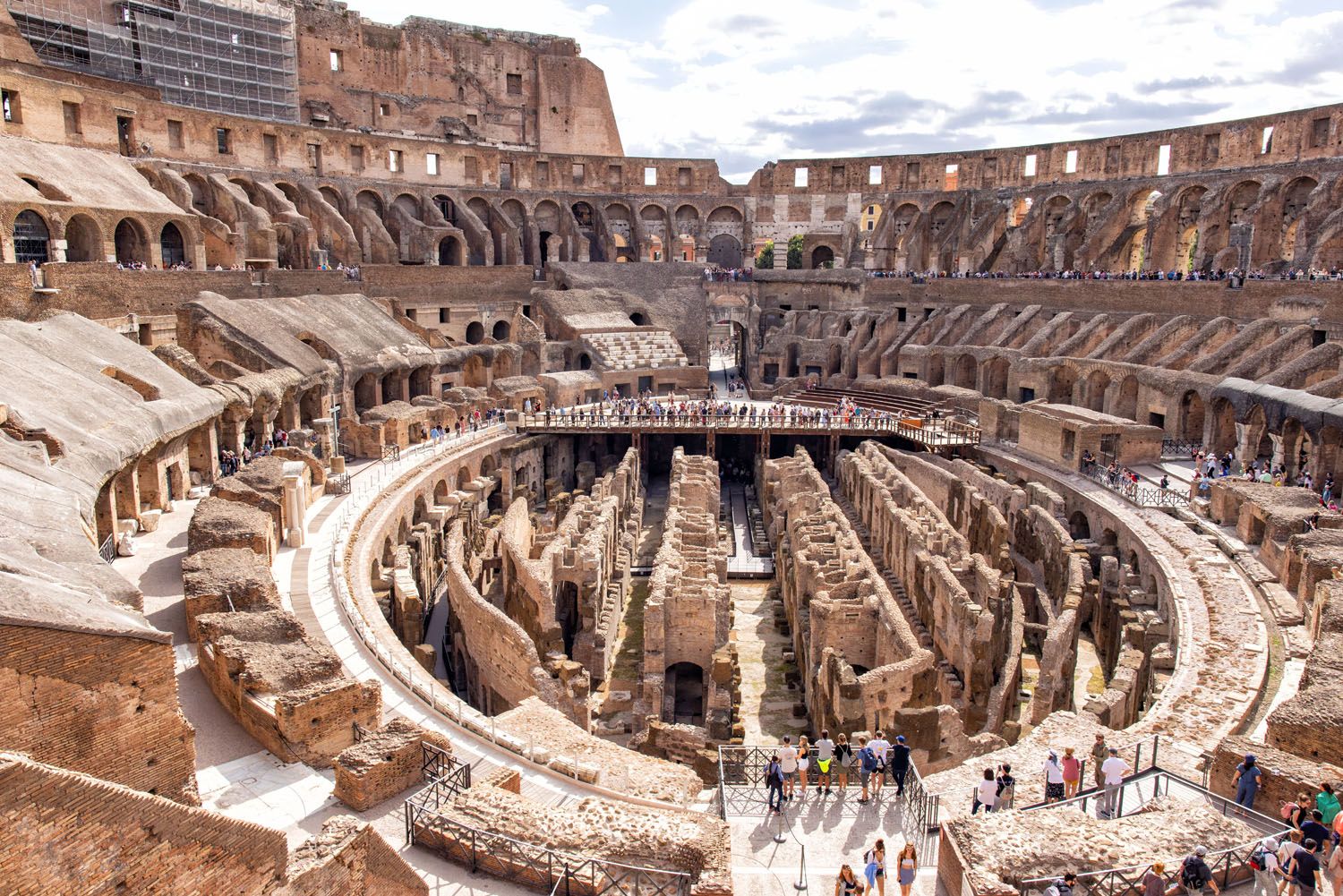
The Colosseum
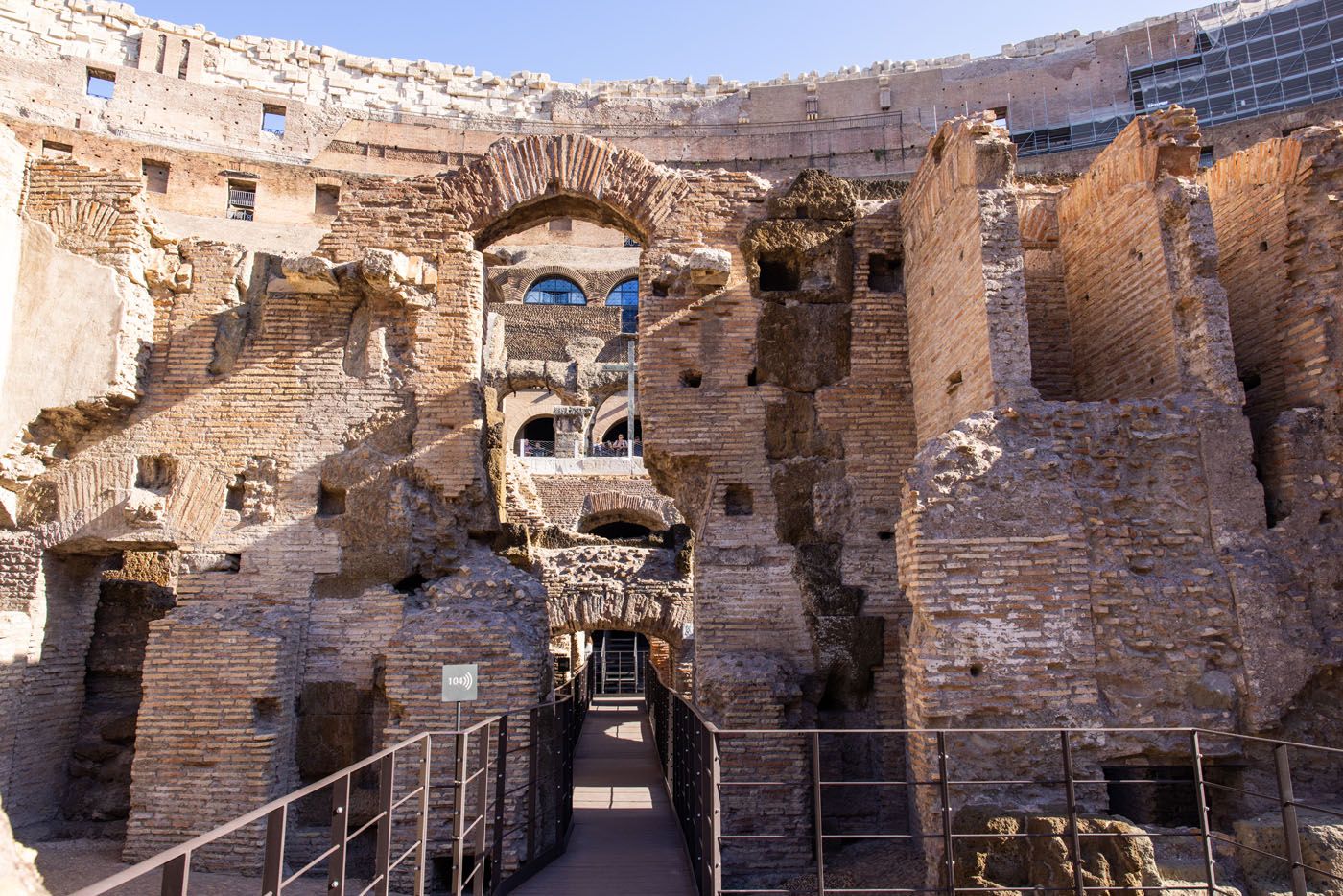
Touring the Underground
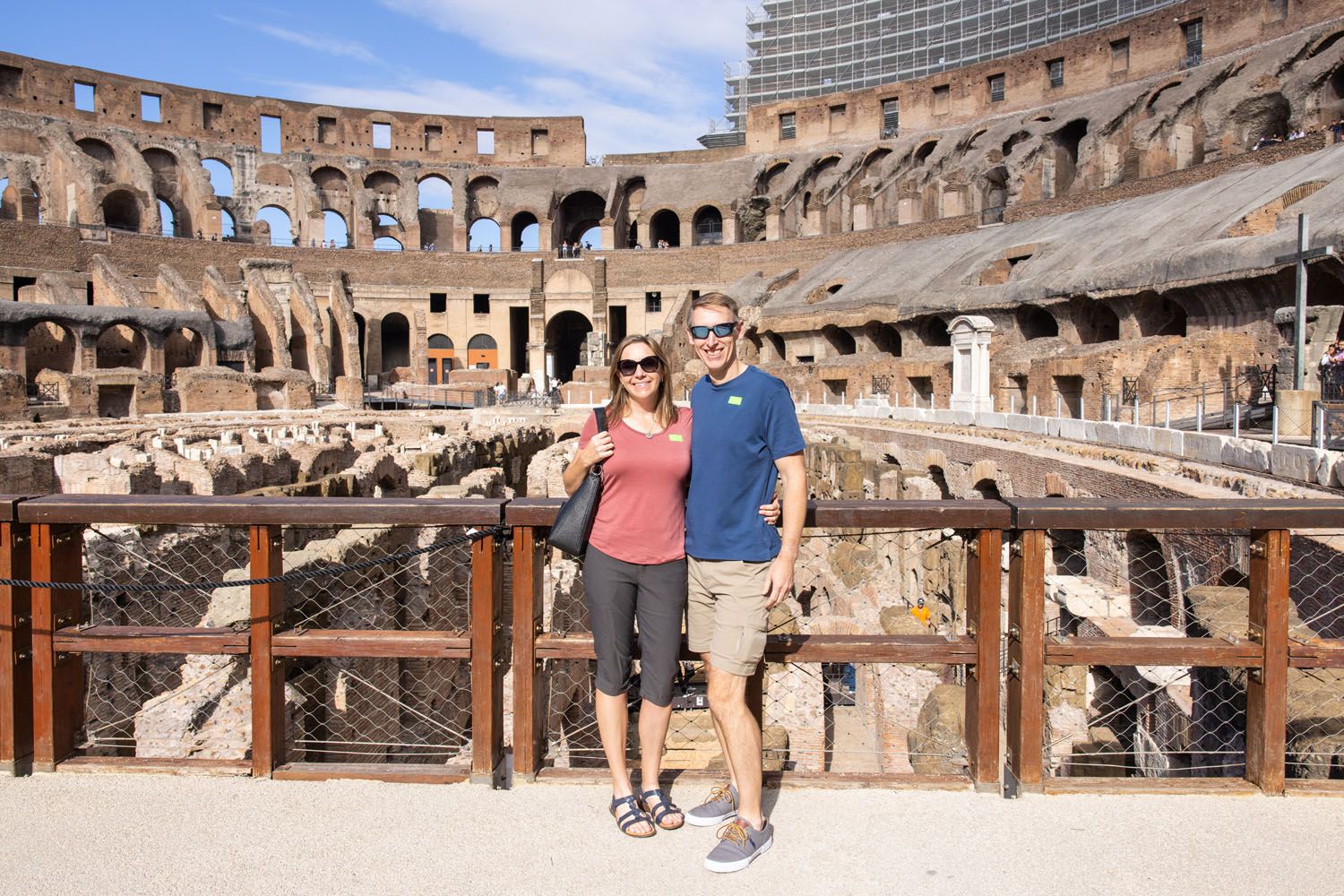
On the Arena Floor
How to Visit the Colosseum
We have a detailed guide about how to visit the Colosseum, but here are a few tips.
On your visit to the Colosseum, you can either wander through it on your own, take the audio guide tour, or join a guided tour. Most visits last 1 to 3 hours.
You must purchase your entrance ticket in advance (you cannot just show up and get in line for a ticket).
If online tickets are sold out for your dates of travel, I recommend joining a guided tour of the Colosseum. You will spend a little more money than purchasing your tickets directly from the Colosseum website, but at least you will get to visit the Colosseum.
Hours: Hours vary by season. Click here to get hours for your dates of visit (be aware that the official website frequently goes down…if so, book your tickets on GetYourGuide).
Cost: €16 (+ €2 online reservation fee) for the standard ticket that gets you in to the Roman Forum, Palatine Hill, and the Colosseum; there is also a Full Experience ticket that also includes a visit to the Colosseum arena and underground area for €24
Website: Get updated hours and pricing and purchase your tickets here.
Roma Pass: If you have the Roma Pass, you must make your reservation to visit the Colosseum in advance. There is a €2 reservation fee.
Getting Here: The closest metro stop is Colosseo. When you exit the metro station, the Colosseum will be right in front of you.
2. Roman Forum & Palatine Hill
The Roman Forum
The Roman Forum is the historical center of Rome. This is ancient Rome, a complex of government buildings, temples, and marketplaces from 2000 years ago.
The Roman Forum is located just a short walk from the Colosseum. It sits in a valley between Palatine and Capitoline Hill.
Notable things to see in the Roman Forum include the Via Sacra, the Temple of Venus, the Temple of Romulus (the bronze doors date back to 309 AD), the Temple of Antonius and Faustina and its “hanging door,” the Temple of Vesta, the Temple of Saturn, the Arch of Septimius Severus, and the Temple of Julius Caesar.
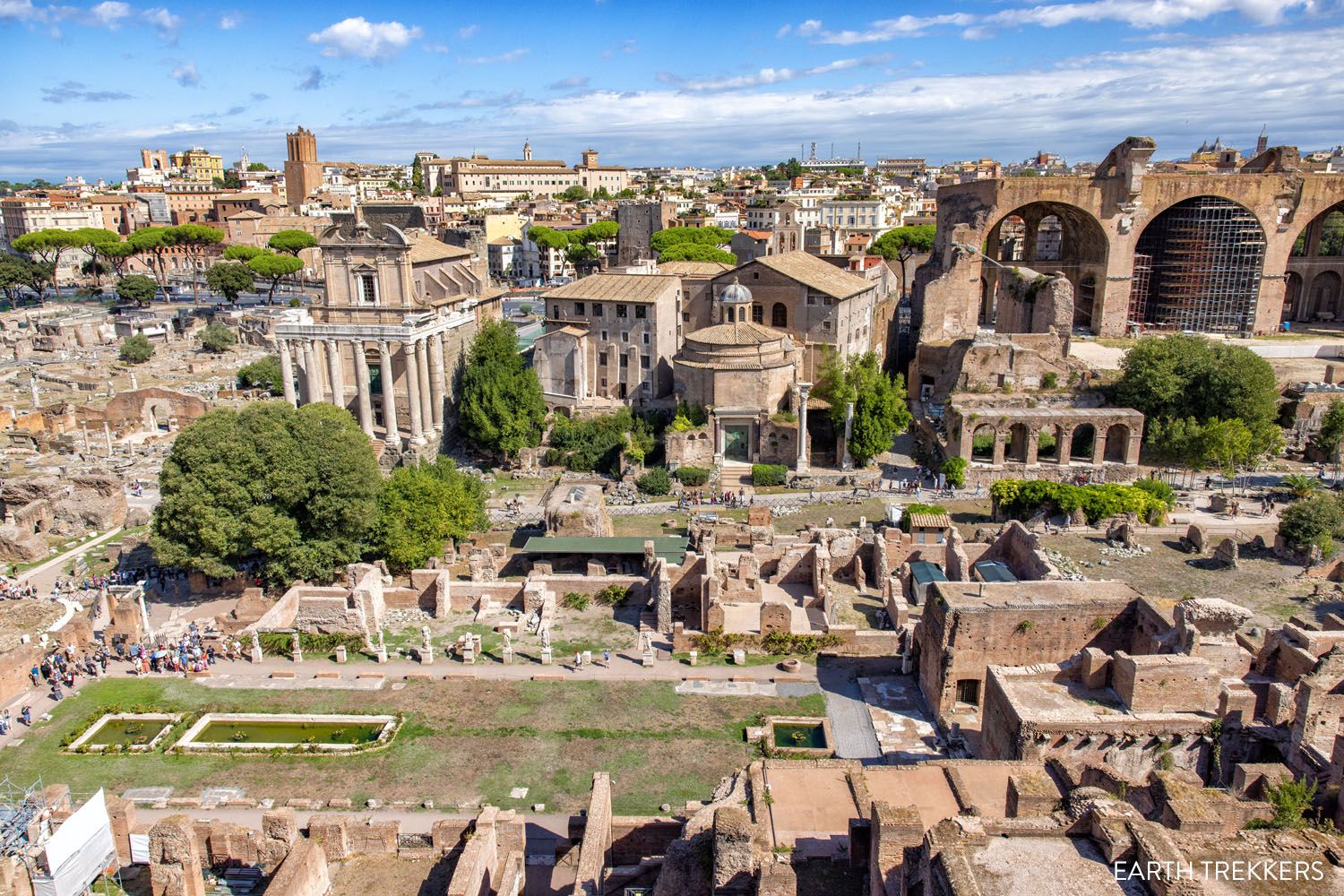
The view of the Roman Forum from Palatine Hill
Tickets to the Colosseum also include the Roman Forum and Palatine Hill. A visit here lasts anywhere from 20 minutes to an hour, depending on how many sites you visit and/or your tour.
Palatine Hill
Palatine Hill is one of the seven hills of Rome. It looms over the Roman Forum and is just a short walk from the Colosseum. Since it is included on a ticket with the Roman Forum and the Colosseum, grouping these three sites together makes the best use of your time. To visit all three, plan on spending anywhere from 3 to 5 hours, depending on how quickly you move.
We visited all three sites with a guide and I highly recommend it. It’s the best way to learn about the long history here, and to know what you are looking at.
Sitting on Palatine Hill is a complex of archaeological excavations, the remains of temples and palaces, and a museum. During the time of the Roman Republic, many imperial palaces were built here, including palaces for Augustus, Tiberius, and Domitian.
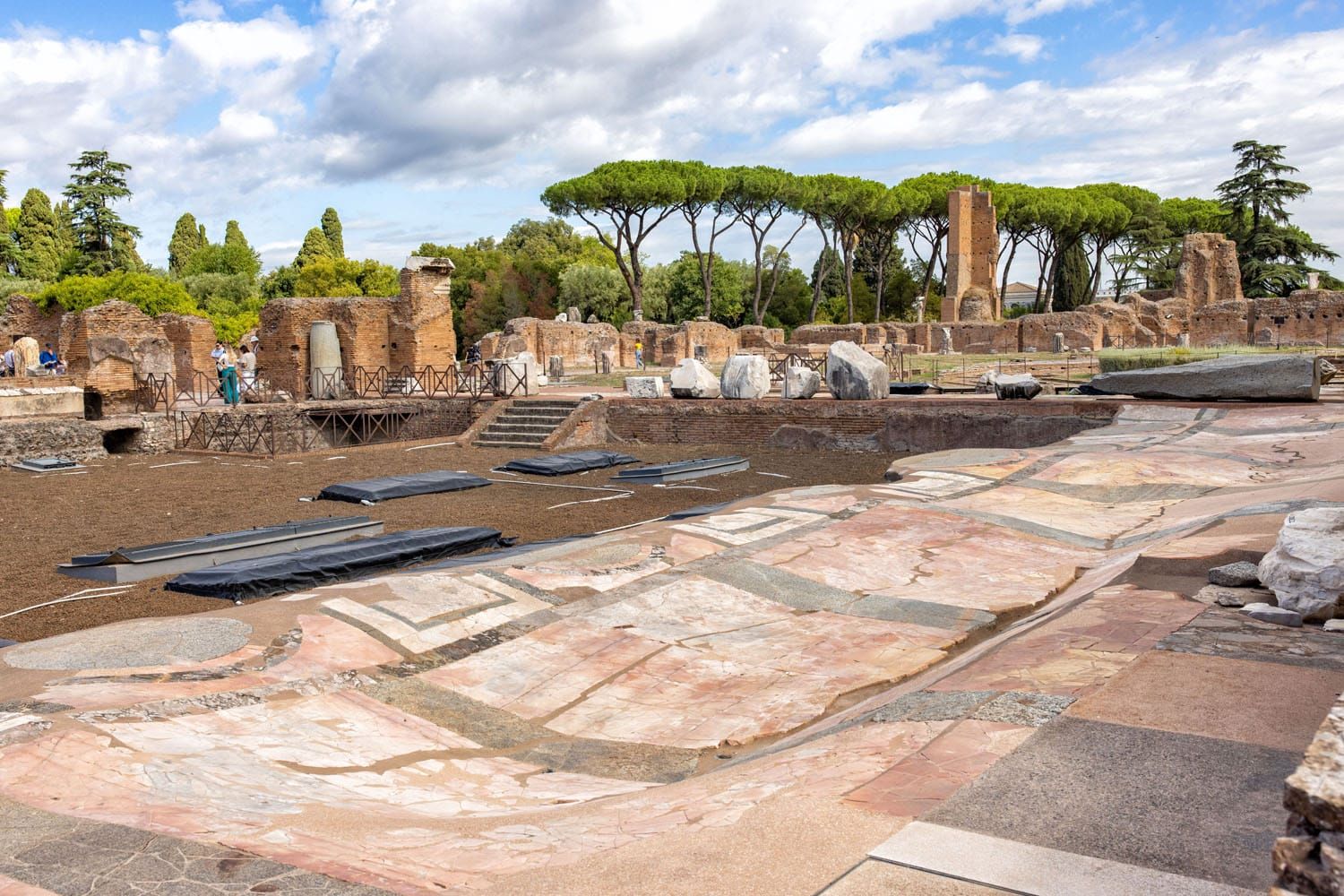
Palatine Hill
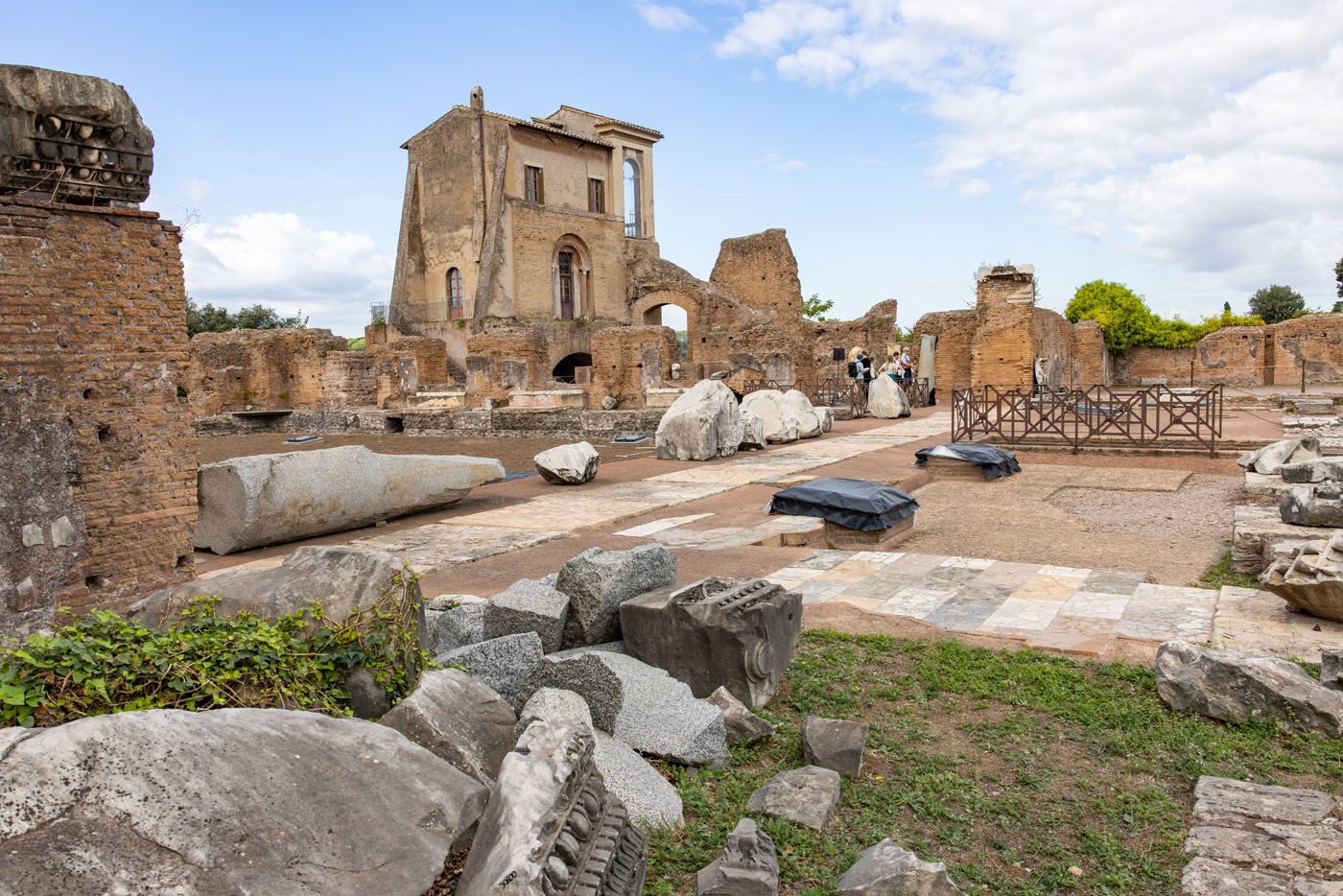
There are several sites, such as the House of Augustus, which requires an additional ticket (it is included on the S.U.P.E.R ticket).
One of the best things to do on Palatine Hill is to enjoy the view over the Roman Forum. There are two different viewpoints.
This viewpoint is lesser known. From a small terrace near Tempio della Magna Mater you look out to Capitoline Hill and a small portion of the Roman Forum. It doesn’t have a name but here are the GPS coordinates 41°53’23.8″N 12°29’05.7″E and here is the view:
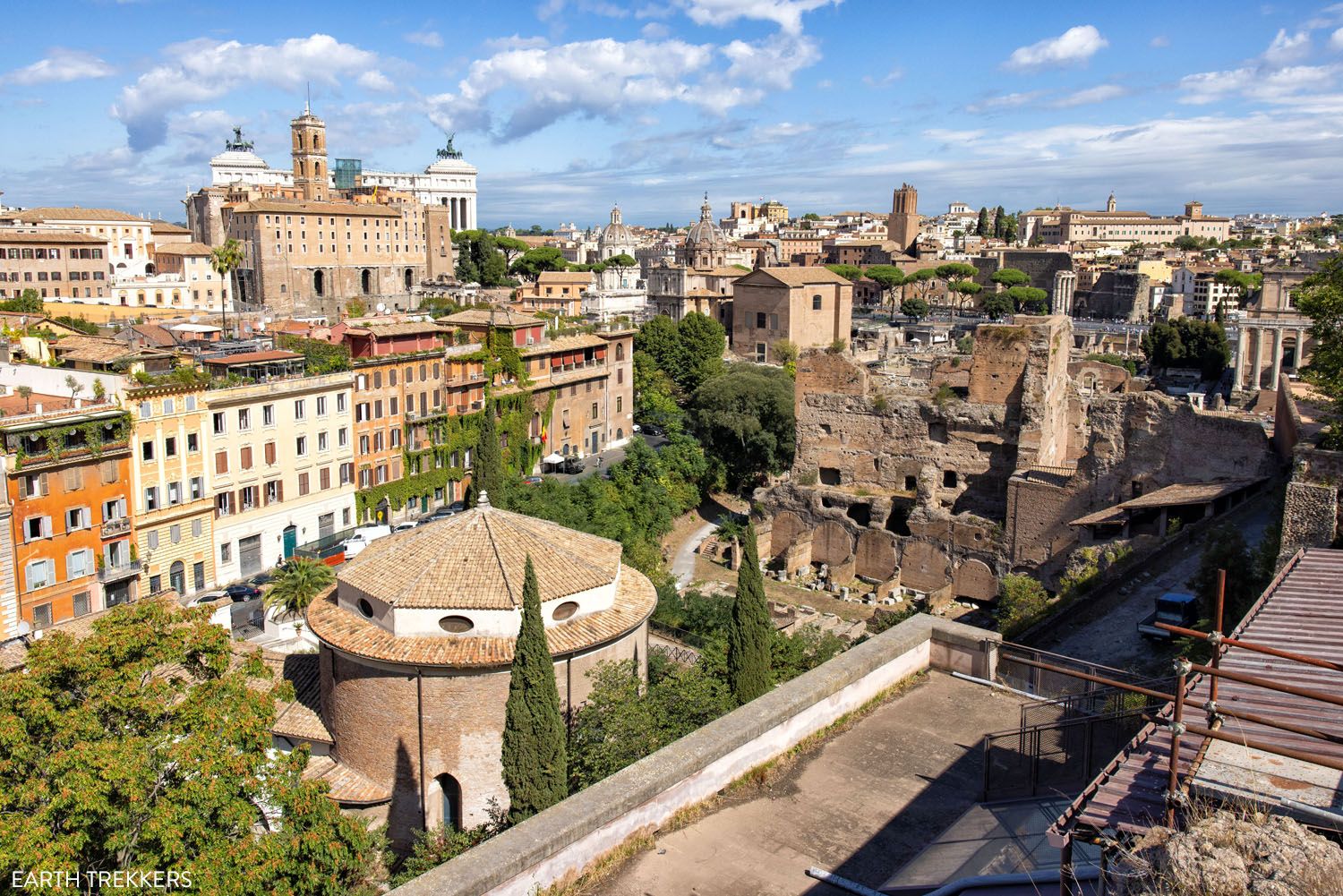
The view from Palatine Hill
From Terrazza Belvedere del Palatino, you get a bird’s eye view of the Roman Forum and the Colosseum. It’s one of the best views in Rome. Here is the view:
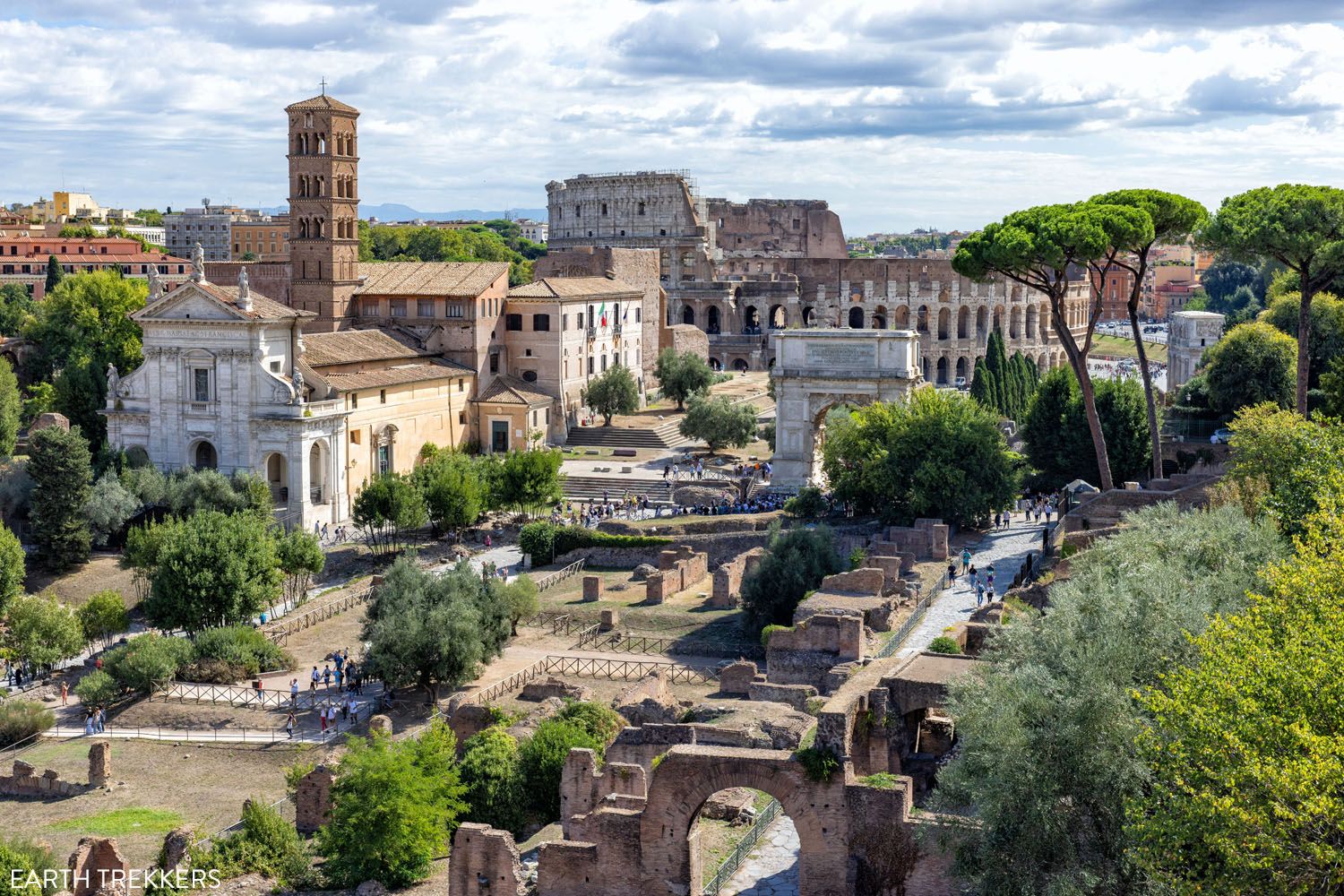
The view from Terrazza Belvedere del Palatino
HOW TO VISIT THE ROMAN FORUM & PALATINE HILL: Tickets to the Colosseum also include the Roman Forum and Palatine Hill. A visit here lasts anywhere from 30 minutes to an hour, depending on how many sites you visit and/or your tour. It is helpful to take a guided tour of Roman Forum. There are many ancient sites to visit and without a knowledgeable guide, it’s hard to know the importance of each site.
3. Vatican City: The Vatican Museums & St. Peter’s Basilica
WHAT IS VATICAN CITY?: There are three big sites to visit in Vatican City: the Vatican Museums, the Sistine Chapel, and St. Peter’s Basilica.
On a visit to Vatican City, you will visit these sites as two different sections. The Vatican Museums and Sistine Chapel are visited on one ticket. You will enter the Sistine Chapel through the Vatican Museums, so if you only want to see the Sistine Chapel, you will have to walk through the Vatican Museums first.
St. Peter’s Basilica and St. Peter’s Square is the second area you will visit. It is free to enter St. Peter’s Basilica but there is a line to get through security, and from mid-morning through mid-afternoon, this line can be enormous.
Here is an overview of each area.
Vatican Museums & Sistine Chapel
The Vatican Museums display a massive collection of art that was amassed by the Catholic Church. There are 70,000 works of art on display, in various rooms and corridors of this maze of a museum.
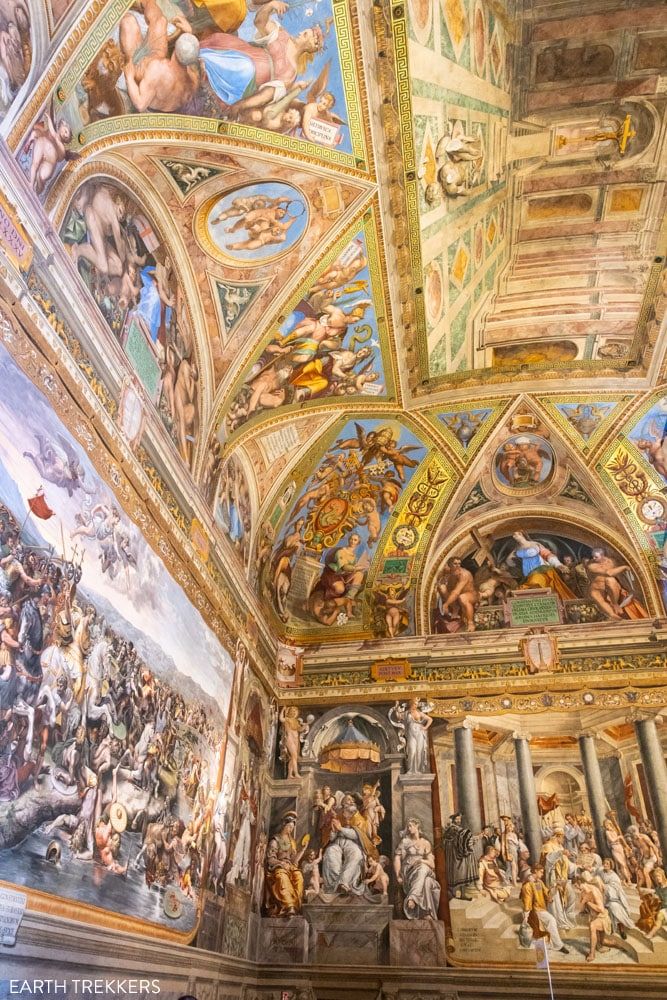
Room of the Immaculate Conception
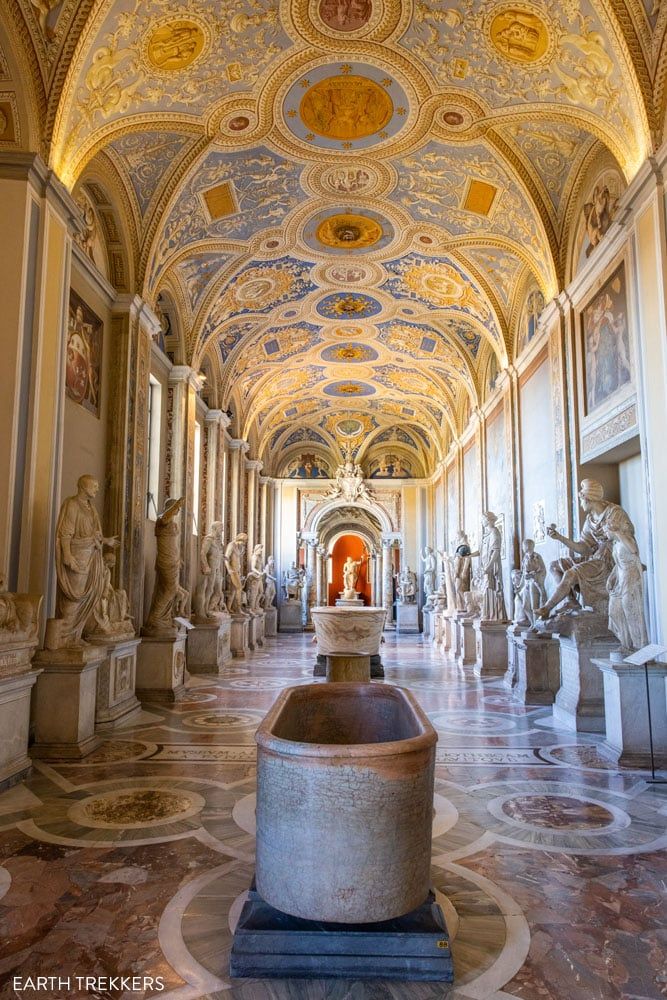
Gallery of Statues and the Hall of Busts
On a visit to the Vatican Museums, you can add on a few rooms that are closed to the general public (sometimes called the “secret rooms” of the Vatican). The Cabinet of Masks has mosaics from Emperor Hadrian’s Villa, statues of Aphrodite and Nymph, and the Dung Chair.
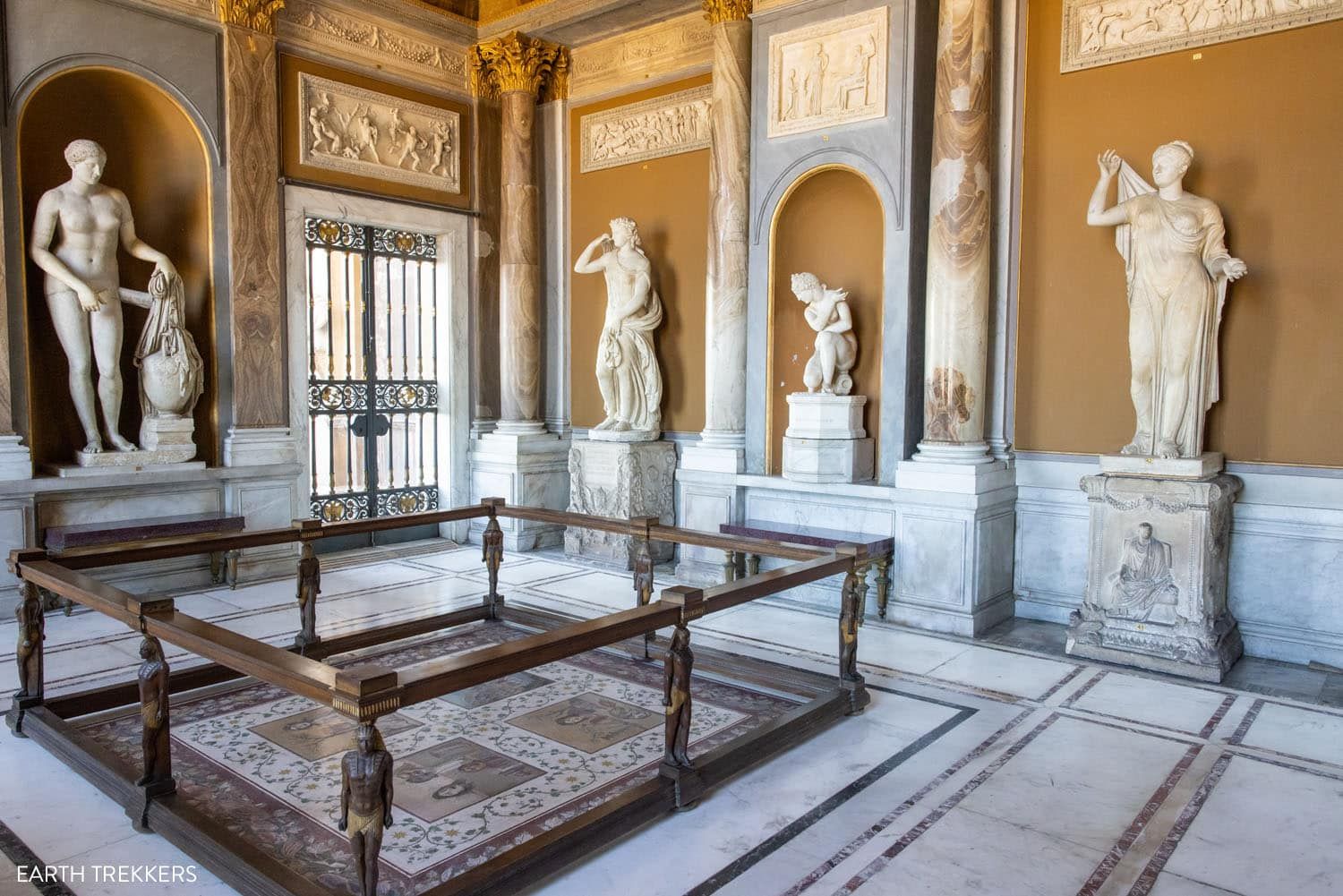
Cabinet of Masks Vatican
You also have the option to add on the original Bramante Staircase. It was built in 1505 by Donato Bramante as a double helix. Its purpose was to allow people and animals to ascend to the Belvedere palace of Pope Innocent VIII.
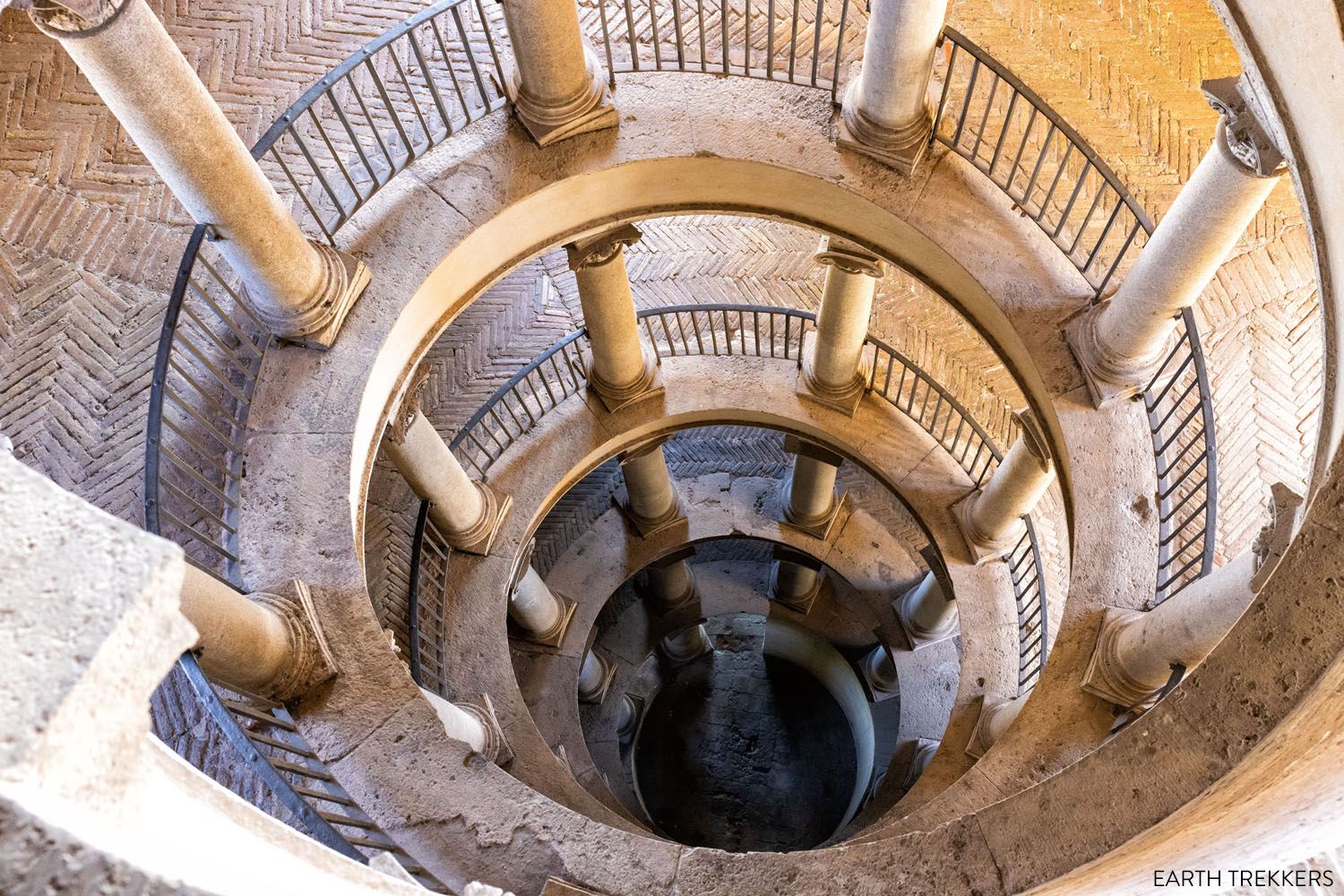
The original Bramante Staircase
The design of the modern staircase, which is also a double helix and how visitors exit the museum, was inspired by the original Bramante Staircase.
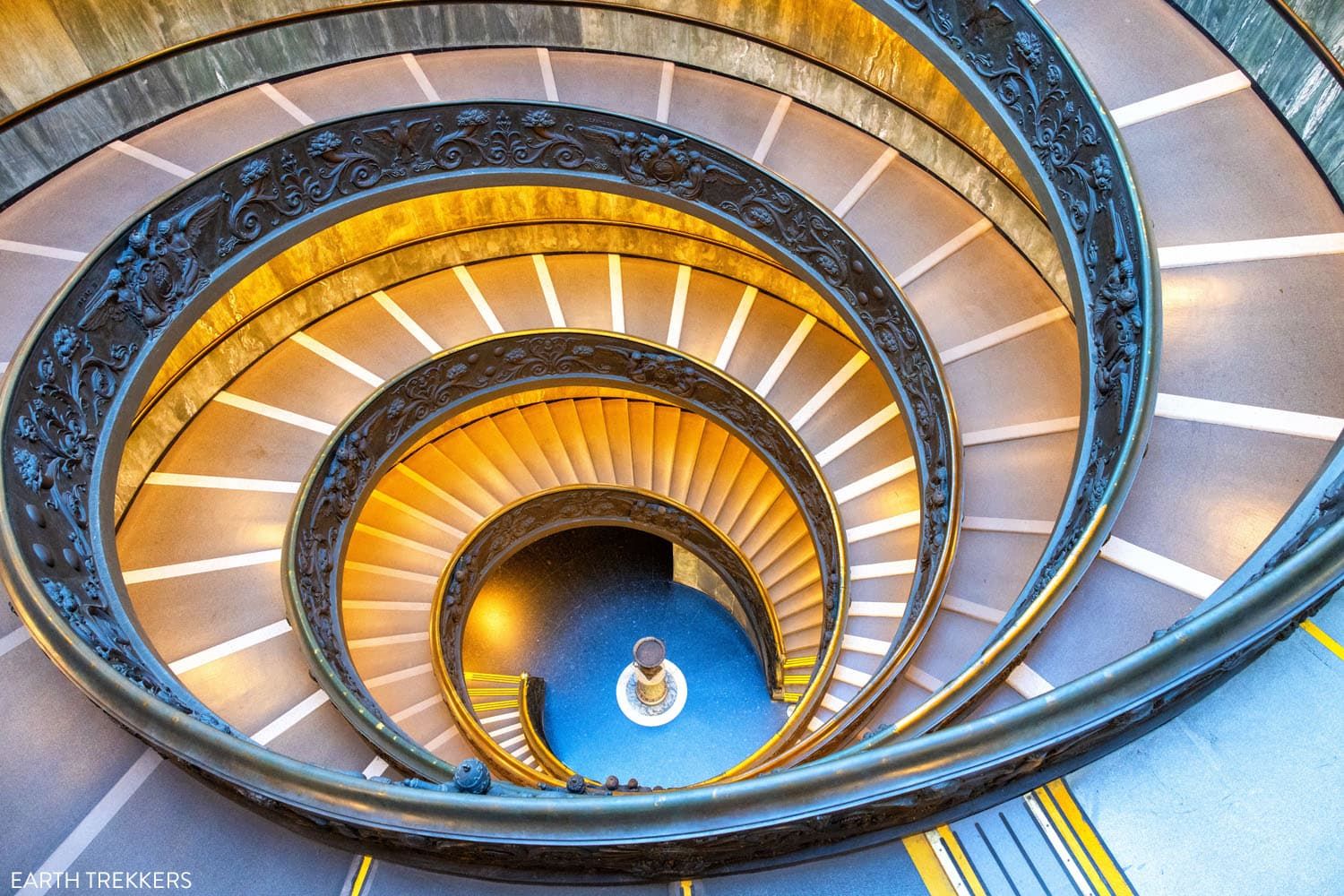
The modern Bramante Staircase
On a visit to the Vatican Museums, you will also see the Sistine Chapel. The Sistine Chapel is famous for its frescoes on the ceiling and The Last Judgement, which were painted by Michelangelo. Note, no photos are allowed in the Sistine Chapel and this is strictly enforced.
The lines to enter the Vatican Museums and the Sistine Chapel are legendary. We are talking up to 3-hour waits on the busiest days. Mid-mornings tend to be the busiest time to tour the Vatican. In the afternoon, crowds tend to lessen, at least a little bit. To avoid the worst of the crowds, the best times to visit Vatican City are first thing in the morning and just before closing time. You can skip this line by purchasing your ticket in advance.
We highly recommend taking an early morning tour of the Vatican. Starting bright and early at 7:30 am, you get to visit the Vatican Museums and the Sistine Chapel before they officially open to the public.
How to Visit the Vatican Museums & St. Peter’s Basilica
In our guide to the Vatican Museums and St. Peter’s Basilica, we cover what you need to know to plan your visit, including if a tour is worth it, how to avoid the lines, plus information about the “secret rooms” in the Vatican.St. Peter’s Square
Located in Vatican City, this enormous square was designed by Bernini between 1656 and 1667.
Sitting in the center of St. Peter’s Square is the Vatican Obelisk, which is an Egyptian obelisk made of red granite as well as two fountains, the Maderno Fountain and the Bernini Fountain. Flanking the square are 284 Doric columns and 88 pilasters.
The square can hold up to 300,000 people. If you get here mid-morning to enter St. Peter’s Basilica, it may feel like the square is filled to capacity. This can be a very busy place to visit.
St. Peter’s Square is free to visit. For the grandest entrance, walk up Via della Conciliazione to the square.
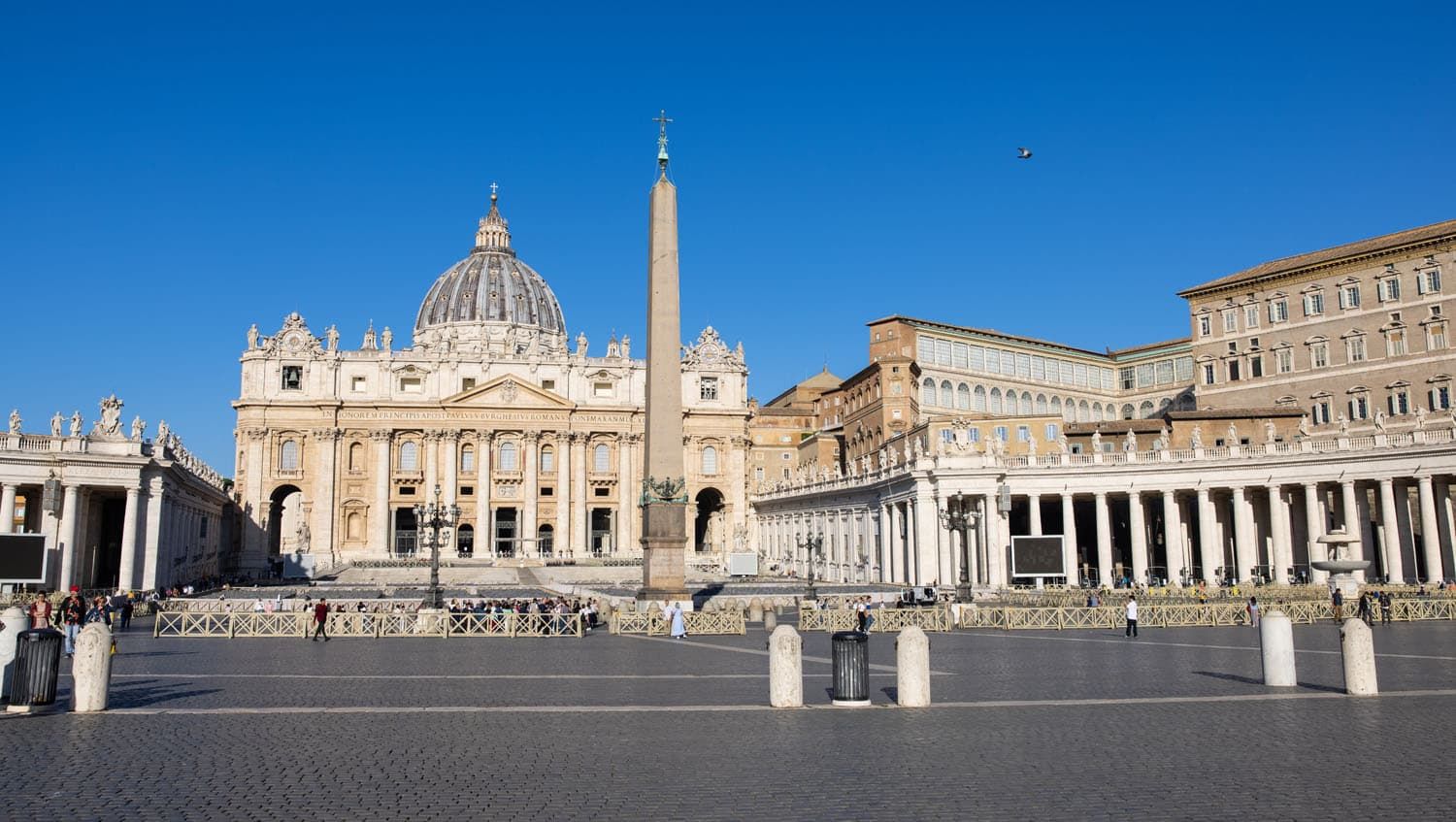
St. Peter’s Square (early in the morning)
St. Peter’s Basilica
St. Peter’s Basilica is the largest church in the world. It is also considered to be the most renowned work of Renaissance architecture.
This is one of the most awe-inspiring churches we have visited. Step inside and it will take your breath away.
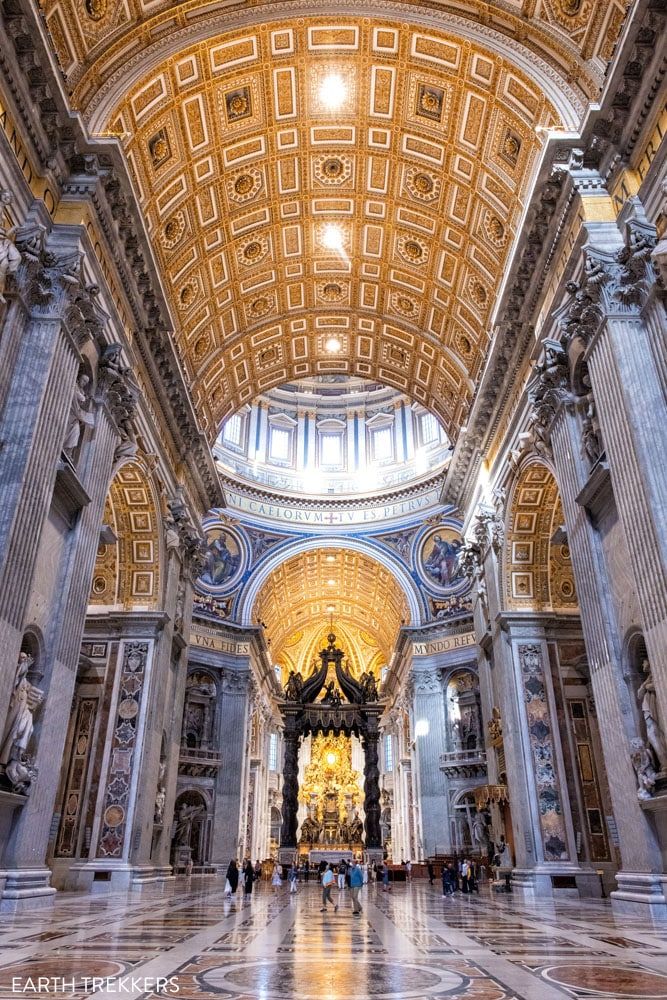
St. Peter’s Basilica
While inside, see the dome, which was designed by Michelangelo, Gian Lorenzo Bernini, Donato Bramante, and Carlo Maderno, St. Peter’s Throne, which was designed by Gian Lorenzo Bernini, the Baldacchino, and the Vatican Grottoes (tombs of the popes).
For another spectacular view of Rome, climb 551 steps to the top of the Dome (€8) or take the elevator to the terrace and climb 320 steps to the top (€10).
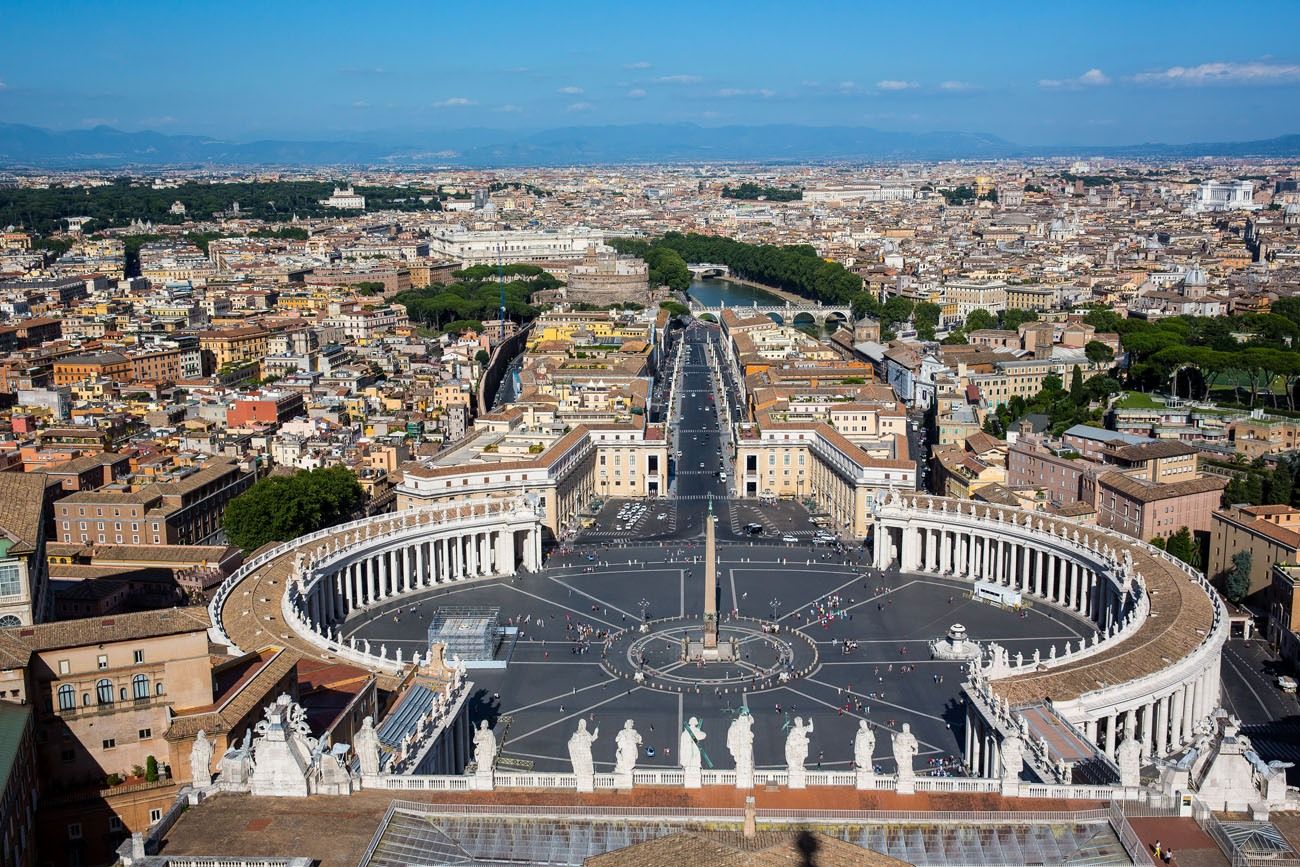
The view from the dome
St. Peter’s Basilica is free to visit, with the exception of the dome. To enter the basilica, you will have to wait to get through security. There is no way to skip this line, even if you are on a tour of some sort.
Get here early to avoid a long wait in the security line. We arrived at 7:15 am and had a 5-minute wait to get through security. Later in the day, we returned at 10 am and the line was enormous. I estimate it was at least a 45-minute wait to enter the basilica (this was at the end of September in 2022). If you can, get here at opening time.
For more information about hours and pricing, visit the official website.
4. The Historic Heart of Rome
The historic heart of Rome is the ancient city of Rome. Famous piazzas, fountains, and historical sites are all located smack in the city center, making this one of the top walking routes for first timers in Rome. Here are the must-see sights, plus a walking route on a map.
How to Use This Map: Click the icons on the map to get more information about each point of interest. To take this map with you, click the star next to the title of the map which adds it to your Google account. Next, within your Google Maps app, select ‘Saved’ and then select ‘Maps’. This map title will now appear in your list.
The Spanish Steps
Linking Piazza di Spagna with Trinità dei Monti church are the world-famous Spanish Steps. This stairway is one of the most popular places to visit in Rome, frequently shows up in walking tours of the city, and is free to visit.
The fountain that sits at the bottom of the Spanish Steps, Fontana della Barcaccia (Fountain of the Longboat), dates back to 1629 and was built by Pietro Bernini, father of Gian Lorenzo Bernini.
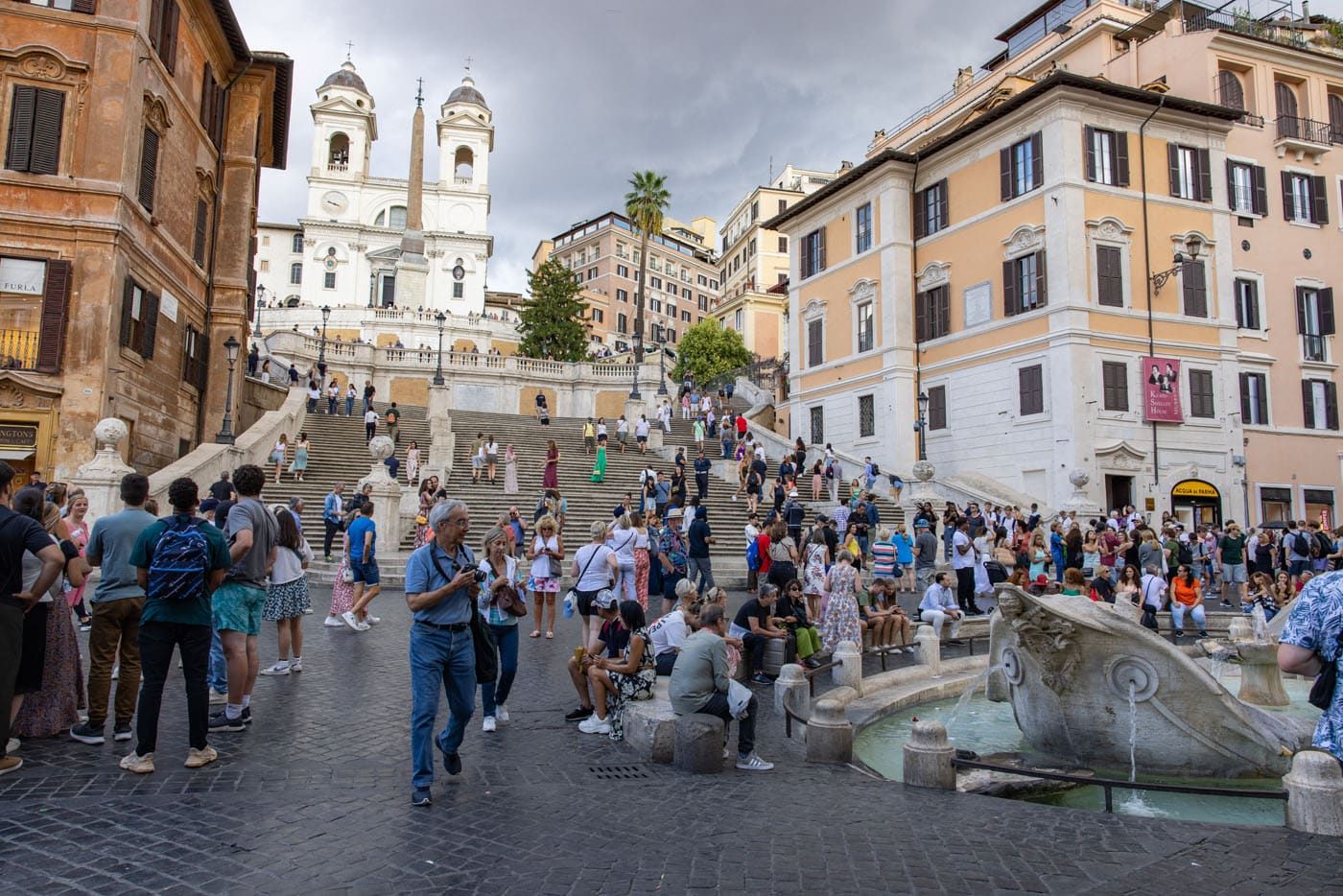
Spanish Steps on an afternoon in September
PRO TRAVEL TIP: Tired and need a break? Think twice about having a seat on the Spanish Steps. In 2019, a new law was put in place to crack down on “bad behavior” in Rome. If you are caught sitting on the Spanish Steps, you risk paying a €400 fine. There are officers here enforcing this rule.
The Trevi Fountain
The Trevi Fountain is one of Rome’s most famous icons.
Legend has it that if you throw a coin into the Trevi Fountain, you will be ensured a return visit to Rome. This is such a popular activity that an estimated $1.5 million USD was thrown into the fountain in 2016!
Fendi funded the most recent renovation, which took over one year to complete between 2014 and 2015. State of the art LED lights illuminate the fountain…it is an awesome sight to see!
This is an extremely busy spot all day. From morning to night, expect huge crowds around the Trevi Fountain. On our first night in Rome, we were here at 1 am and even then, there were about 20 to 30 people hanging out by the fountain.
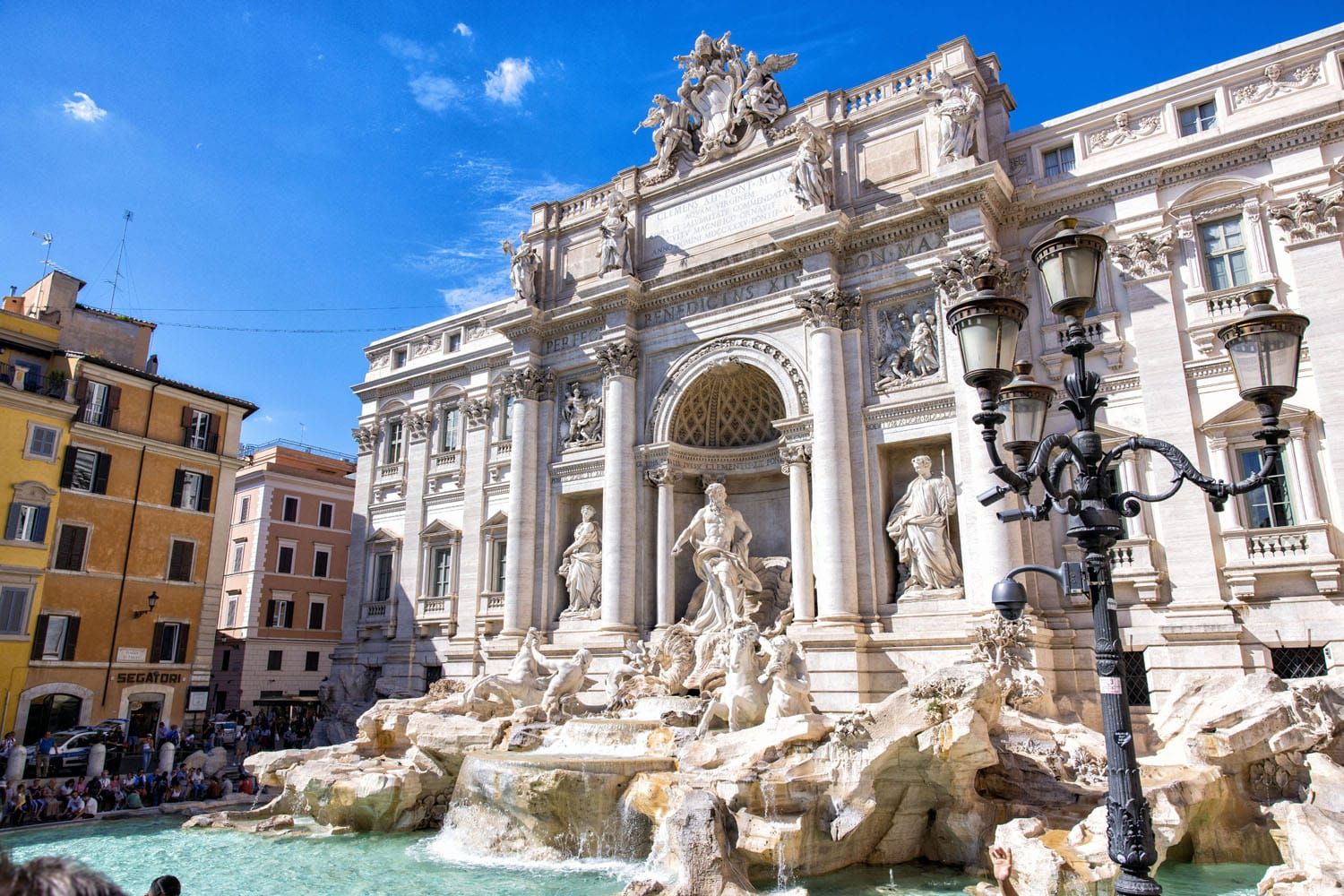
Trevi Fountain
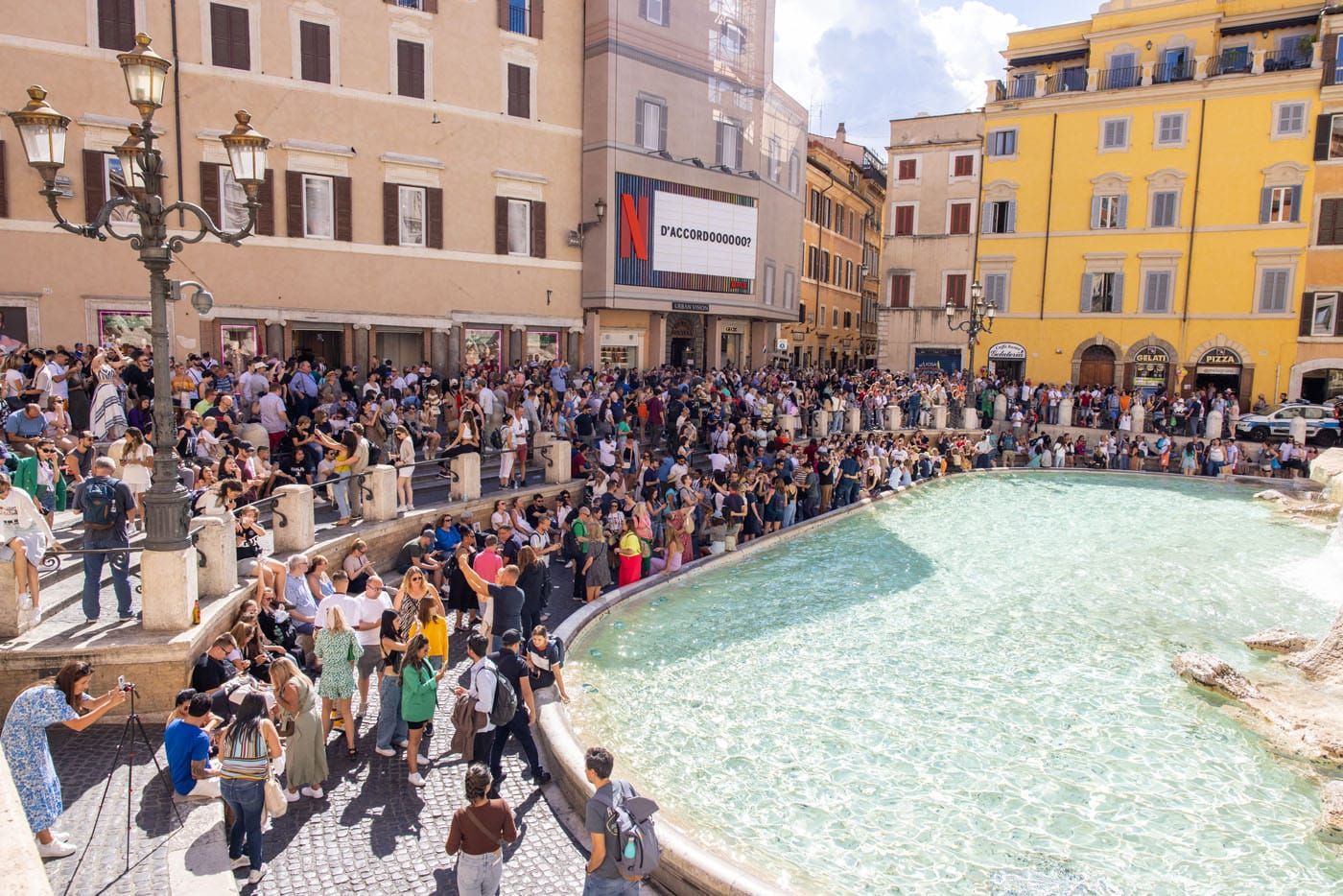
Midday crowds at the Trevi Fountain
PRO TRAVEL TIP: Want a bird’s eye view of the Trevi Fountain? Go to Trevi Rooftop, a rooftop bar with a view of the fountain. Learn more in our guide to the Best Rooftop Bars in Rome.
Temple of Hadrian
Built in 145, this temple was constructed to honor Roman Emperor Hadrian. It is one of the oldest buildings in Rome. All that remains are eleven Corinthian columns and these can be seen on a walk through the historic heart of Rome, not far from the Trevi Fountain and the Pantheon.
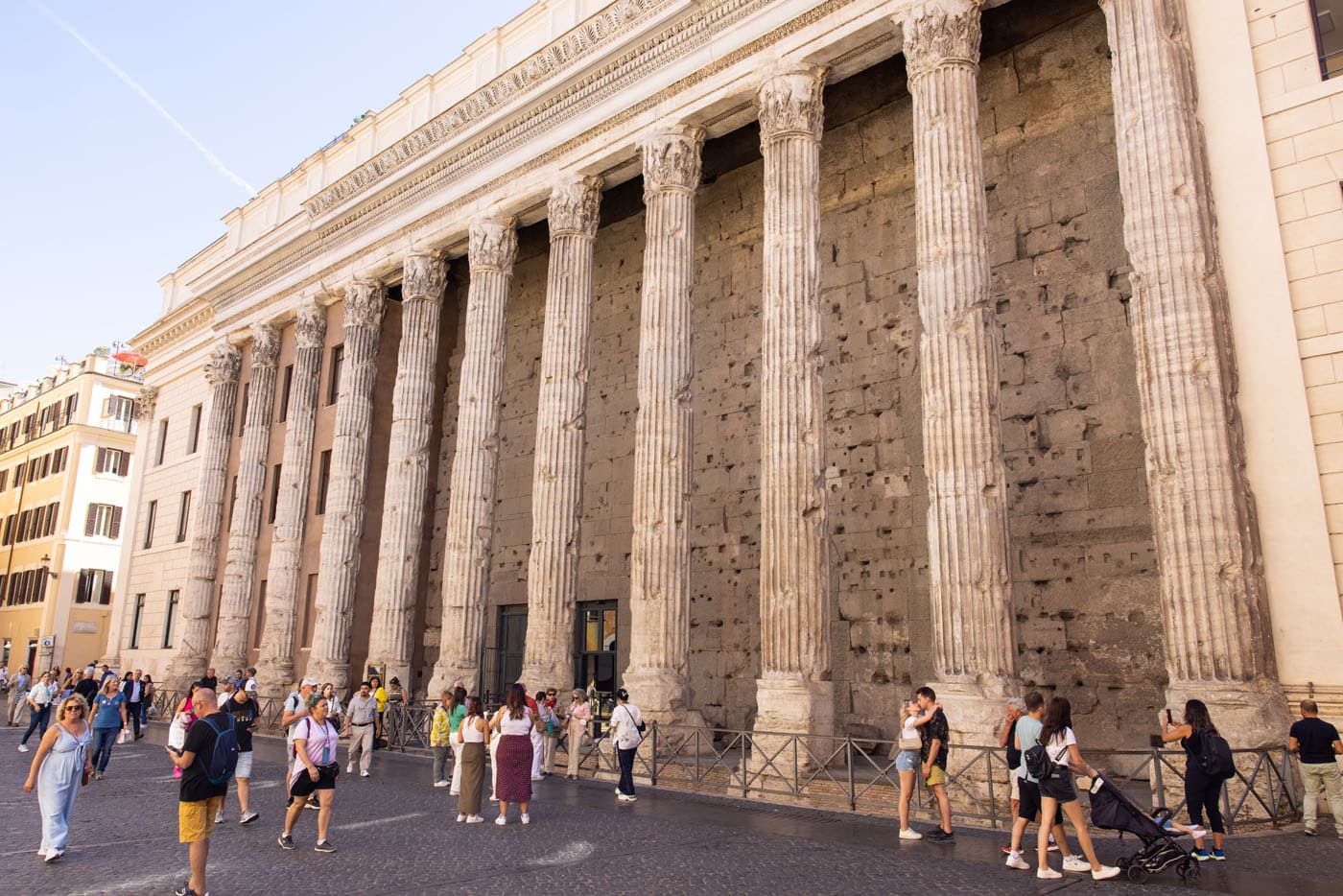
Temple of Hadrian
The Pantheon
The Pantheon is even older than what remains of the Temple of Hadrian.
Construction of the Pantheon was completed around 120 AD. Just think about what this building survived…barbarian raids, wars, earthquakes, and the natural aging of 1900 years of wind, rain, and even snow.
For 1300 years, this was the largest dome in the world, until the completion of St. Peter’s Basilica during the Renaissance. But the best part of the Pantheon is the oculus, the circular window in the top of the dome, the only source of light inside of the building.
When you first walk up to it, the Pantheon looks like an ancient, bulky, worn-out building. But inside, it looks surprisingly nothing like the exterior. It’s beautiful in the inside, with colorful Italian marble and the very unique lighting from the oculus.
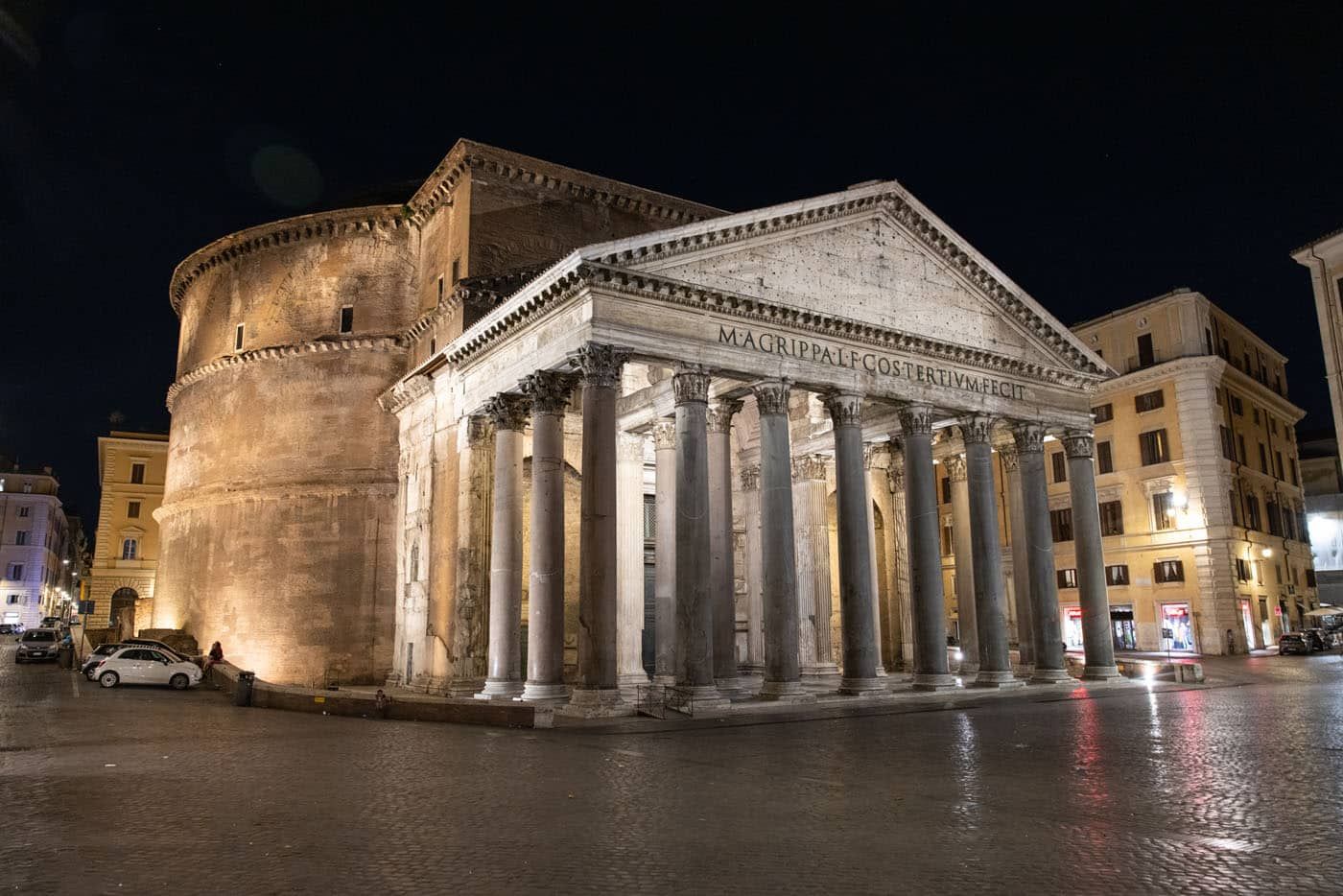
Pantheon
Piazza Navona
This huge, colorful piazza is a joy to visit. It’s filled with cafes, fountains, and lots of people. This is a great spot to take a break and enjoy a cup of coffee or glass of wine while people watching.
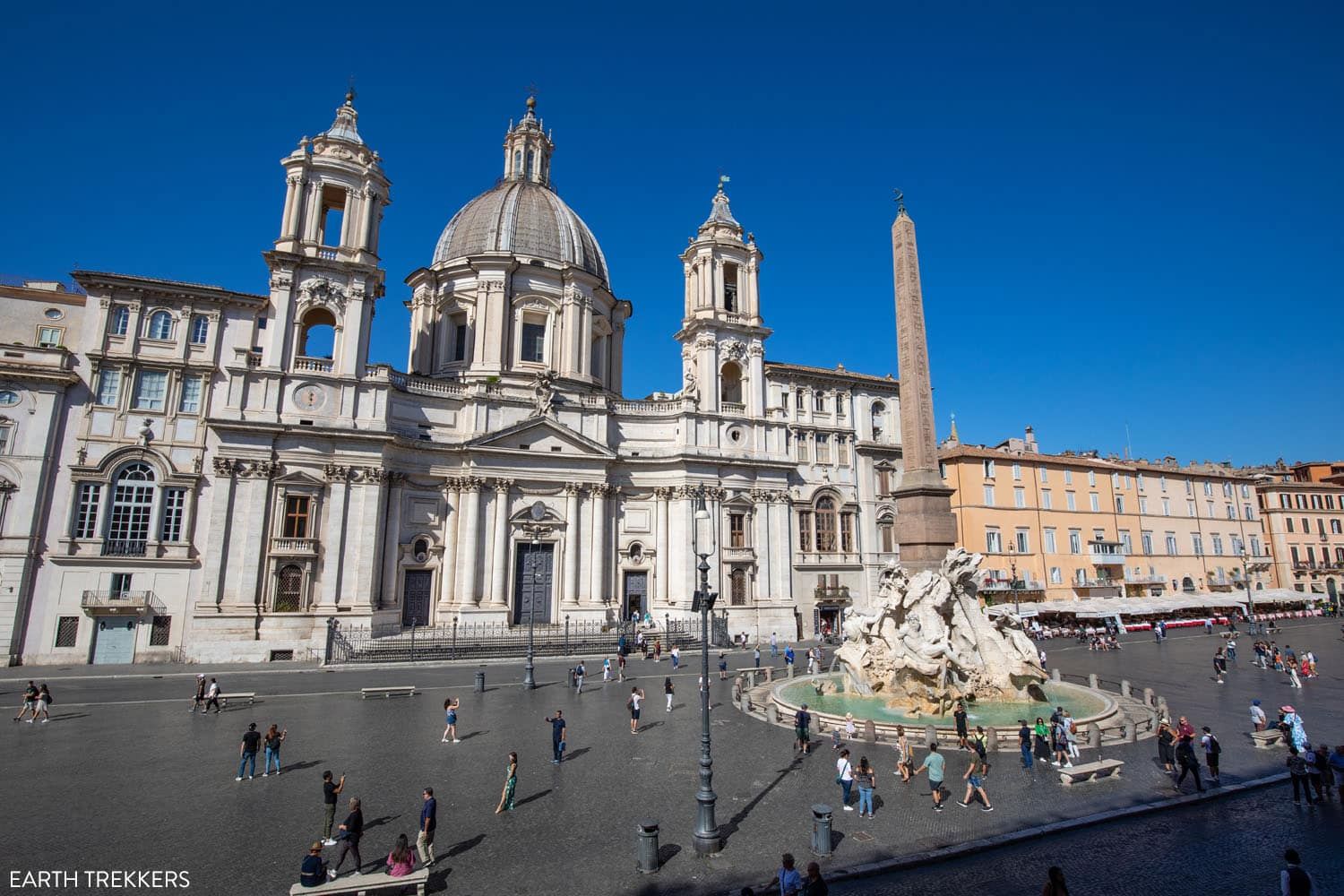
Piazza Navona
There are also a few must-see fountains and sculptures.
Fontana dei Quattro Fiumi (Fountain of the Four Rivers) stands at the center of Piazza Navona. This fountain was created by Gian Lorenzo Bernini. It contains four river gods and is topped by an obelisk made of Aswan granite.
Fountain of the Moor (Fontana del Moro), at the southern end of Piazza Navona, and the Fountain of Neptune (Fontana del Nettuno), at the northern end, were sculpted by Giacomo della Porta.
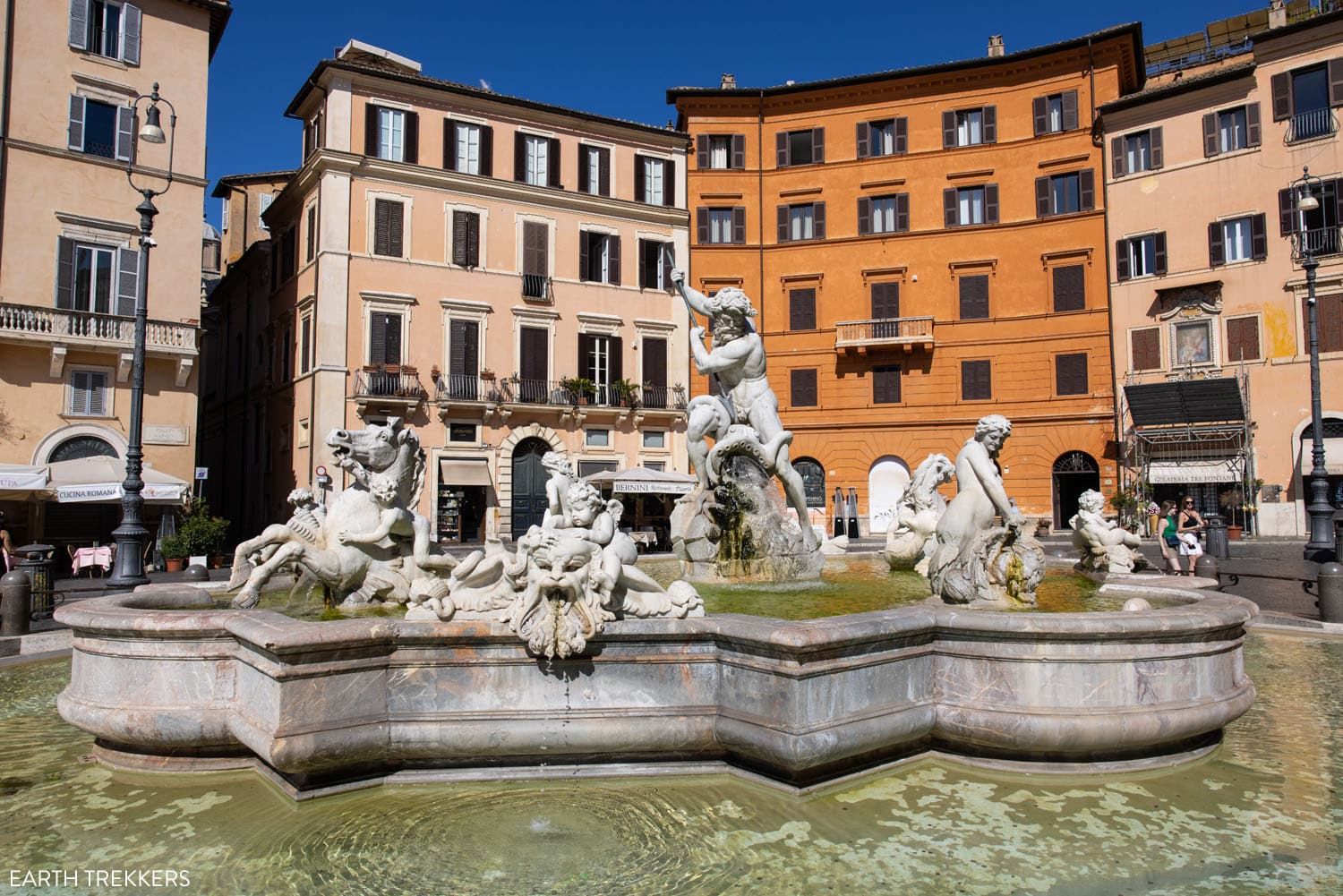
Fountain of Neptune
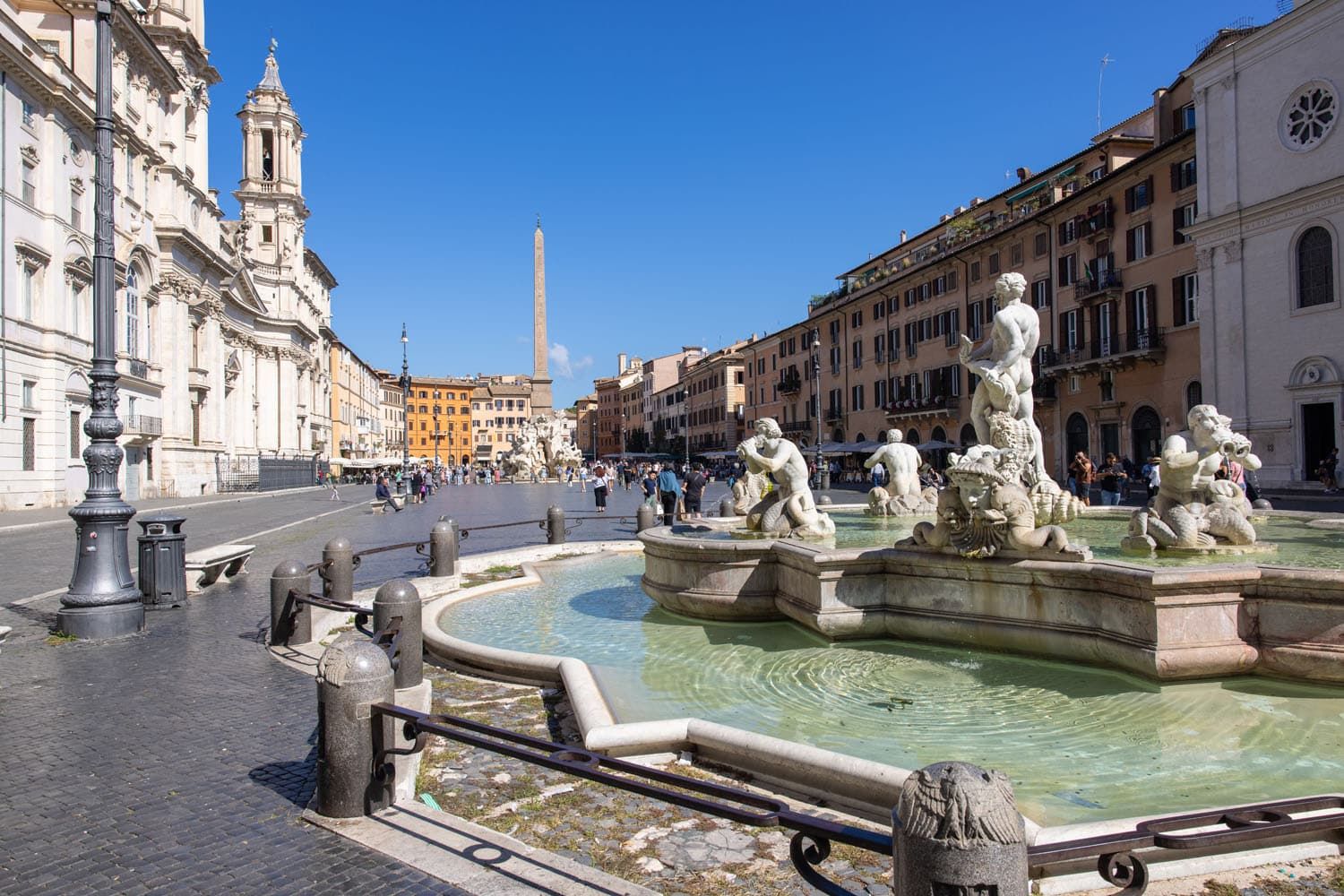
Fountain of the Moor
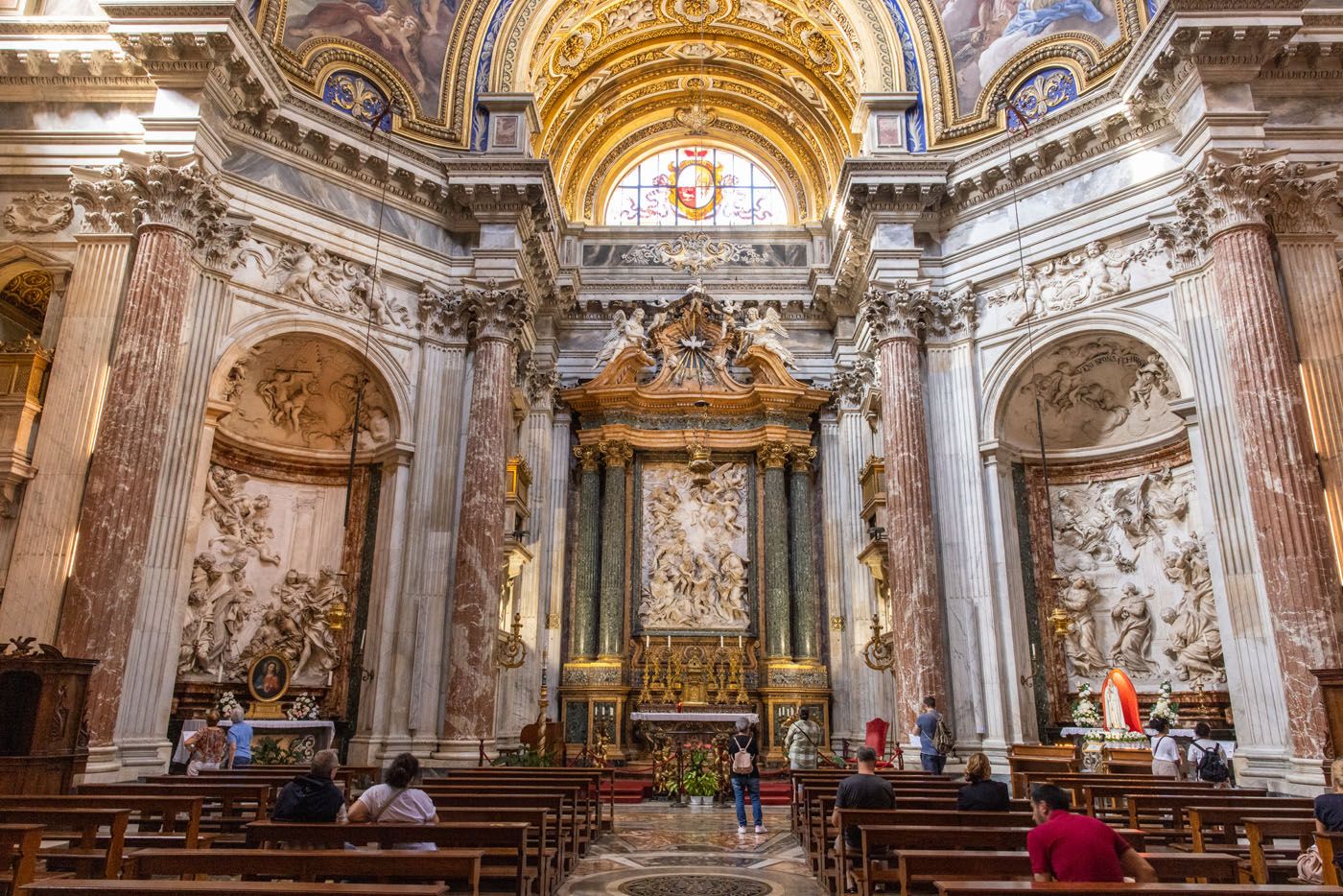
The interior of Sant Agnese in Agone, which sits on Piazza Navona.
On our most recent visit to Rome, we stayed at Lifestyle Suites Rome. We had a view of Piazza Navona from our room. But the best part was the rooftop terrace for a stunning aerial view over the piazza.
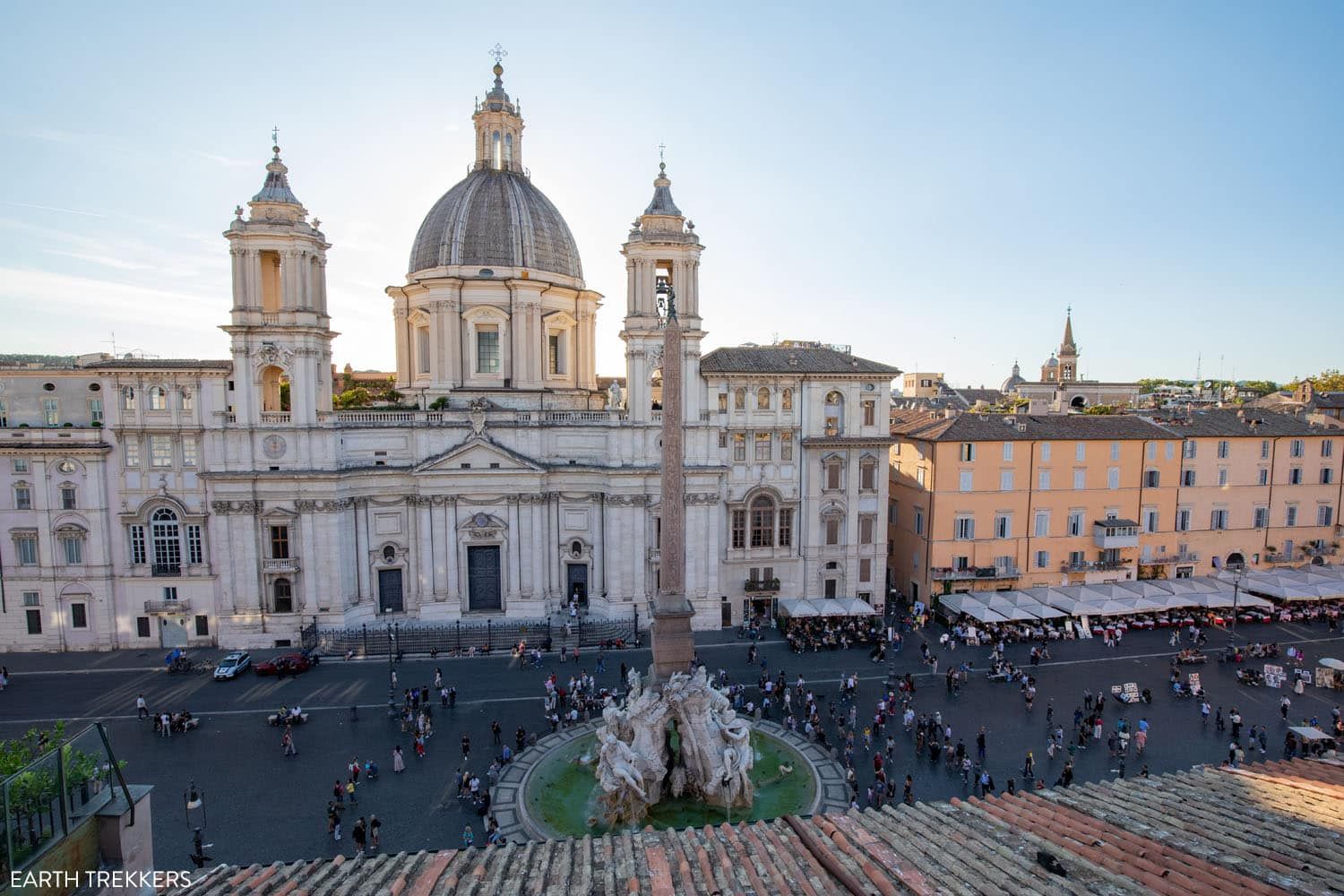
View of Piazza Navona from Lifestyle Suites Rome.
Campo de’ Fiori
Not far from Piazza Navona is Campo de’ Fiori. This smaller square is filled with markets during the day is a popular hangout spot in the evening.
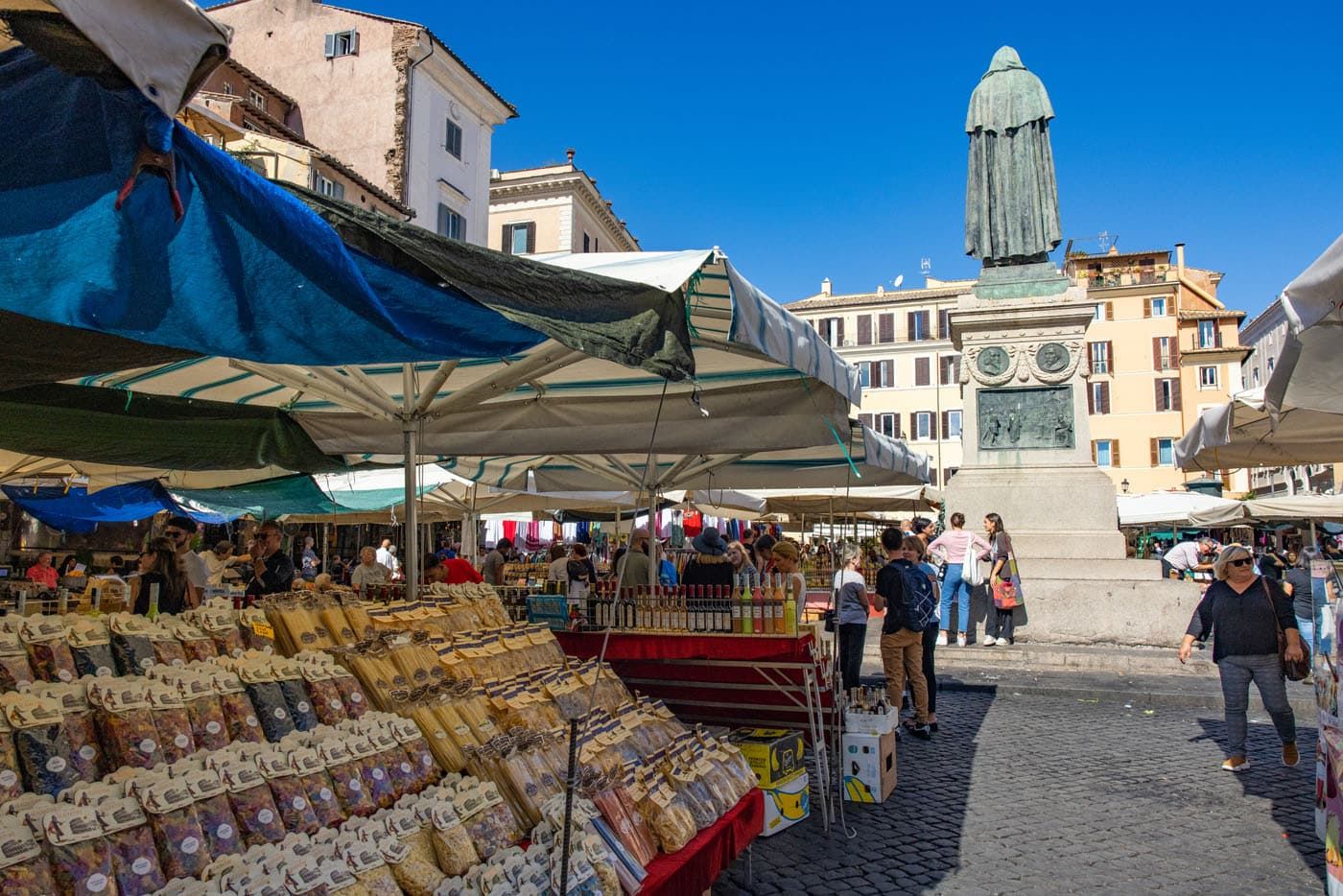
Campo de’ Fiori
5. Eat Gelato
Restaurants selling gelato can be found throughout Rome, but there are a few notable places to mention.
Venchi. This gelateria is a chain, so it can be found in other cities around the world. This is one of our favorite gelato shops, because you can get Nocciolo Supreme (a thick, chocolate hazelnut sauce) poured into the bottom of the cone and then topped with gelato. It doesn’t matter what flavor of gelato you get, that last bite of the cone is out of this world. They have a smaller choice of flavors than other shops we visited, but on the list is chocolate, vanilla, hazelnut, and Stracciatella, just to name a few. Whether you order a cone or a cup, it will look like a work of art once they hand it over.
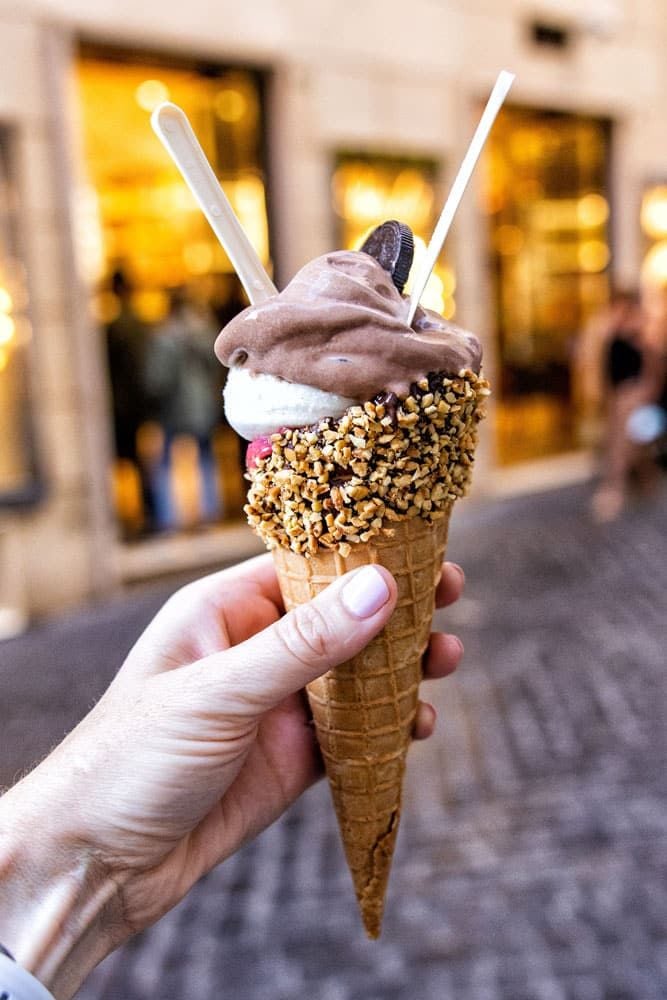
Venchi gelato
Giolotti. There’s nothing fancy about this place, they just serve really good gelato. The pistachio seemed like a popular pick and it was delicious. Expect the longest wait in line here. If you can only pick one gelateria, this is the one we recommend.
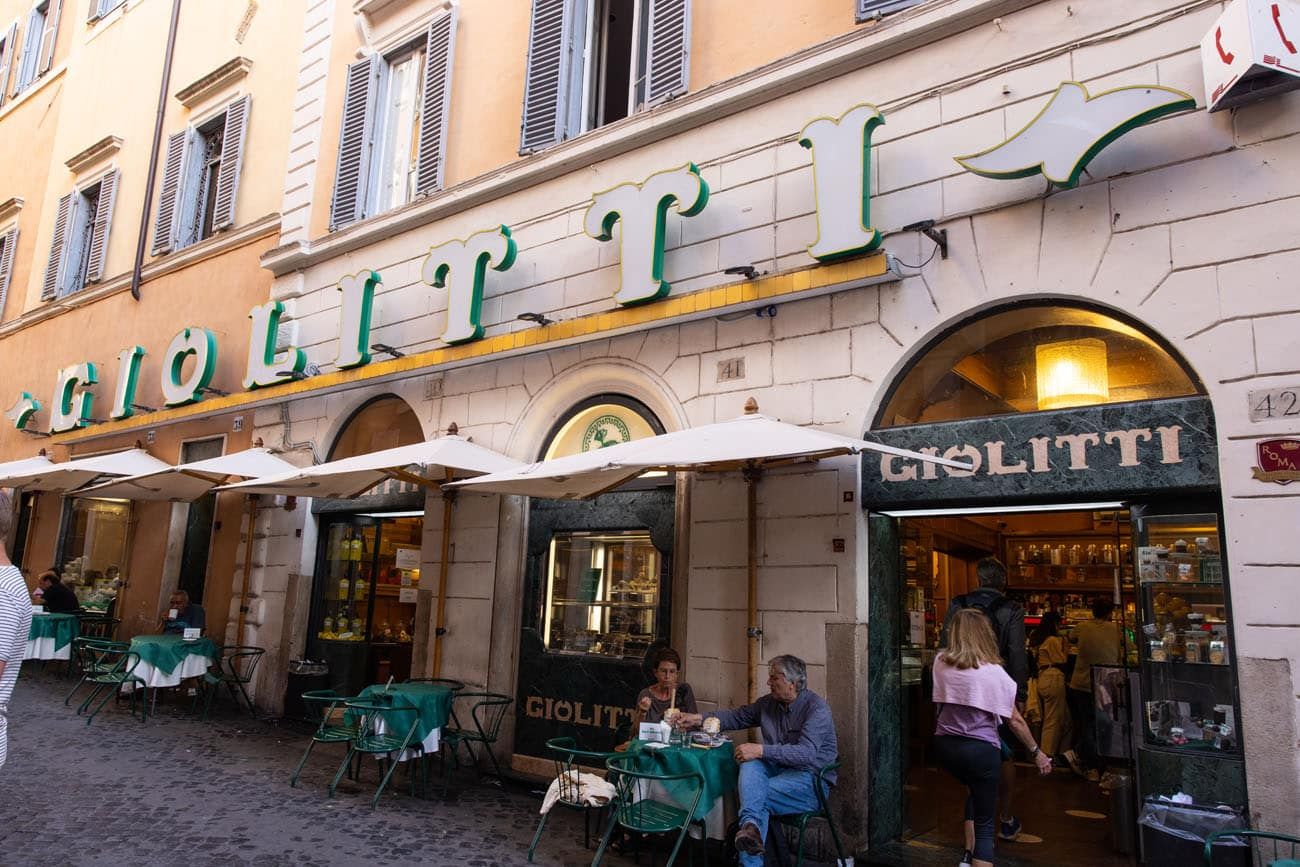
Giolitti
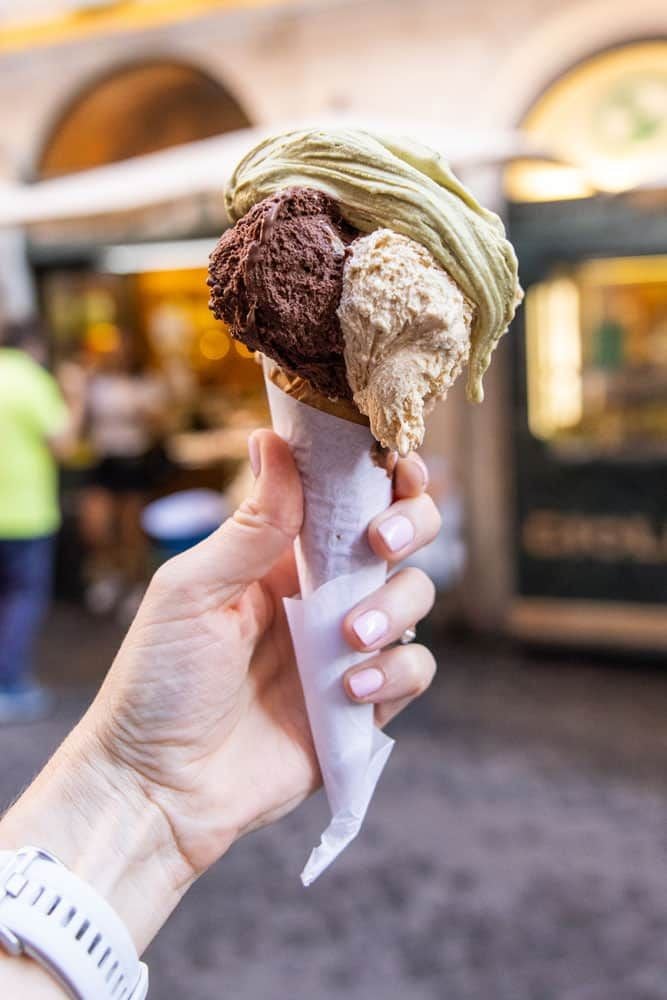
Gelato at Giolitti
Gelateria Della Palma. This popular gelato shop has an overwhelming choice of flavors, some of them a bit bizarre. It also feels a little more chaotic here than the shops mentioned above. Pay first and then pick out your flavors after you pay.
6. Galleria Borghese & the Borghese Gardens
The Borghese Gallery
Galleria Borghese is an art museum that contains one of the best collections of art in the world. See works of art by Raphael, Caravaggio, Titian, and Bernini. Even the building is an attraction.
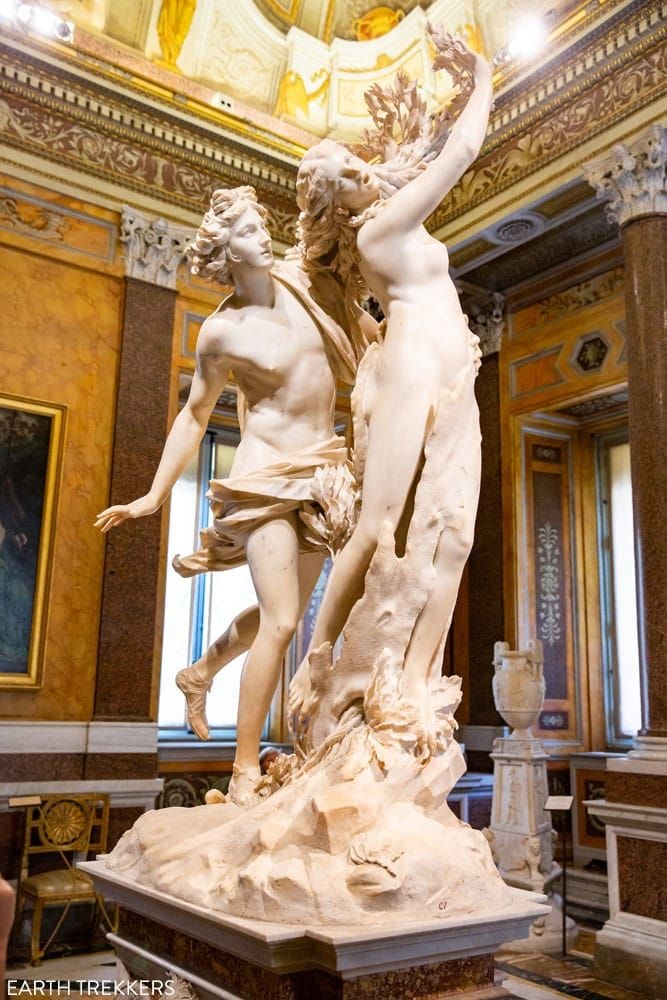
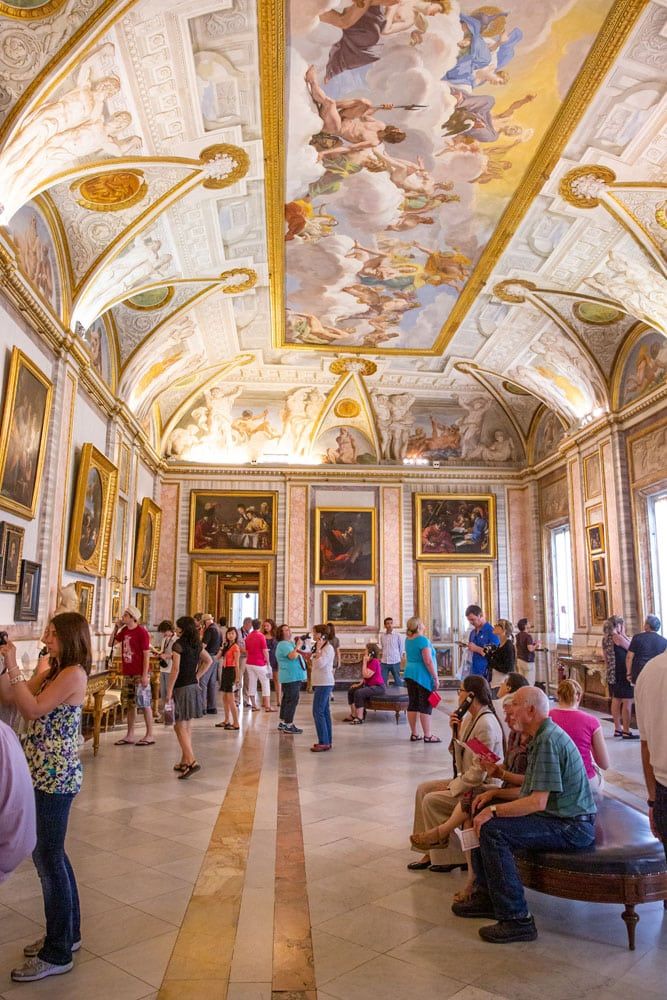
PRO TRAVEL TIP: You can only visit the Borghese Art Gallery with a reservation. Reservations can be made up to 3 months in advance. Reservations are made for two-hour time slots, starting at 9 am, and the last time slot is at 5 pm.
You can make your reservation online or call +39 06 32810. There is a €2 fee for making online reservations. Tickets can also be purchased through GetYourGuide, which includes a guided tour of Borghese Gardens. This is a great option if you want to visit the museum with a guide or were unable to purchase tickets on the official website.
For hours of operation and updated pricing, and to make your reservation, visit the official website.
Villa Borghese Gardens
The Villa Borghese Gardens are one of the largest parks in Rome. This is where you will find Galleria Borghese, but as you stroll through the park, there are a few notable things to do and viewpoints of Rome to visit.
Terrazza del Pincio. You get a wonderful view of Piazza del Popolo from this terrace that overlooks it. This viewpoint is located on the west side of the park. Scroll up to our section on Piazza del Popolo for a photo from this viewpoint.
Orologio ad Acqua del Pincio. This clock, which has been telling time since 1867, is run by hydropower. It’s located on a tiny island on a tiny lake within the gardens. It’s worth the visit if you will be in the area but not worth going out of your way to see it.
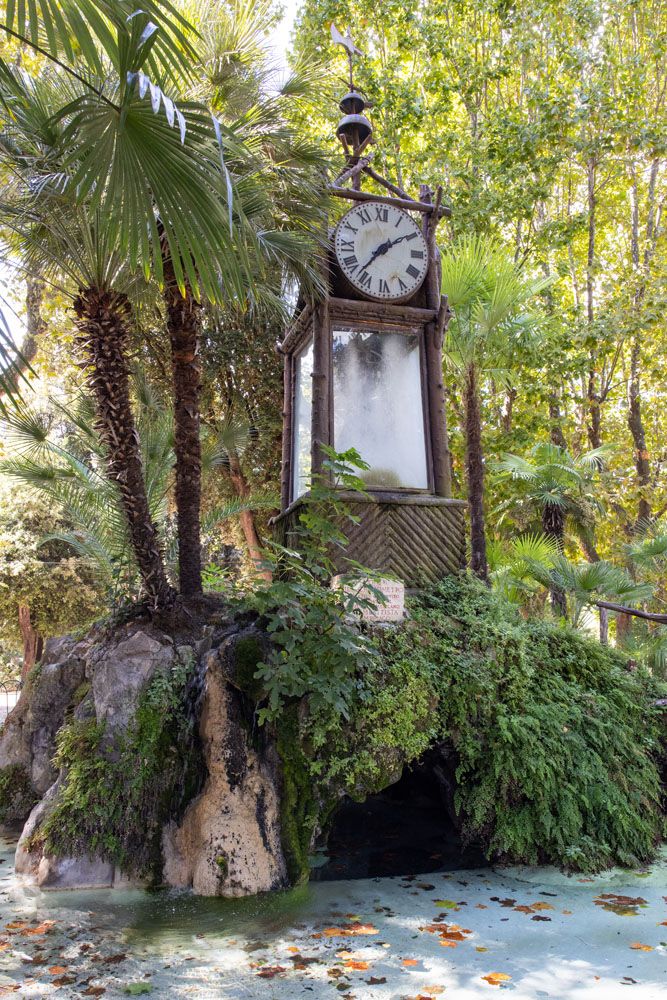
Orologio ad Acqua del Pincio
Tempio di Esculapio. Sitting on a small lake in the Villa Borghese Gardens is a temple dating back to 1786. It’s a popular photography location within the gardens. You can rent rowboats if you want a closer look.
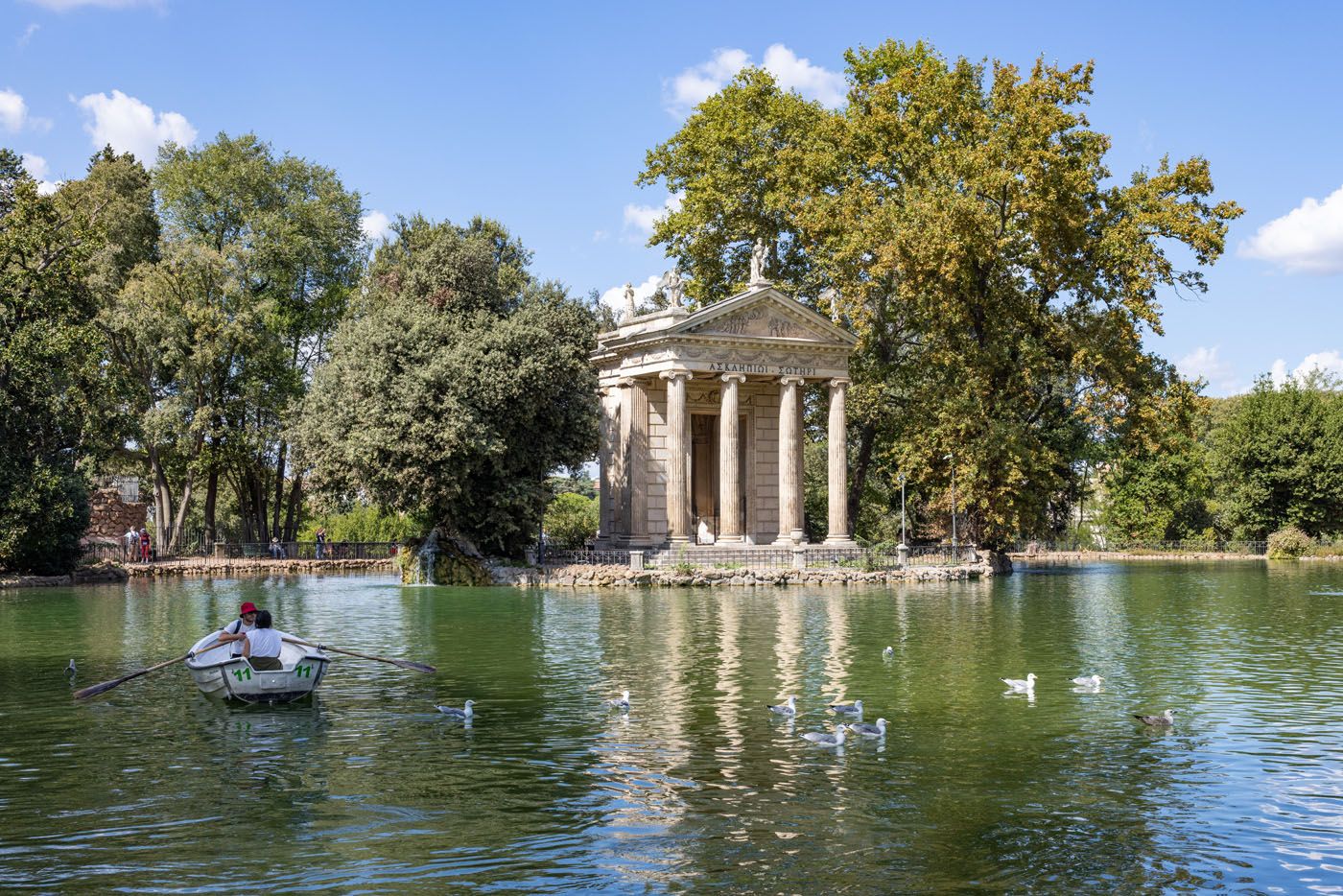
Tempio di Esculapio
Terrazza Viale del Belvedere. The view from here is nice. It’s worth a quick stop if you will be walking from the Borghese Gardens to the Spanish Steps, but I don’t recommend going out of your way to get to this viewpoint.
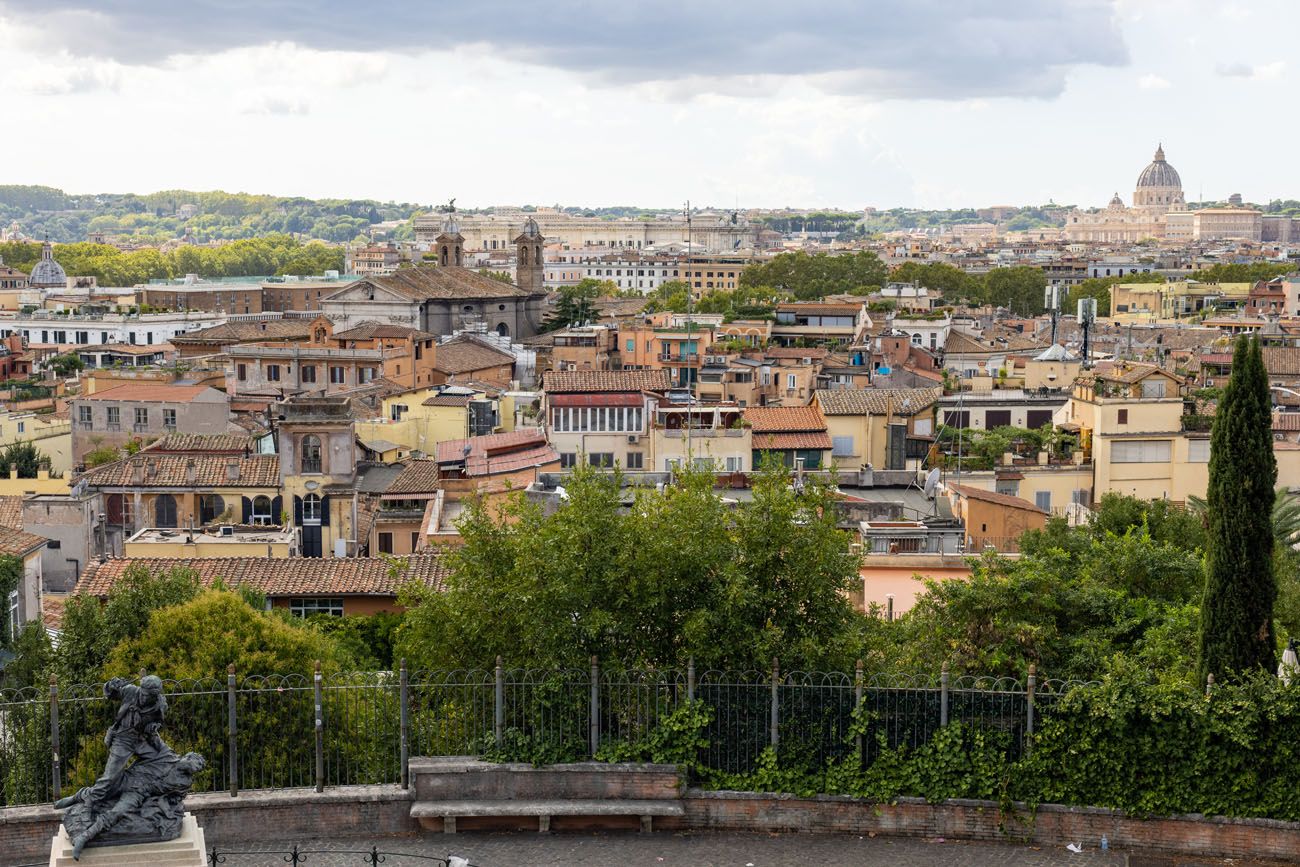
Terrazza Viale del Belvedere
7. Altar of the Fatherland
The Altar of the Fatherland, also called Altare della Patria, the Victor Emmanuel II Monument, or simply the “wedding cake,” is one of the most recognizable landmarks in Italy.
This national monument was built between 1885 and 1935 to honor Victor Emmanuel II, who was the first king of unified Italy. It contains the Tomb of the Unknown Soldier and an eternal flame.
The monument sits on Piazza Venezia, within walking distance of the Roman Forum and the Capitoline Museums.
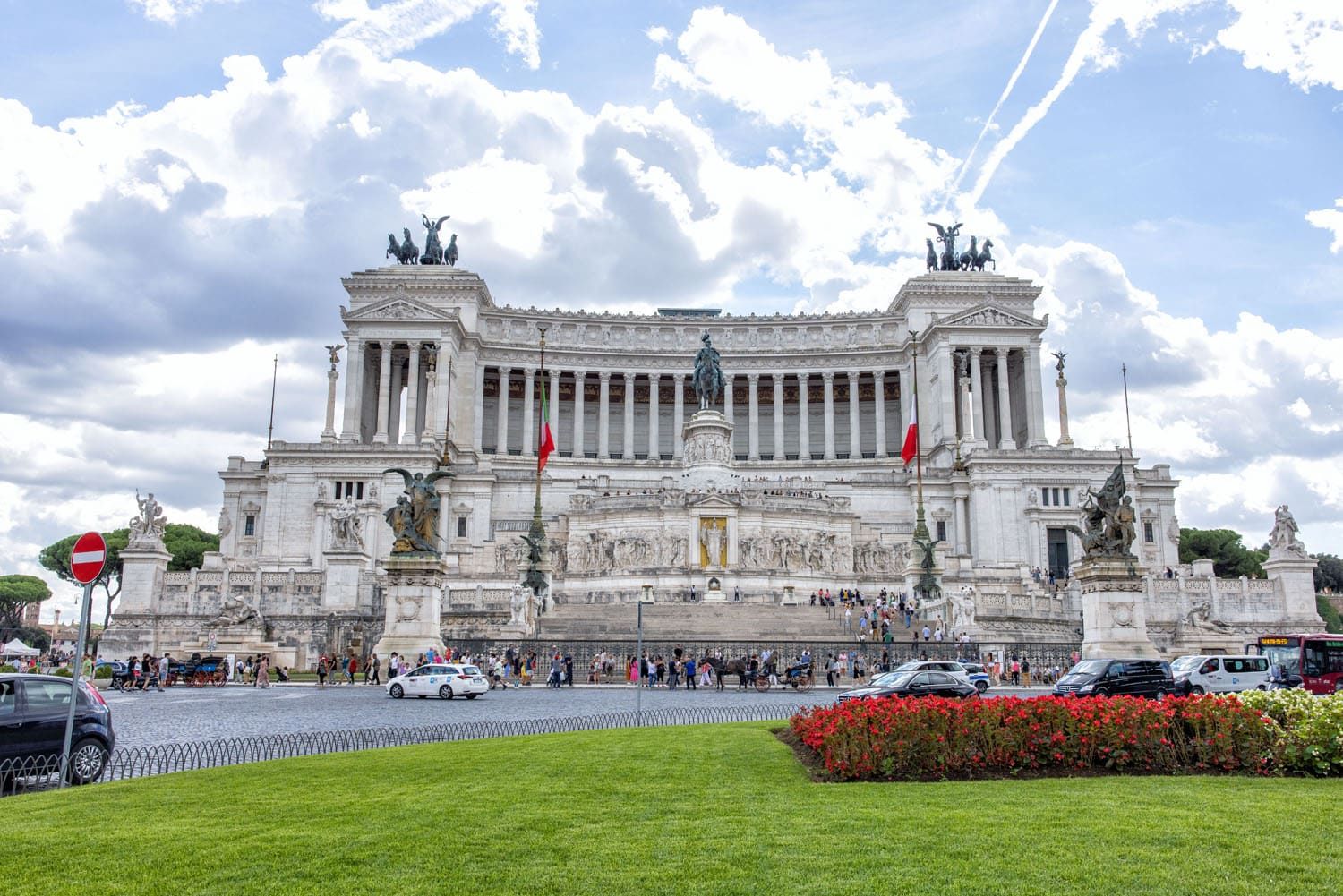
Altar of the Fatherland
Visiting the top of the Altar of the Fatherland for amazing views of the city is one of the best things to do in Rome.
For free, you can climb the series of staircases to the upper terrace and café. For the best view, ride the elevator (€12 in 2022) to the top of the monument for panoramic views of Rome. From here, you can see all of Rome’s major landmarks, including the Colosseum, St. Peter’s Basilica, Palatine Hill, and the Roman Forum.
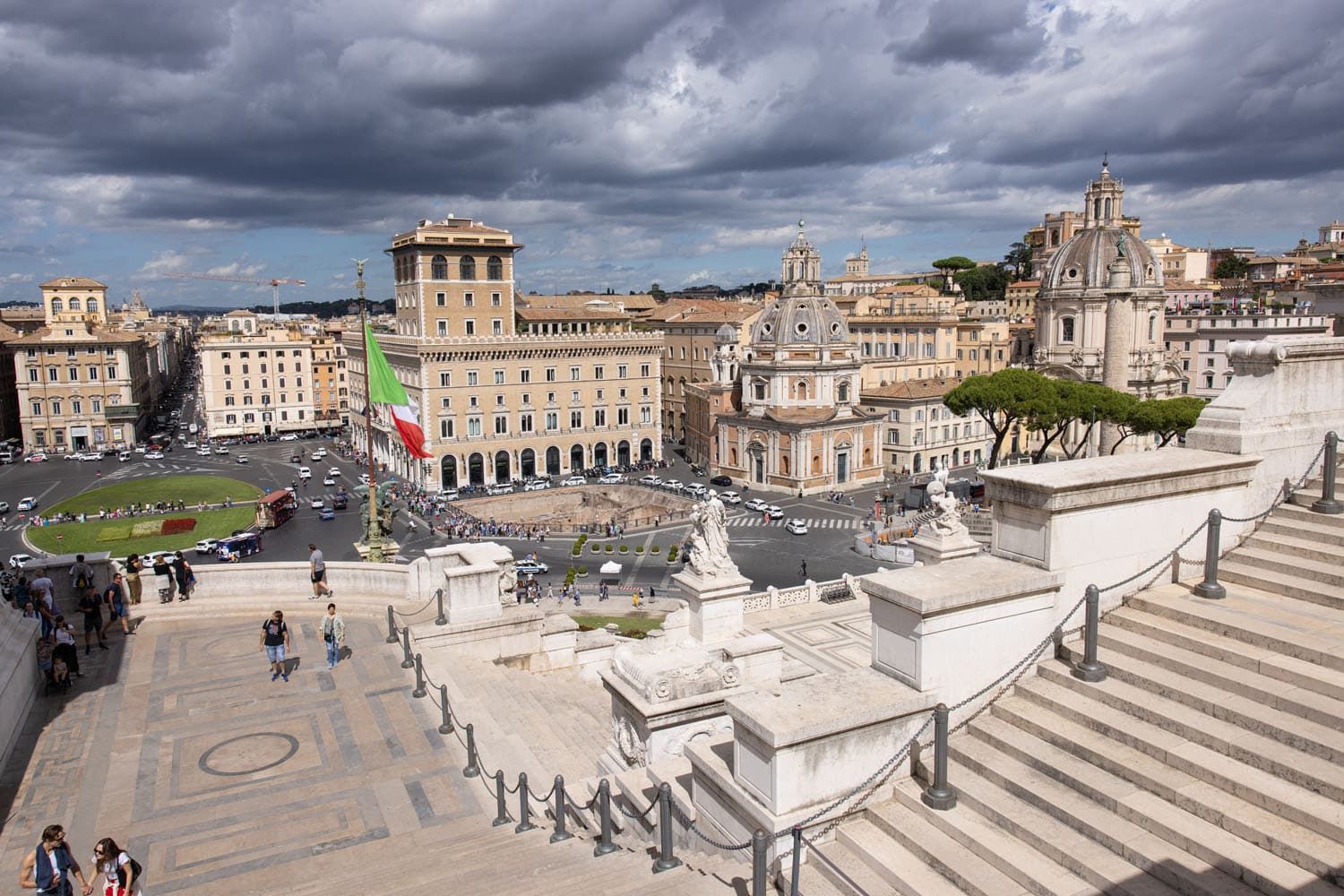
View from the steps
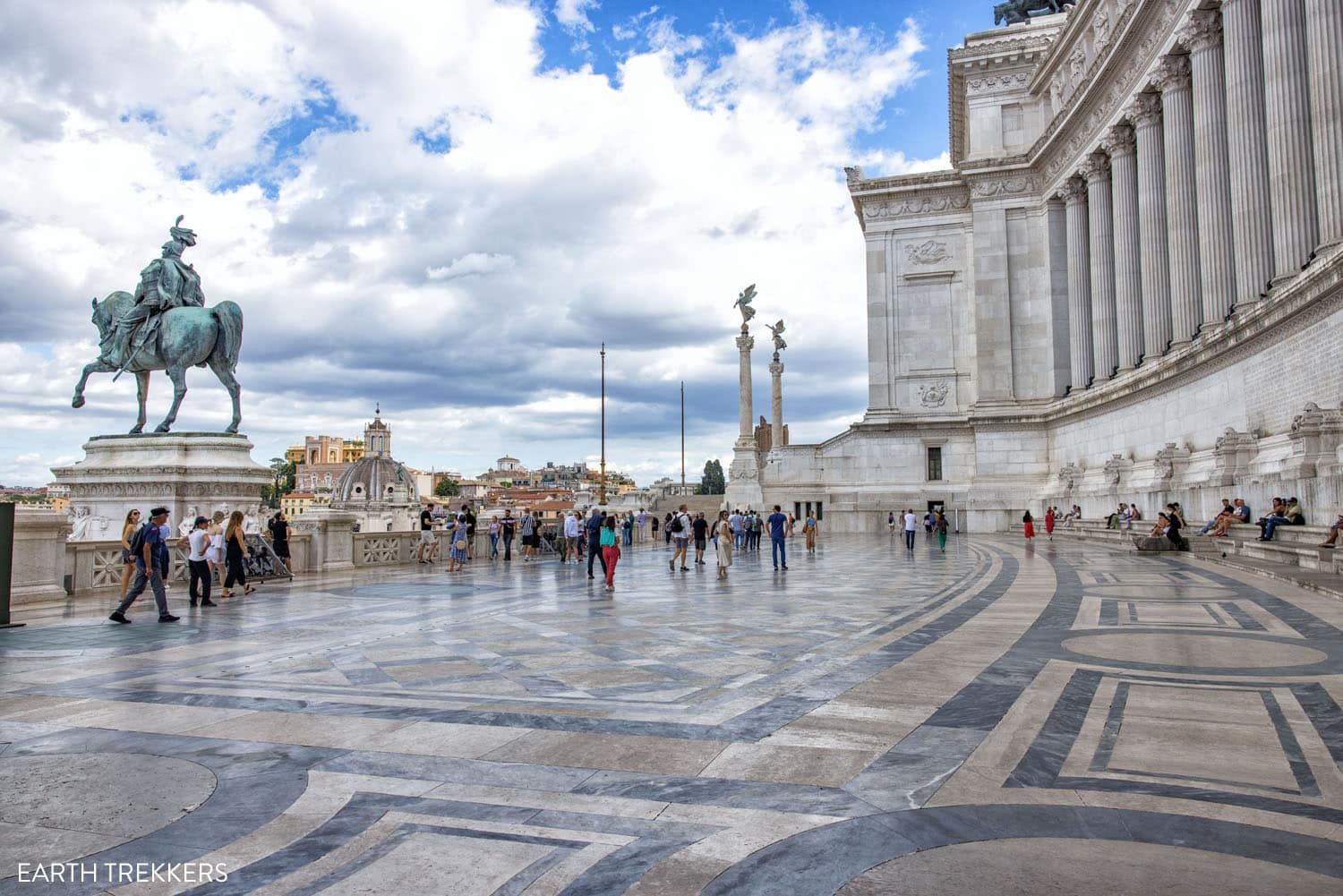
Terrace on Altar of the Fatherland
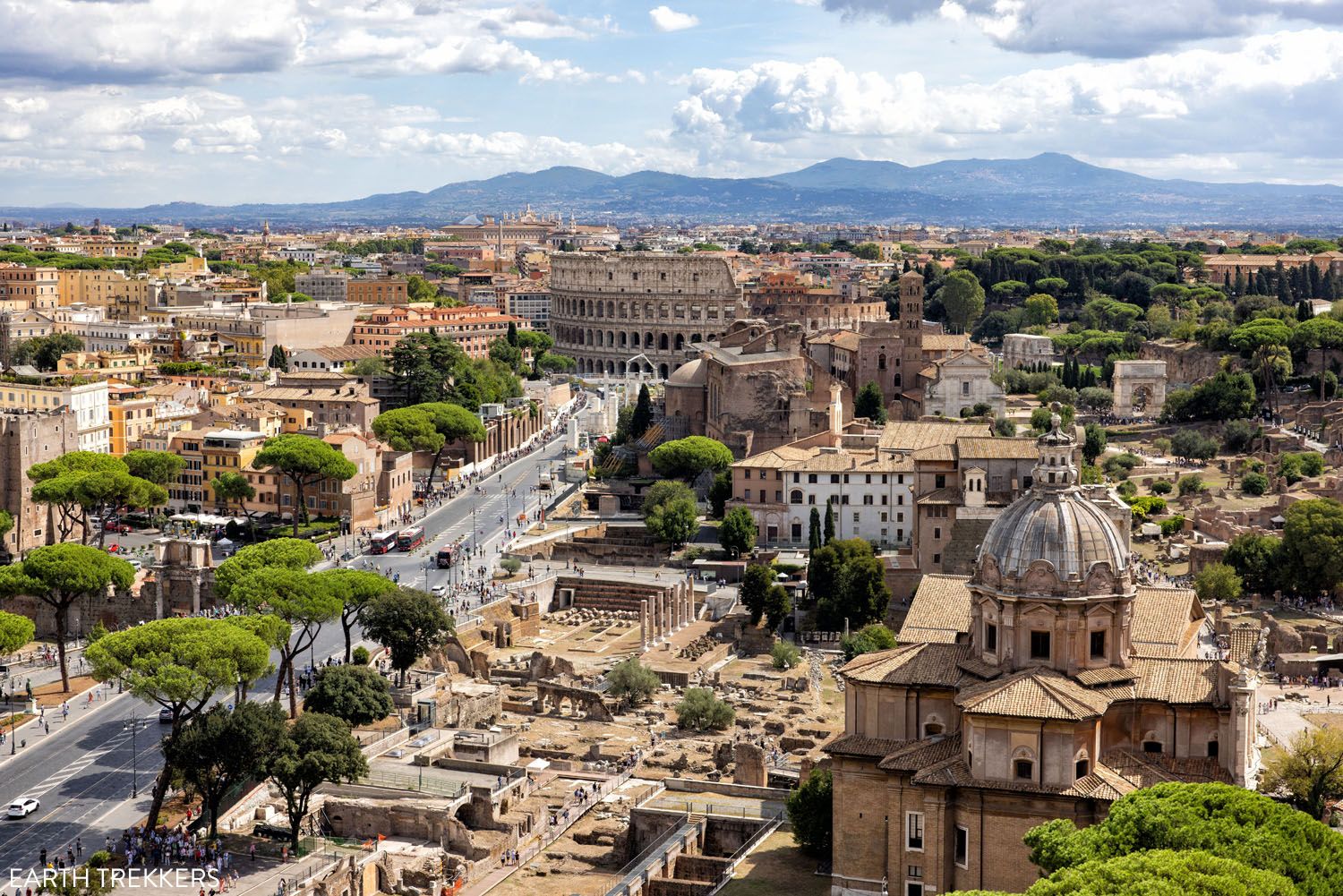
View from the highest terrace on the Altar of the Fatherland
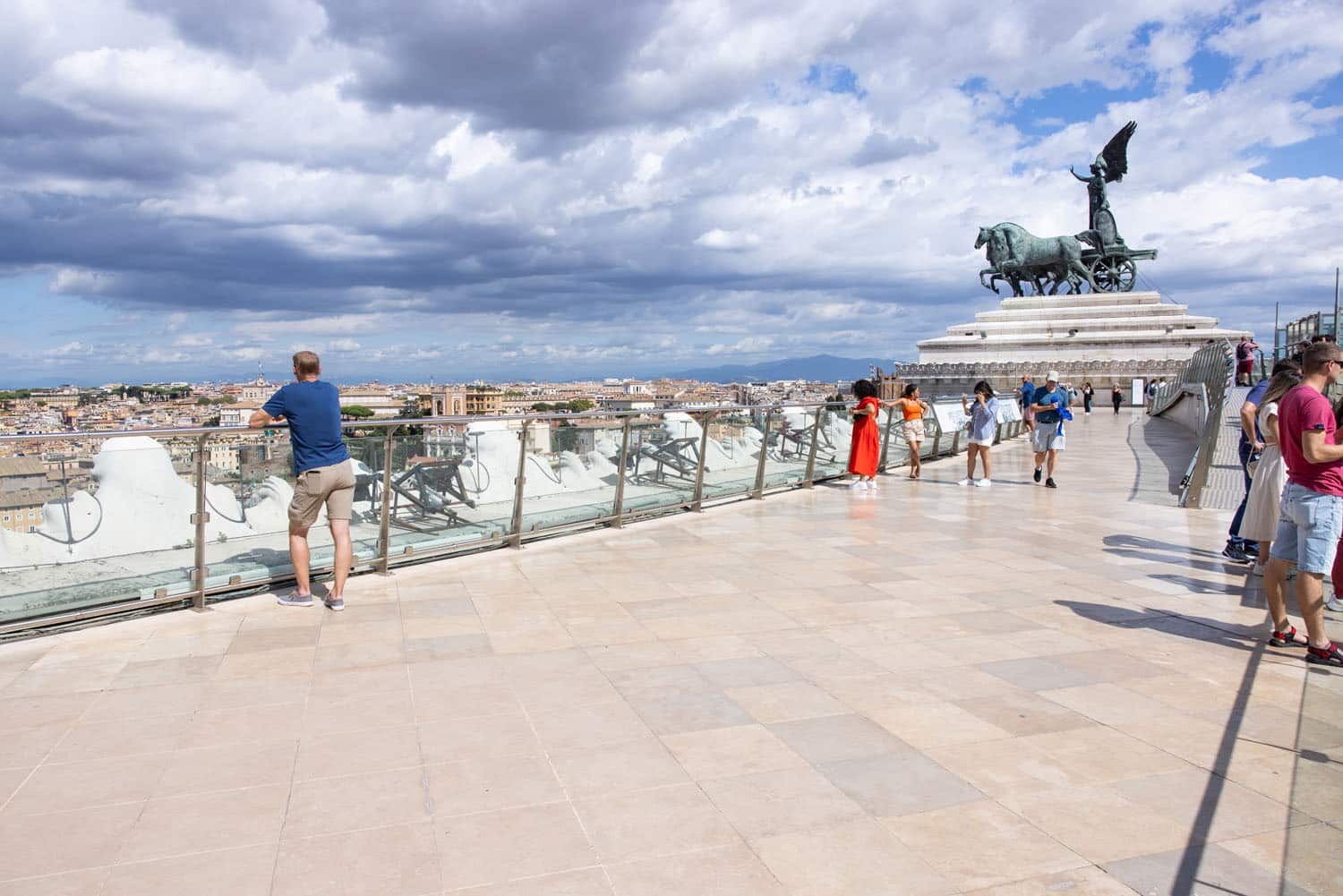
Highest terrace of Altar of the Fatherland
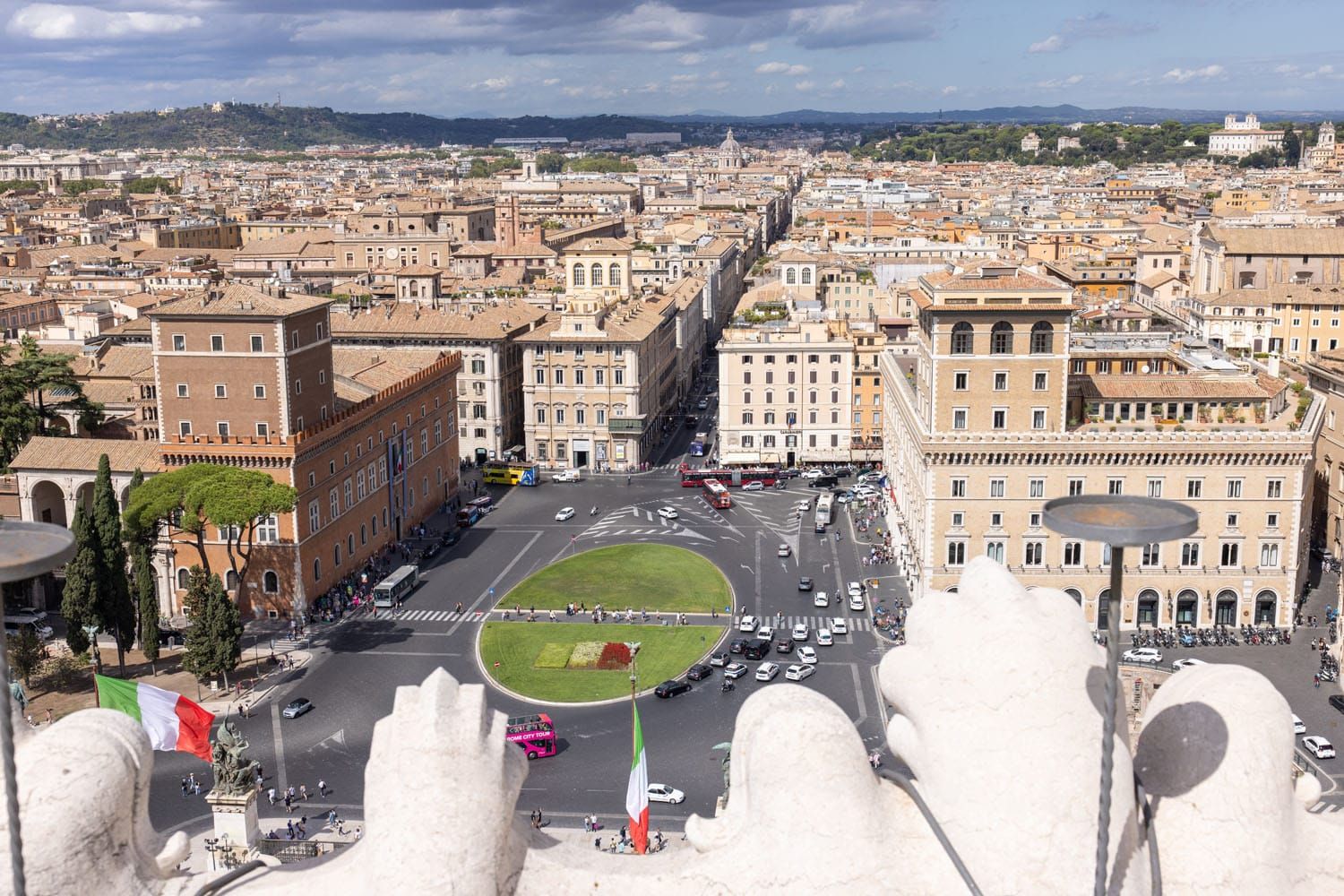
Piazza Venezia from the top of the Altar of the Fatherland
8. Trastevere
Trastevere is located on the west side of the Tiber River. This neighborhood is one of Rome’s best spots for dining and nightlife. Trastevere is a great mix of locals and tourists, charming cobblestoned streets, and some of the best restaurants in town.
On a visit to Rome, ending the day here, with a stroll through the streets and dinner at one of the cafes is a must-have experience.
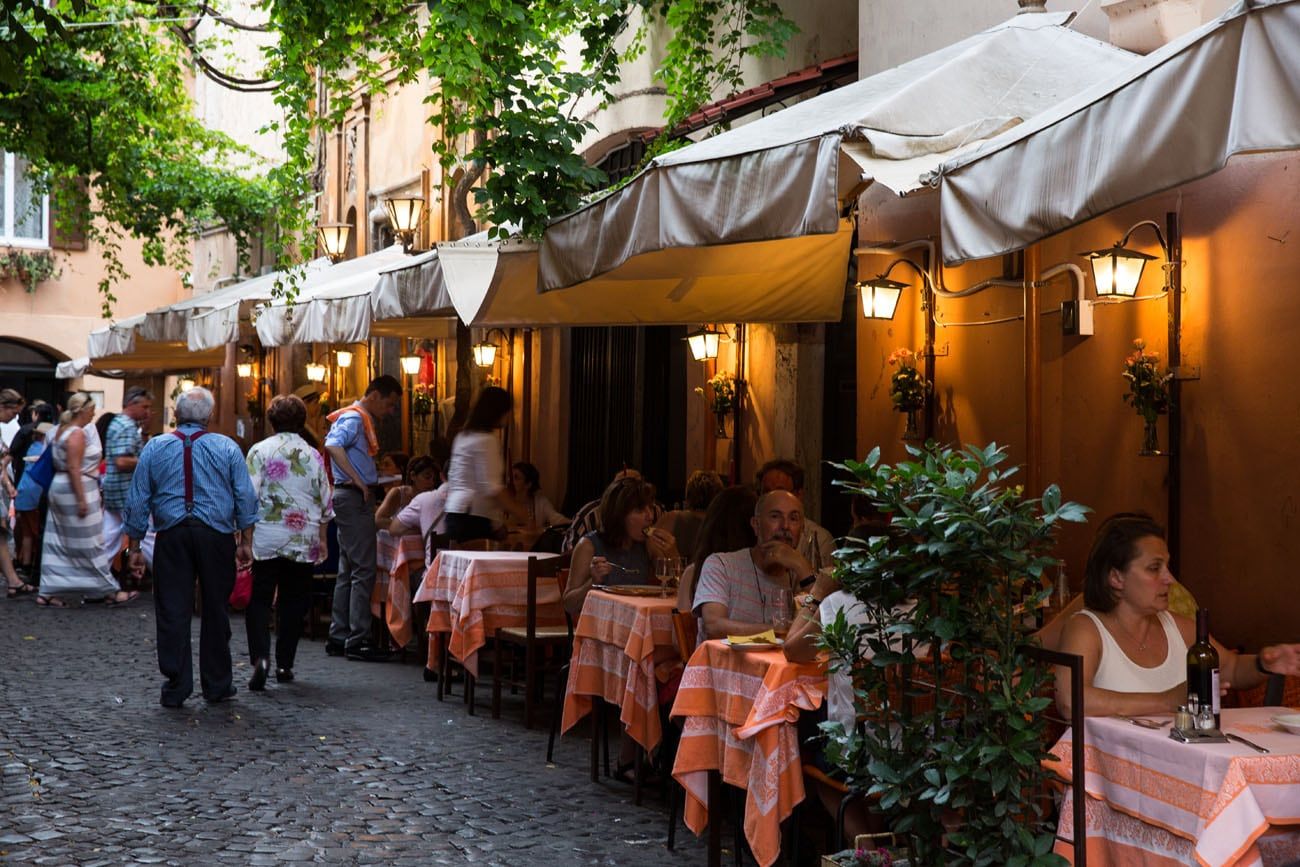
Trastevere
9. Tour an Underground Site
Descend below the level of the city streets to tour an ancient historical site. Here are a few of the top experiences.
The Catacombs
Many of the catacombs in Rome lie along Via Appia Antica, so it’s easy to combine both of these together in a half day trip from central Rome.
The Catacombs of San Callisto are the largest of Rome’s catacombs and about half a million Christians are buried here. The Catacombs of San Sebastiano contain the remains of St. Sebastian and possibly Peter the Apostle. Also on Via Appia Antica are the Catacombs of Domitilla, which are the only catacombs to still hold human remains.
The Capuchin Crypt
In several small chapels underneath the church of Santa Maria della Concezione dei Cappucchini are the skeletal remains of almost 4,000 Capuchin friars. The bones are arranged in artistic patterns. It’s morbidly fascinating and definitely an off-the-beaten-path location. Unfortunately, photographs are not permitted.
For updated hours and pricing, click here.
The Domus Aurea
The Domus Aurea is massive villa that was built by Emperor Nero.
In 64 AD, most of Rome was destroyed in a fire that raged for six days and seven nights. After the fire, Nero built a palace in the center of Rome, spanning 80 hectares. This immense, opulent palace, also called the Golden House, was covered in marble and gold. It had 300 rooms. After Nero’s death, the palace was stripped of its marble and jewels and much of the palace was filled with dirt, which helped preserve it.
The Domus Aurea was rediscovered in the 15th century. It recently underwent a massive renovation project and opened to visitors.
Domus Aurea can only be visited on a small group tour on limited days of the week. The most interesting part of the tour is wearing the virtual reality headsets to see what the palace may have looked like in its heyday.
Visit the official website for pricing, hours, and tour times.
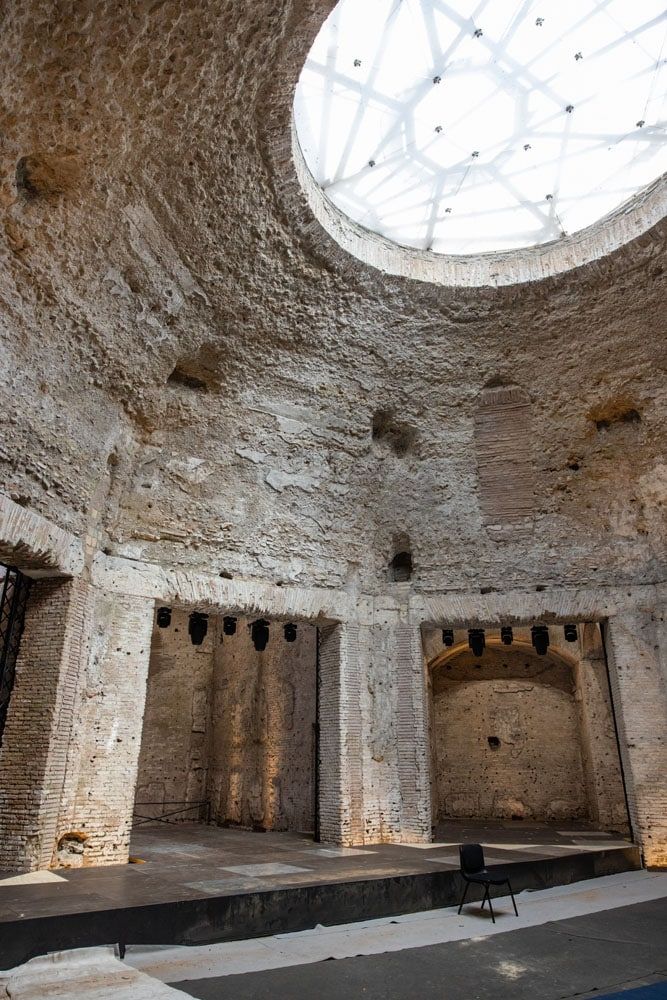
Domus Aurea

Inside the Domus Aurea. As part of the tour, you put on a virtual reality headset and can see what Domus Aurea may have looked like.
10. Best Views of Rome
One of the best things to do in Rome is to get a view of the city’s iconic spots. From breathtaking aerial views (from the dome of St. Peter’s Basilica and the Altar of the Fatherland) to strolls along the Tiber River and the historic heart of Rome, there are many places to capture the city on your smartphone or camera.
The Photographer’s Guide: 20 Iconic Views of Rome
Exactly where to get the best views of Rome.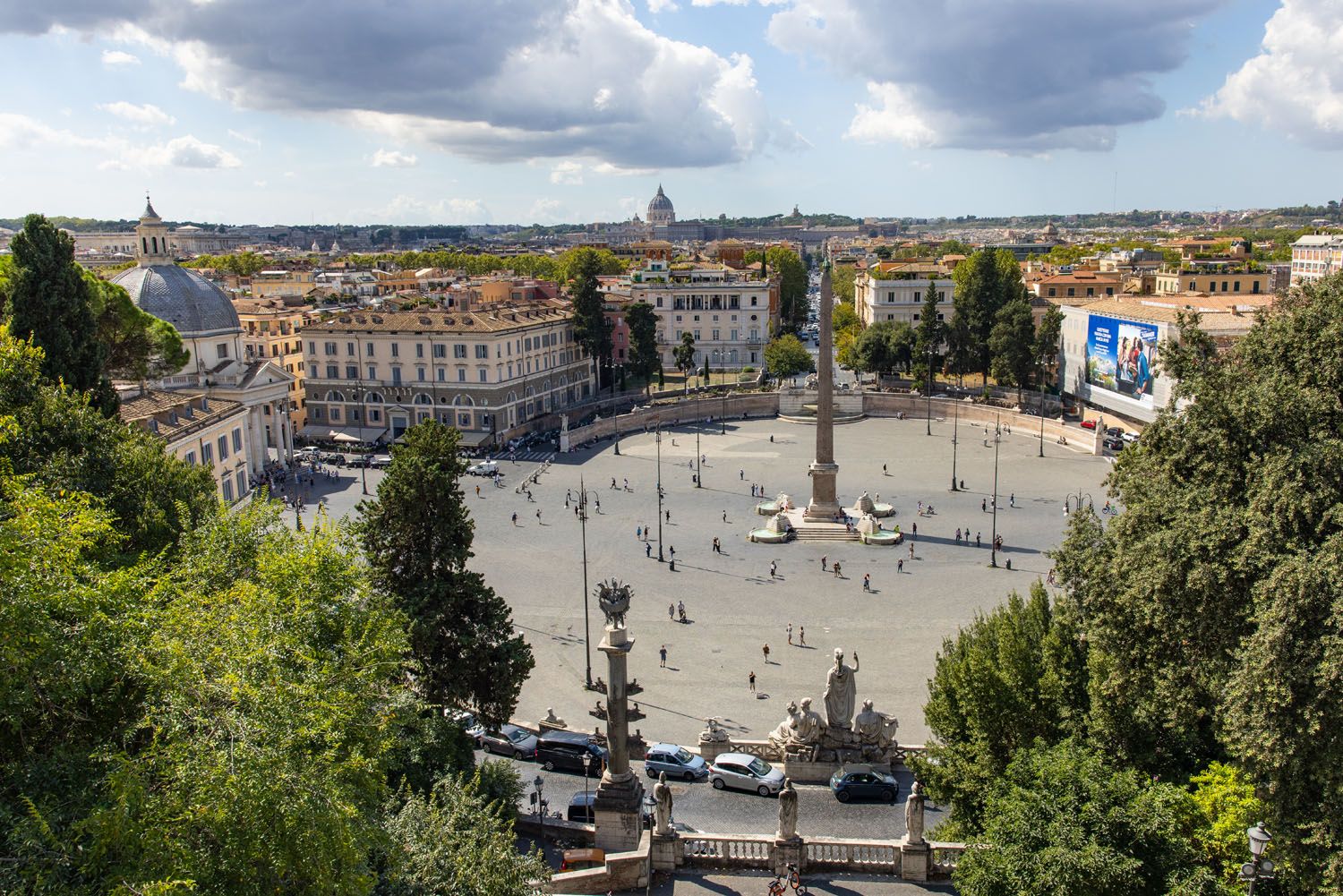
Piazza del Popolo from the Pincio Terrace
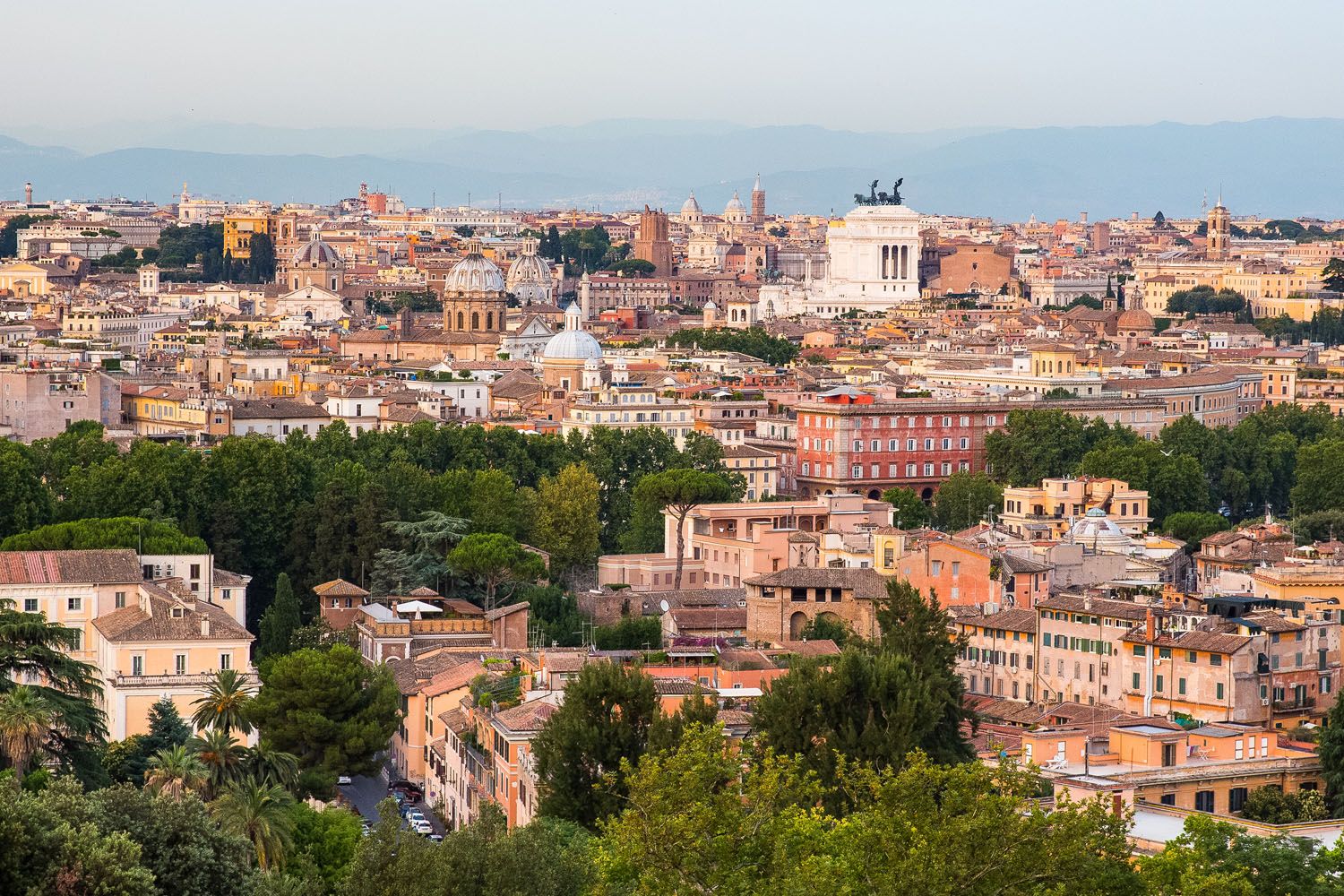
Belvedere del Gianicolo
Go Deeper: More Things to Do in Rome
11. Take a Food Tour of Rome
One of the best things to do in Rome is to take a food tour. These walking tours combine some of Rome’s most interesting neighborhoods with local foods.
This highly rated street food tour takes visitors through Trastavere or the Jewish Quarter.
Or take a sunset food tour of Trastevere or this food tour which also includes a visit to a market.
12. Appian Way
The Appian Way is a marvel of Roman engineering at the time it was constructed 2000 years ago. This road was built to connect Rome to Brindisi.
Many monuments lie along this road, including the Circus of Maxentius and numerous catacombs. One of the best ways to explore the Appian Way is to rent bikes and cycle along this very historic, and bumpy, road. If you will be visiting with kids, this is one of the best things to do in Rome. Tyler and Kara loved this when we were in Rome on our first visit. You can read more about our experience in our article about the Appian Way.
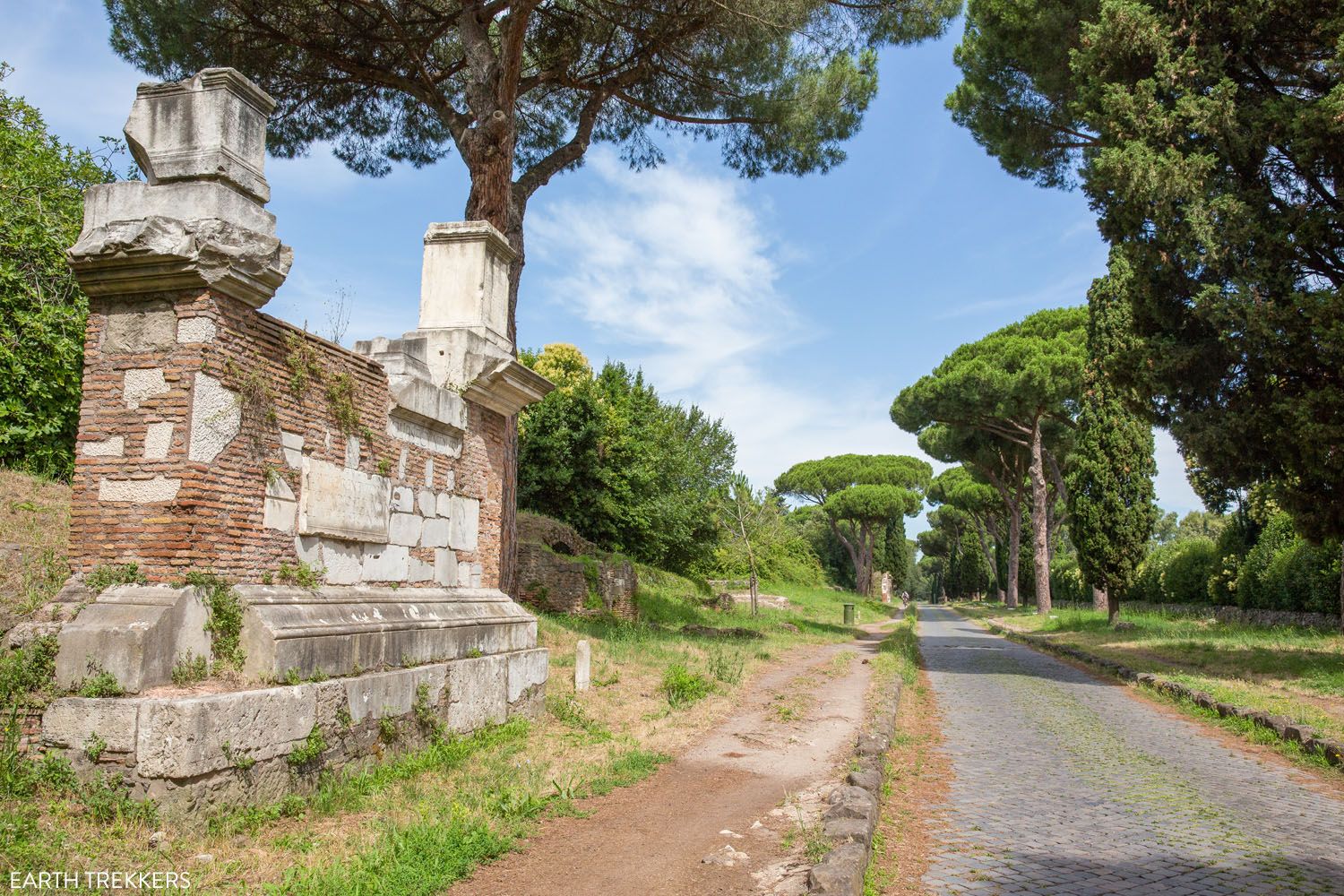
Appian Way
The Appian Way is not located in historic city center. You can get here by bus or taxi. There are also numerous tours that include an e-bike tour of Via Appia Antica with the option to add on the catacombs.
Appian Way Tours
13. Rooftop Bars in Rome
One of the best things to do in Rome is to visit a rooftop bar, enjoy the view, while having a drink or dinner. There are quite a few rooftop bars to choose from. Our favorite is Oro Bistrot. The view from this rooftop bar is awesome, as you look across the Trajan Forum to the Altar of the Fatherland (the header photo for this article was taken here). The food and drinks are great, too.
Three other notable rooftop bars include Divinity Rooftop and AcquaRoof Terrazza Molinari. Imago on top of Hotel Hassler Roma is a Michelin restaurant with a stunning view of the Spanish Steps. For the full list, check out our guide to the Best Rooftop Bars in Rome.
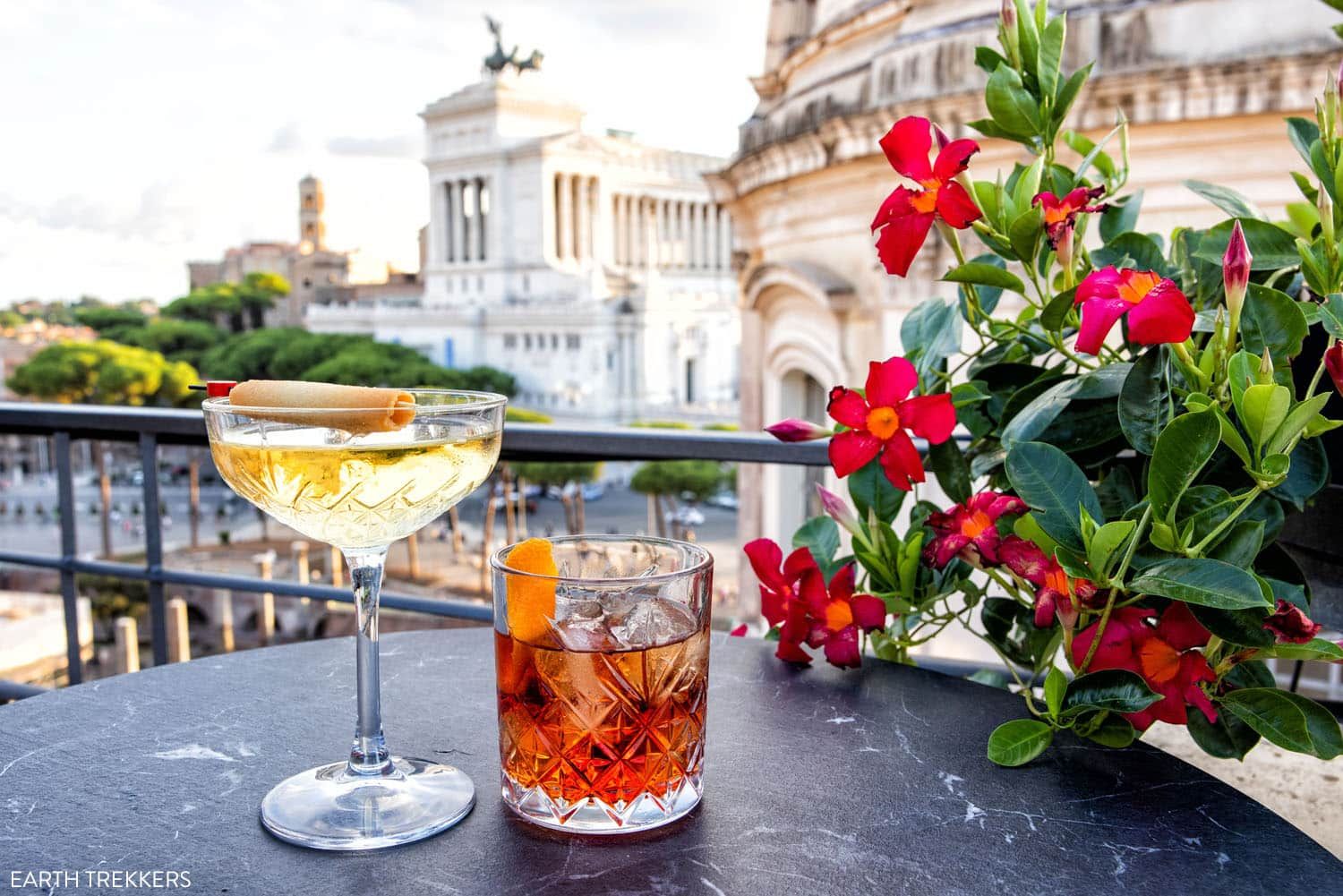
Oro Bistrot
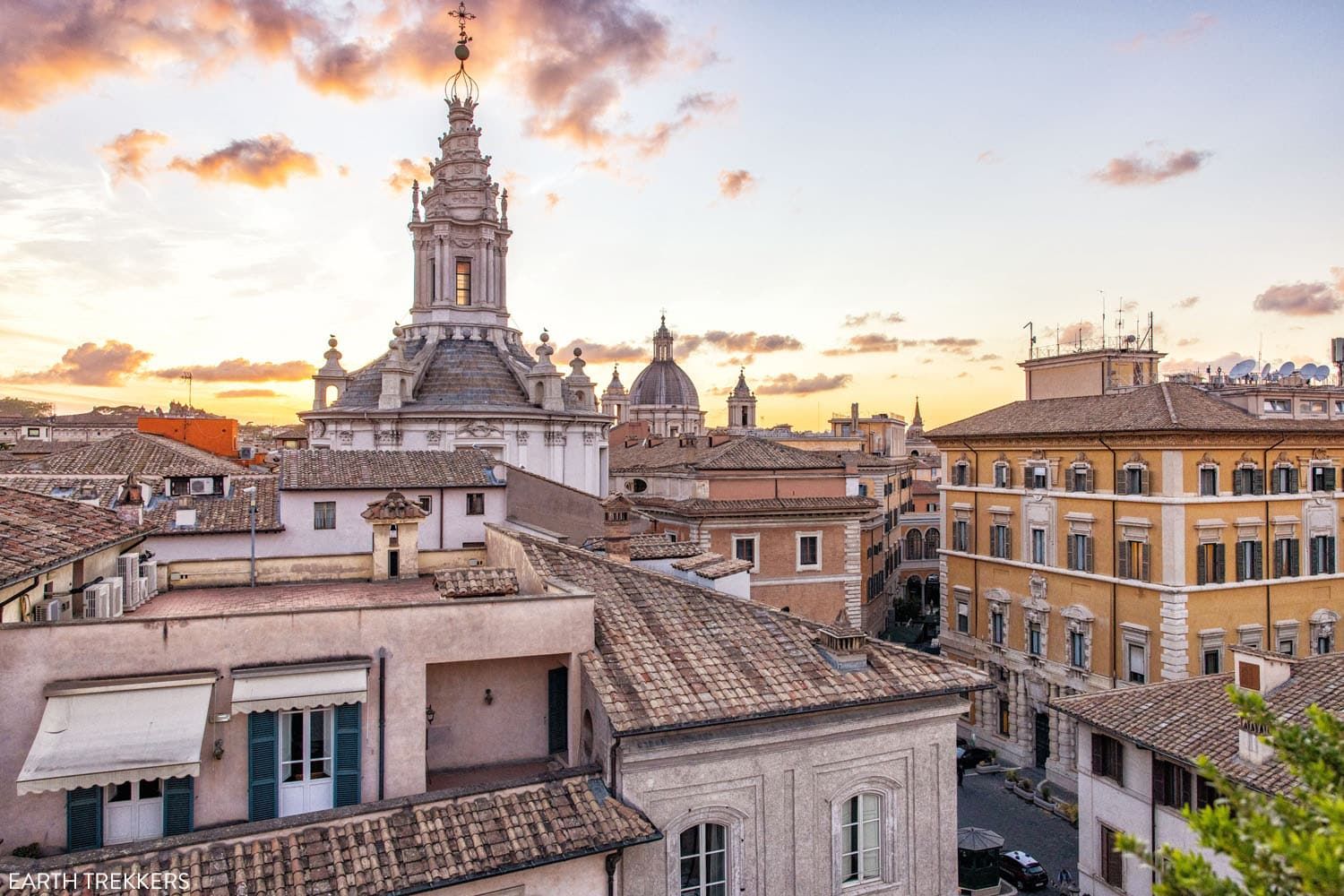
Divinity Rooftop
14. Castel Sant’Angelo & Views from the Tiber River
Castel Sant’ Angelo, also known as the Mausoleum of Hadrian, was originally built as a mausoleum for Emperor Hadrian and his family. Later, it was used as a fortress, a prison, a castle, and now it is a museum.
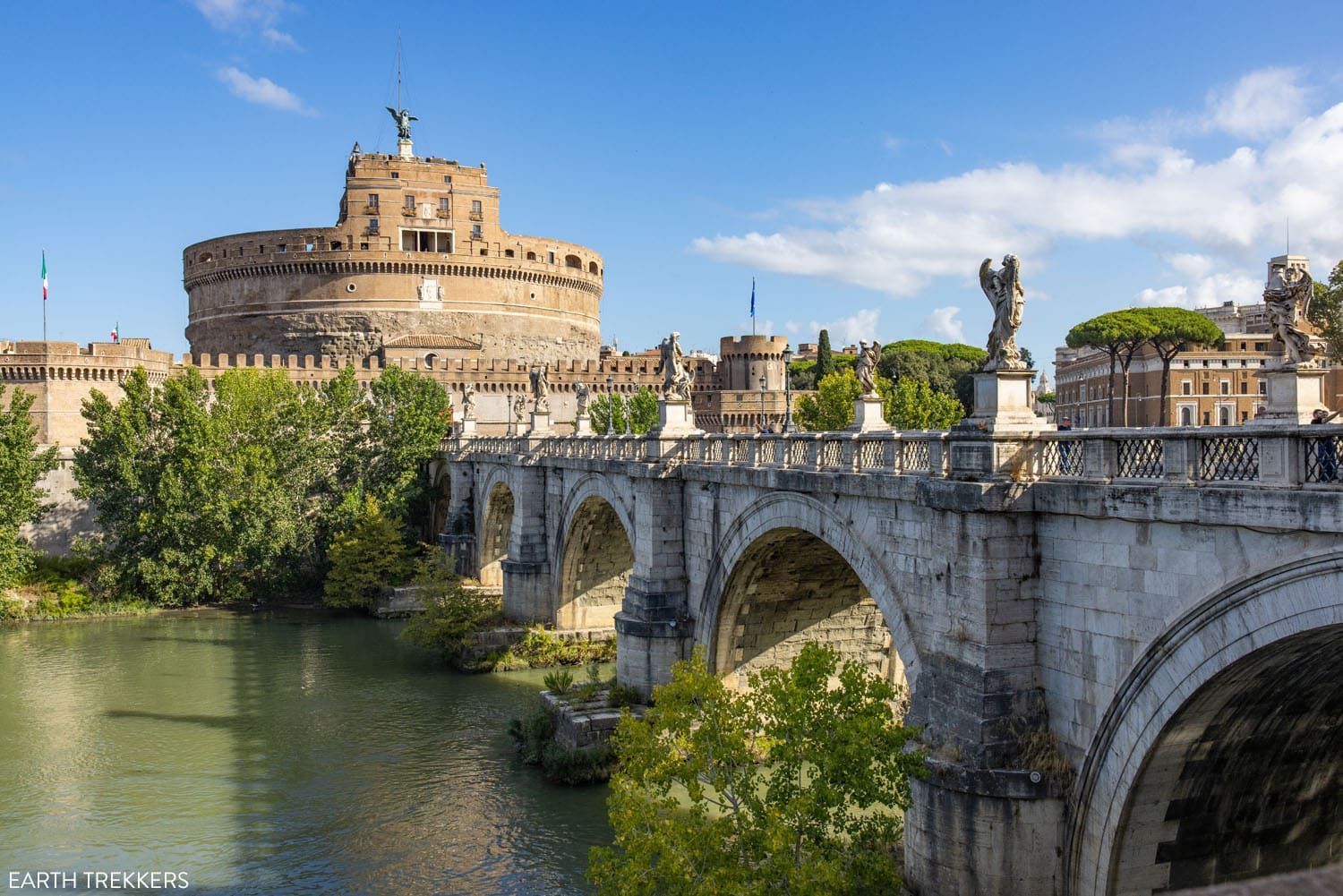
Castel Sant’Angelo
Our favorite part of visiting Castel Sant’Angelo were the views from the upper terrace, looking out across Rome.
During your visit, you will follow a walking route through the fortress. First, you make a loop around the lower level. At the end of this loop, you will enter the center building, and climb to the top on a series of ramps and steps.
From the highest terrace of Castel Sant’Angelo you have almost 360° views of Rome.
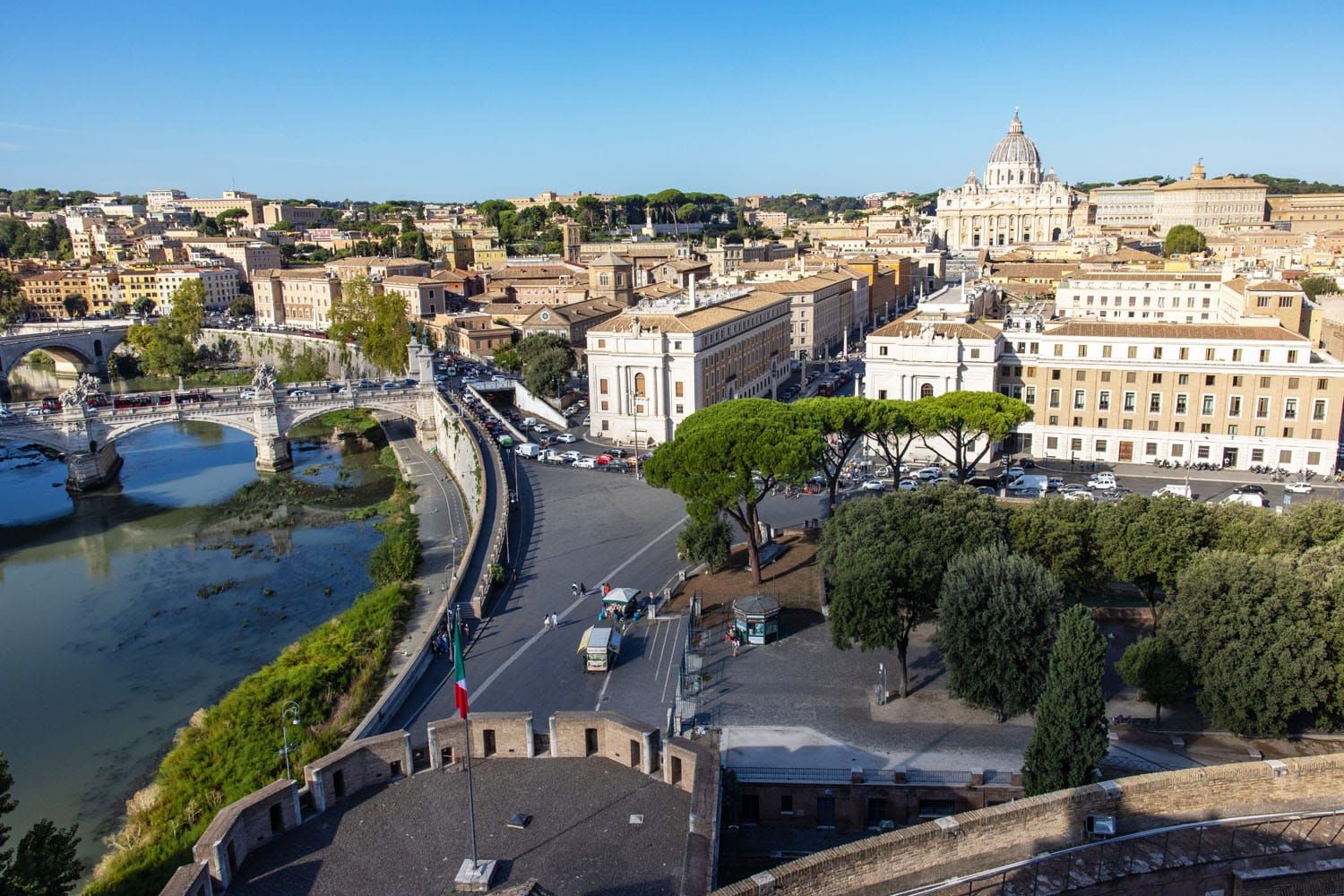
View from Castel Sant’Angelo
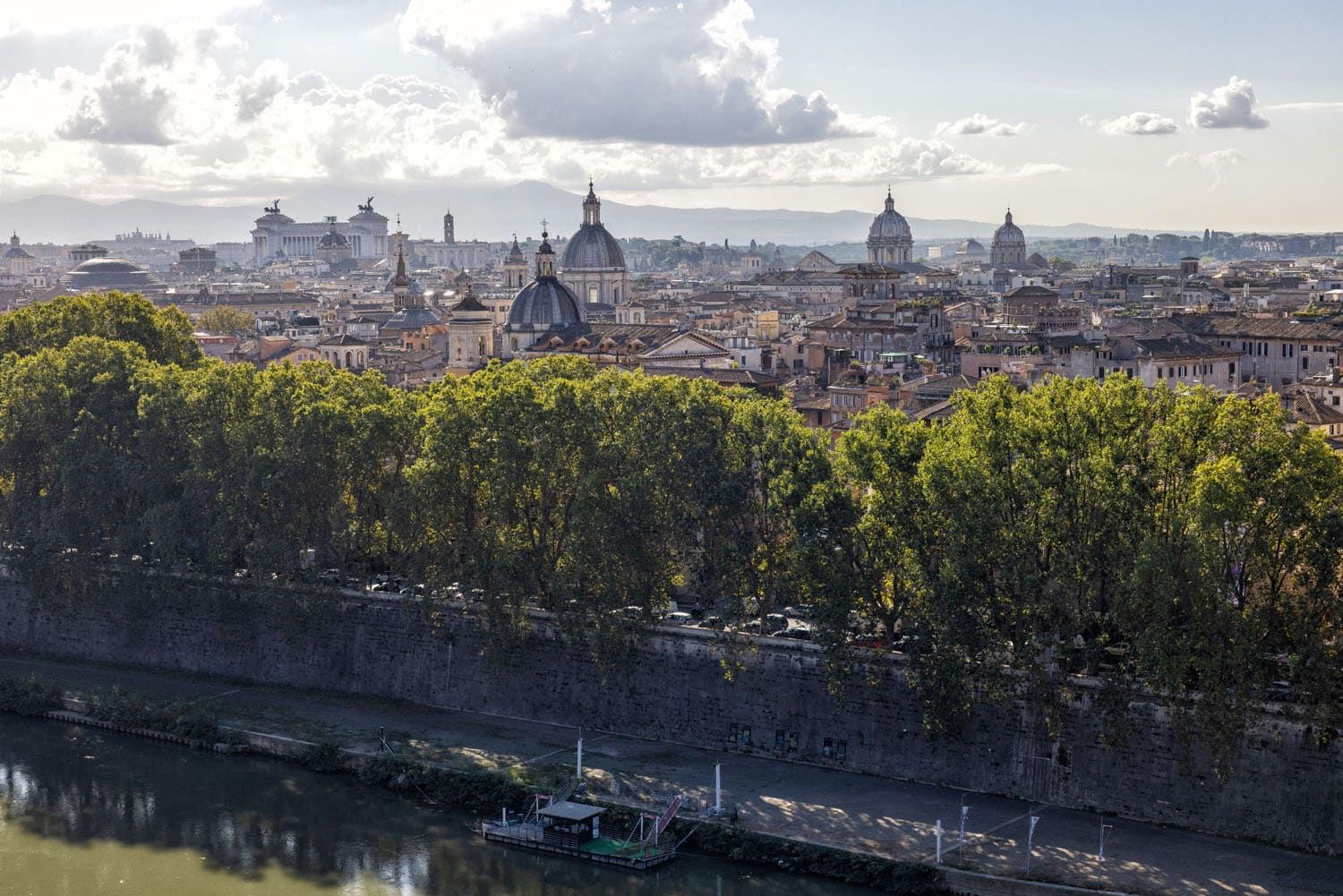
Another view from Castel Sant’Angelo
PHOTOGRAPHY TIP: Our visit was right at opening time and these photos were taken around 9:30 am. The lighting towards St. Peter’s Basilica is perfect this time of day but the city center of Rome looks hazy. For the best lighting for photos of the historic center of Rome, plan your visit for the afternoon.
Views from the Tiber River
There are several places near Castel Sant’Angelo where you can take an iconic shot of the Tiber River, Castel Sant’Angelo, and Vatican City.
Ponte Sant’Angelo
For a great view of Castel Sant’Angelo, walk down Ponte Sant’Angelo (St. Angelo Bridge), the bridge that crosses the Tiber River in front of the entrance into the castle. Once at the far end of the bridge, turn around and look back. This is a great spot to photograph the castle with the angels that line the bridge.
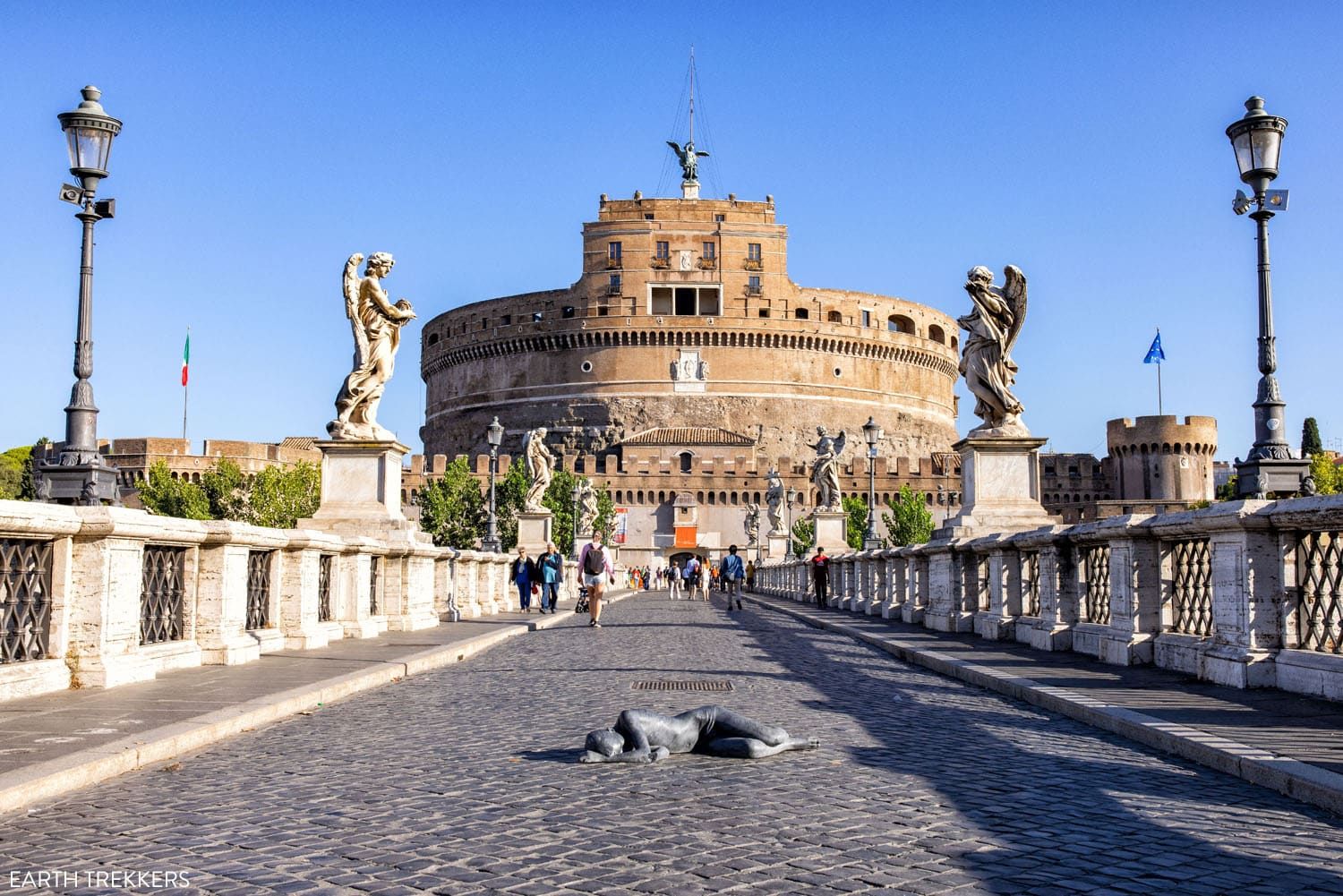
Ponte Sant’Angelo
Ponte Vittorio Emanuele II
From Ponte Sant’Angelo, it is a 2-minute walk to this bridge. From here, you can photograph Castel Sant’Angelo and Ponte Sant’Angelo. It’s worth the short walk to this bridge for a slightly different view of the castle.
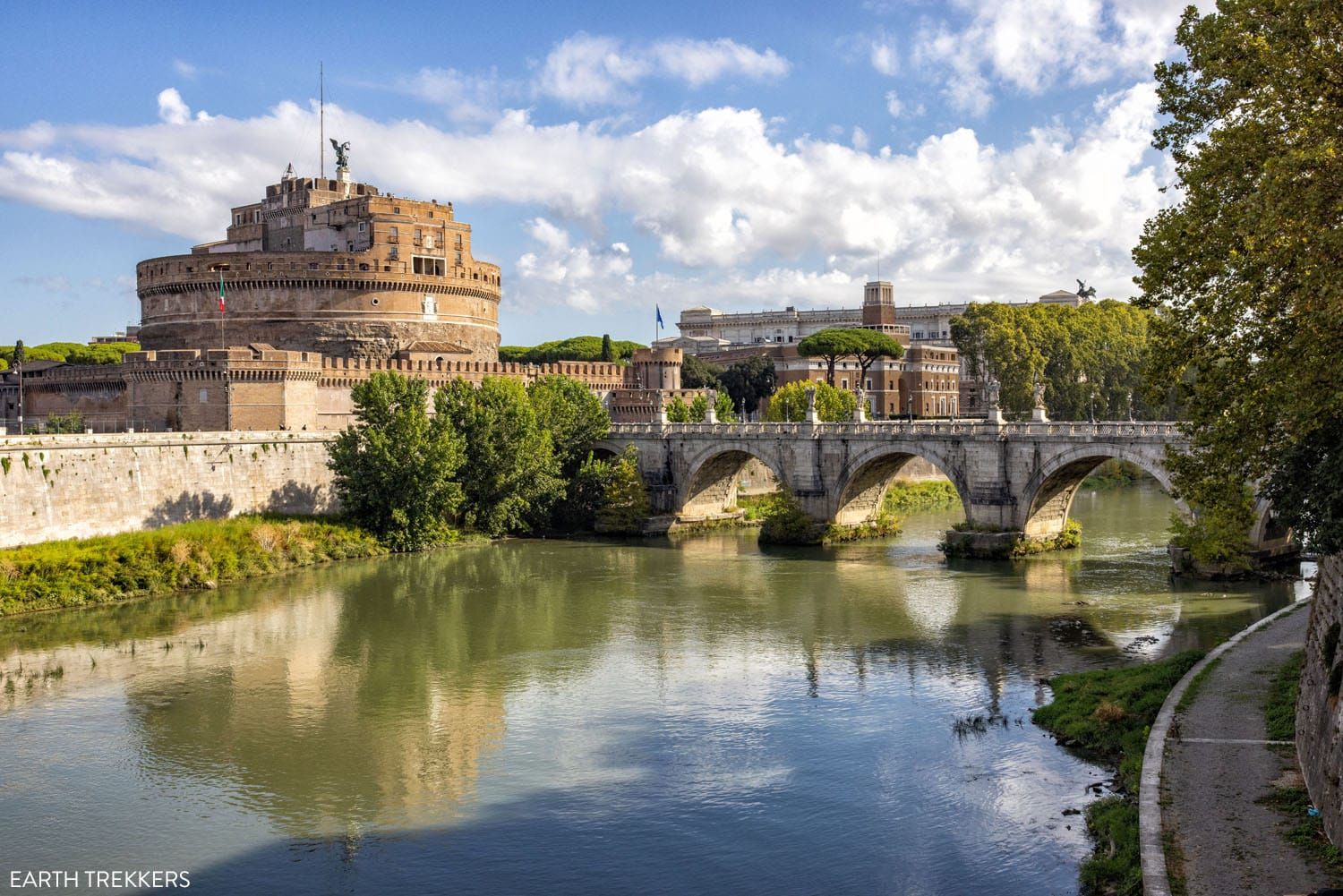
The view from Ponte Vittorio Emanuele II
Ponte Umberto I
This bridge sits to the east of Ponte Sant’Angelo. From this bridge, you can photograph Ponte Sant’Angelo and St. Peter’s Basilica along with the Tiber River. You will not see Castel Sant’Angelo from this bridge since trees block the view.
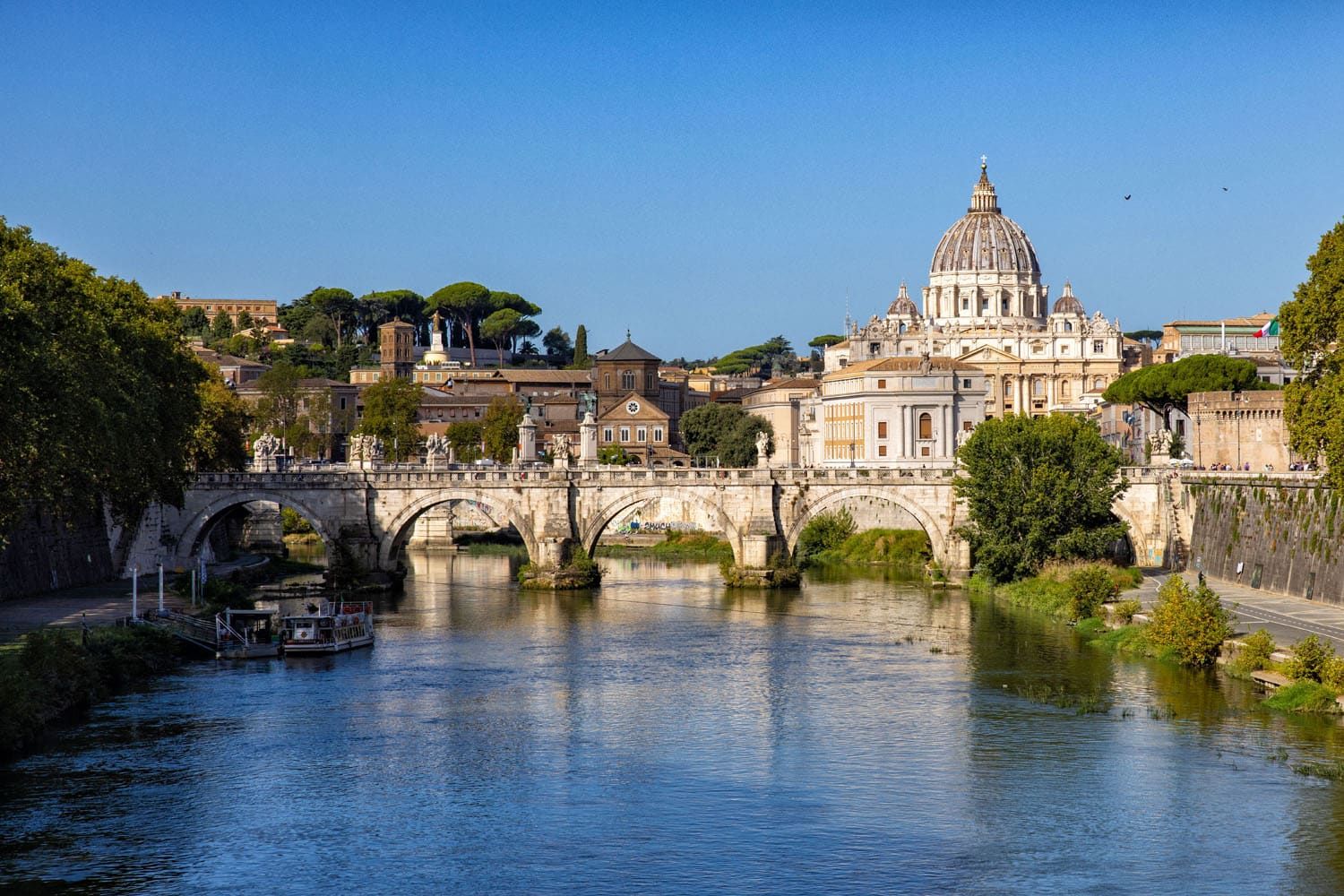
The view from Ponte Umberto I
15. Capitoline Hill & Museums
Capitoline Hill is located in between the Roman Forum and the Altar of the Fatherland. Sitting on top of Capitoline Hill is Campidoglio Square, a piazza that was originally designed by Michelangelo.
Sitting around this square are several historical buildings, the Capitoline Museums, and a few more viewpoints of Rome.
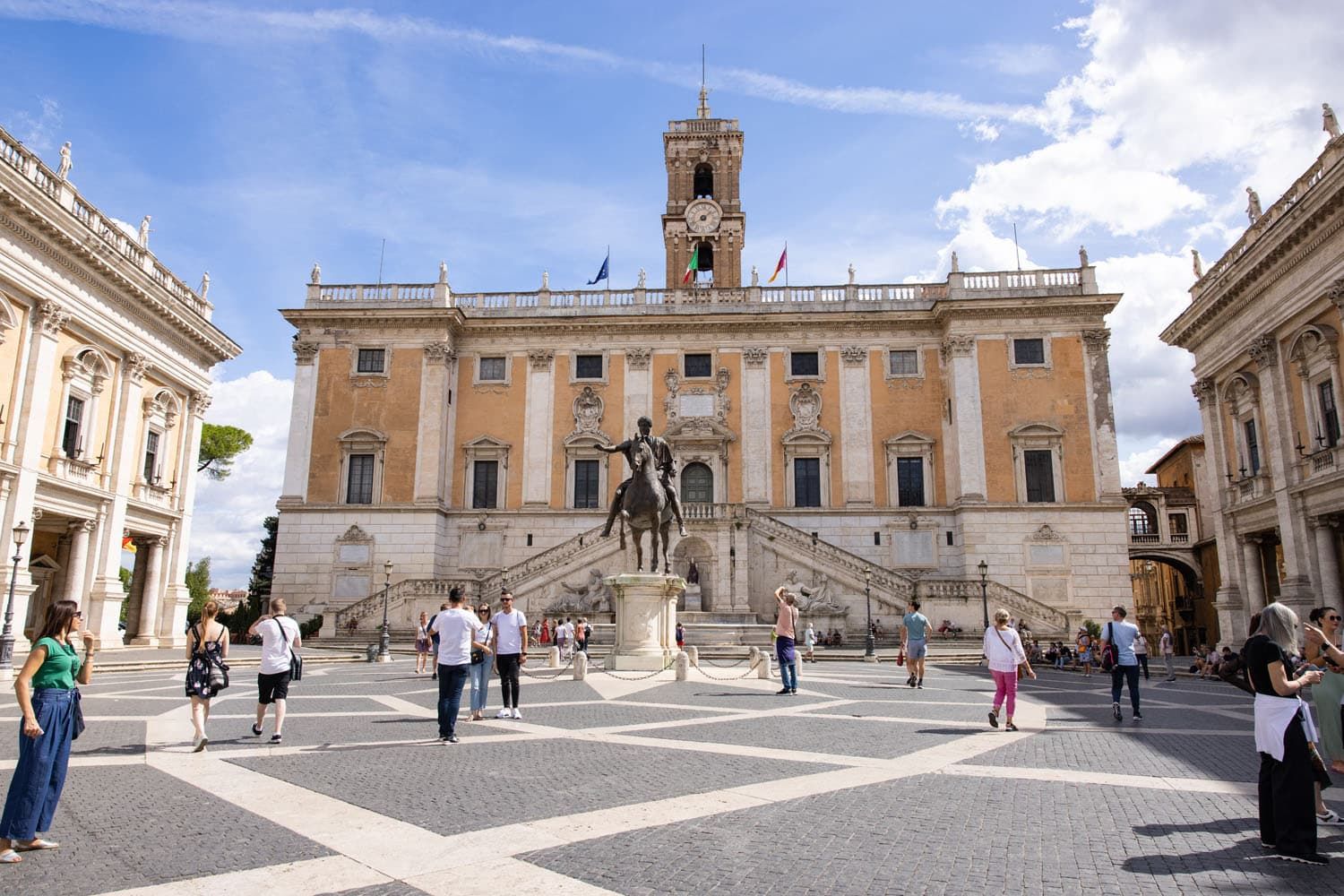
Campidoglio Square
Capitoline Museums (Musei Capitolini)
The Capitoline Museums are located inside of Palazzo dei Conservatori and Palazzo Nuovo. These museums contain works of art by Caravaggio, Rubens, and Tiziano. Be sure to see the equestrian statue of Marcus Aurelius (a copy of this statue sits in Campodoglio Square) and the original statue of the she-wolf suckling Romulus and Remus, called the Capitoline Wolf (a replica of this statue sits next to the Senatorial Palace).
For hours and pricing, visit the official website.
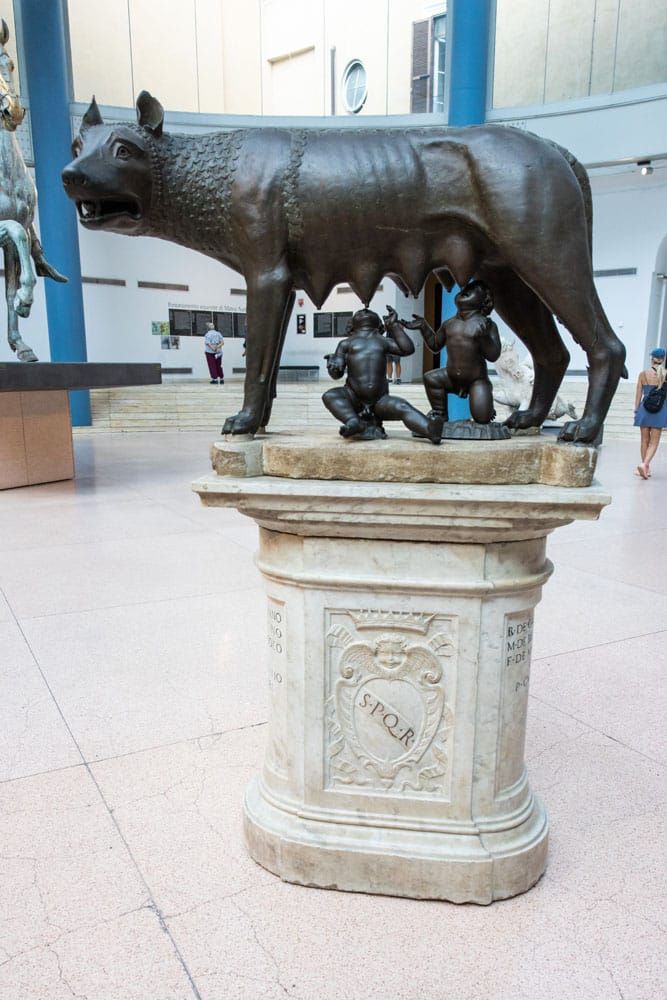
The Capitoline Wolf
Views of the Roman Forum
For the best viewpoint of the Roman Forum from Capitoline Hill, walk between Palazzo dei Conservatori and the Senatorial Palace along Via del Campidoglio to Terrazza sul Foro for another great view of the Roman Forum.
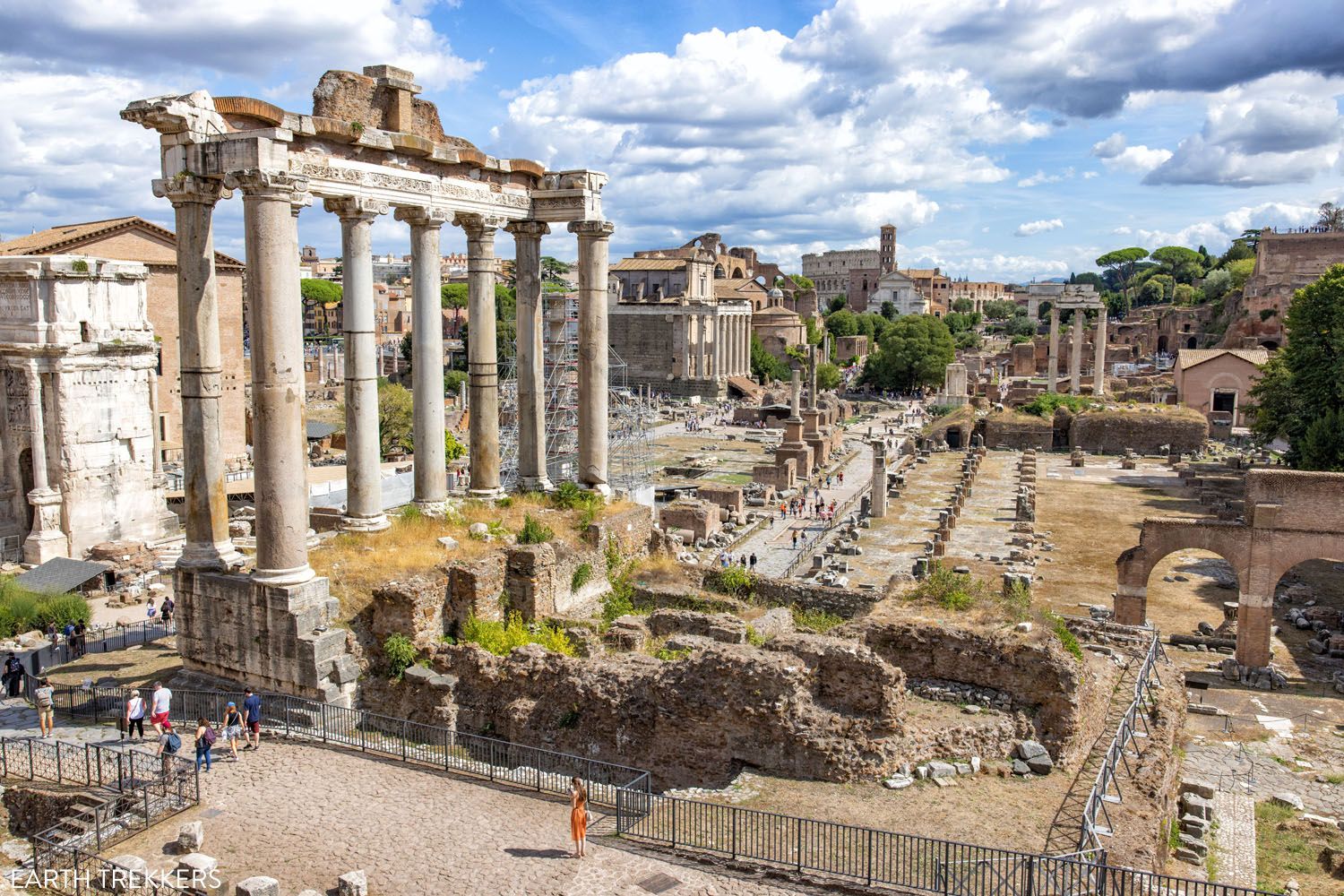
The view from Terrazza sul Foro
There is a second viewpoint of the Roman Forum and Via dei Fori Imperiali. It’s not quite as good, but it is just a short walk to get here. From Campidoglio Square, walk between the Senatorial Palace and Palazzo Nuovo, look for the replica of Lupa Capitolina (the she-wolf statue) on your right, and walk out to the terrace for this view:
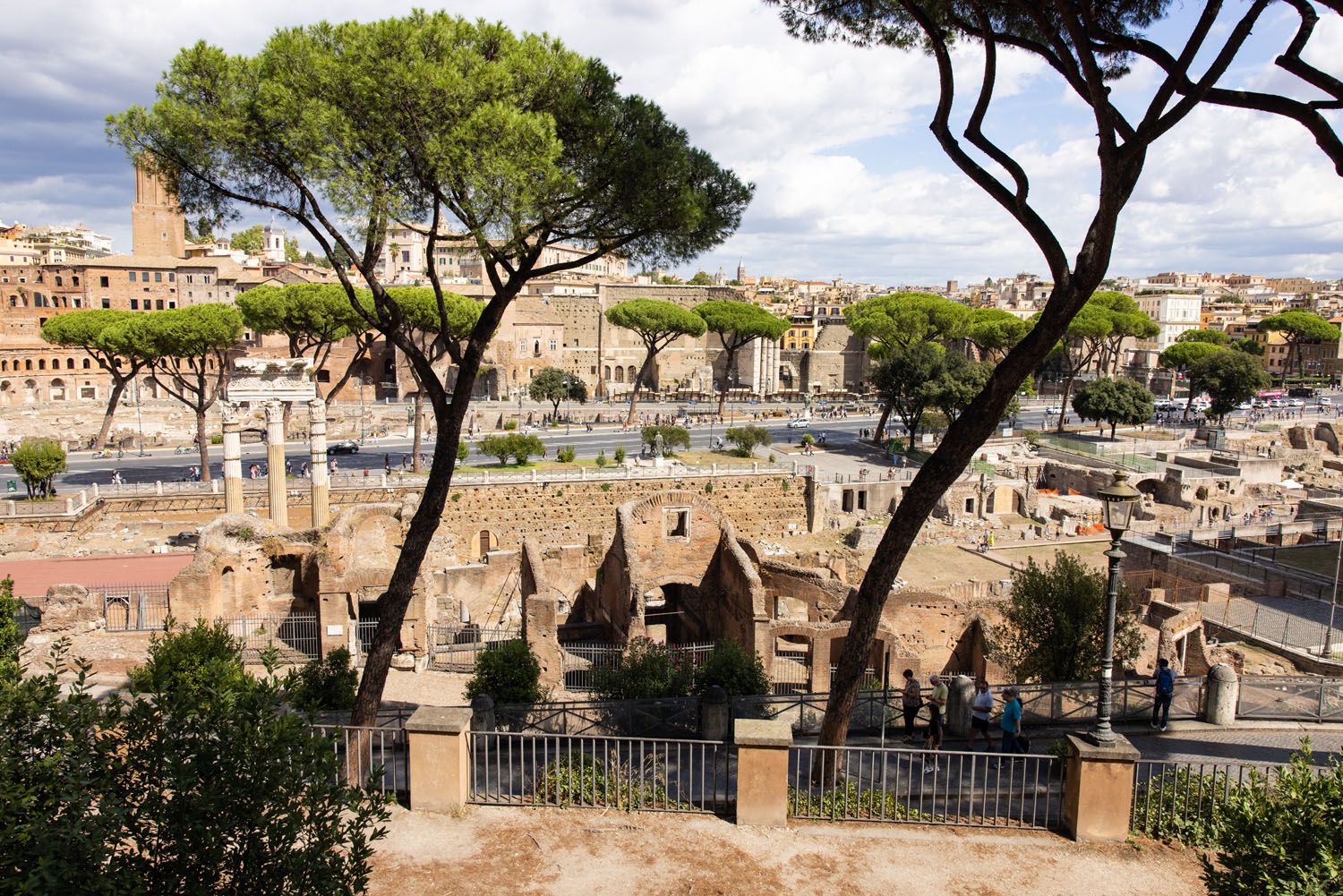
View of Via dei Fori Imperiali and a portion of the Roman Forum
16. The Mouth of Truth (Bocca della Verità)
This marble mask is located in the portico of the Santa Maria in Cosmedin church. Legend has it that it will bite off the hand of anyone who tells a lie while their hand is inside of the mouth.
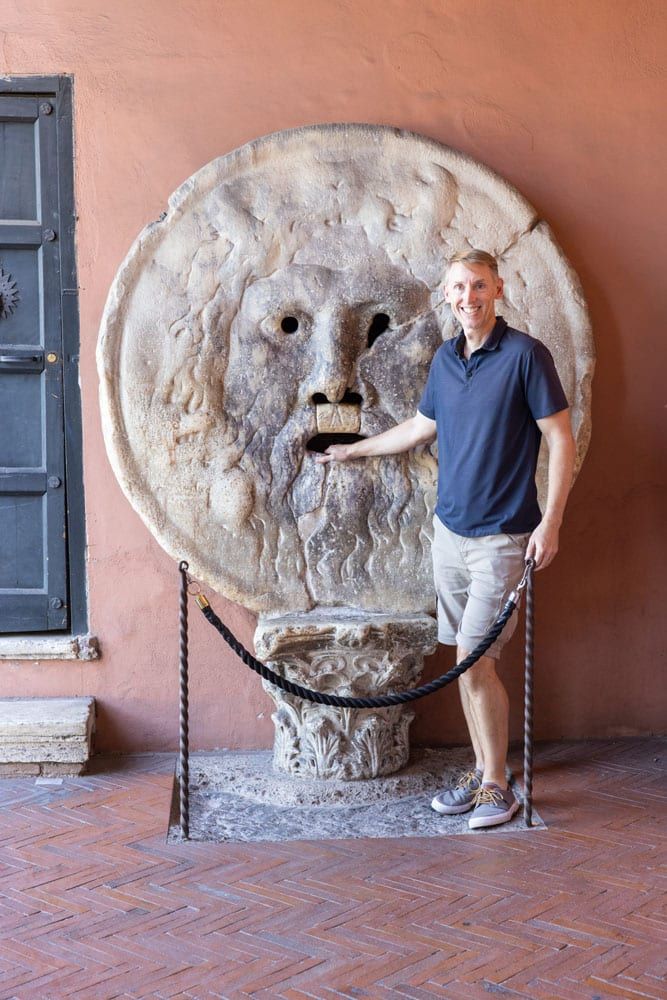
Mouth of Truth
After seeing the Mouth of Truth, you have the option to enter Santa Maria in Cosmedin. Inside, you can visit the crypt and see the skull of St. Valentine, which sits in a side altar on the left side of the church.
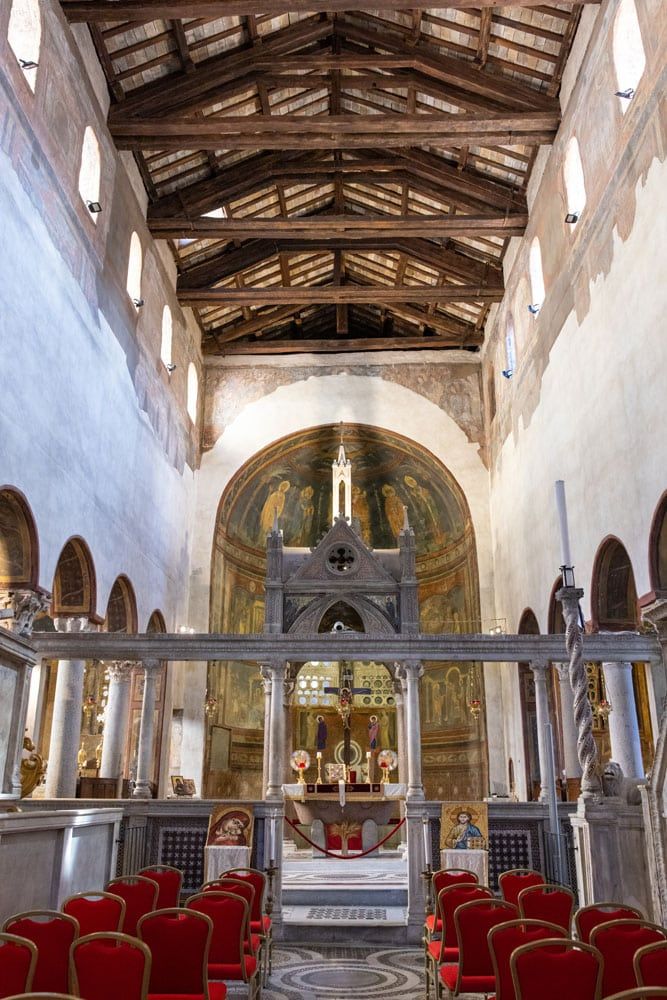
Santa Maria in Cosmedin
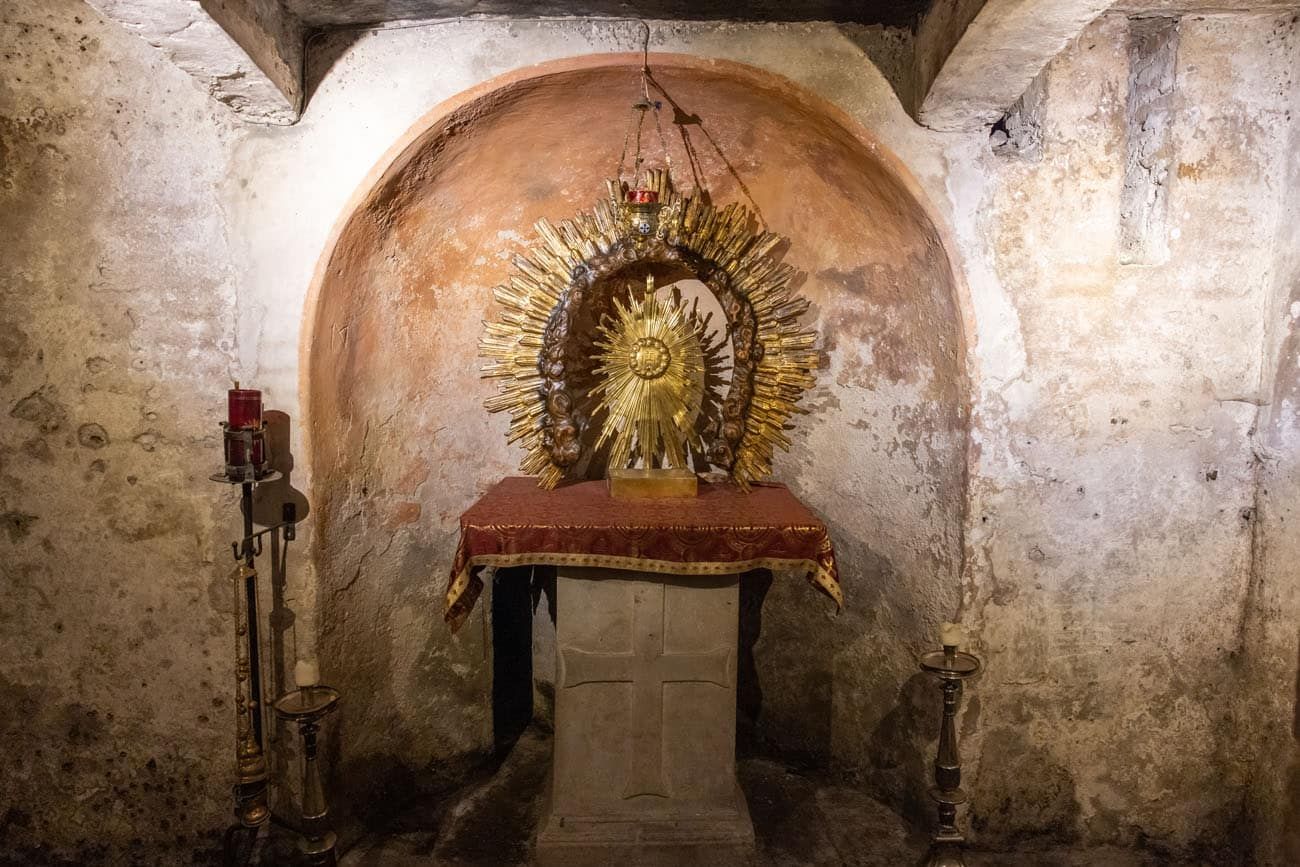
Hadrian’s Crypt
17. Forum of Augustus and Trajan Forum
These two archaeological sites sit side by side, just a short walk from the Roman Forum and the Colosseum.
The Forum of Augustus (Foro di Augusto) was built by Emperor Augustus from 42 to 2 BC to celebrate the success of the battle against Cassius and Brutus, the assassins of Julius Caesar.
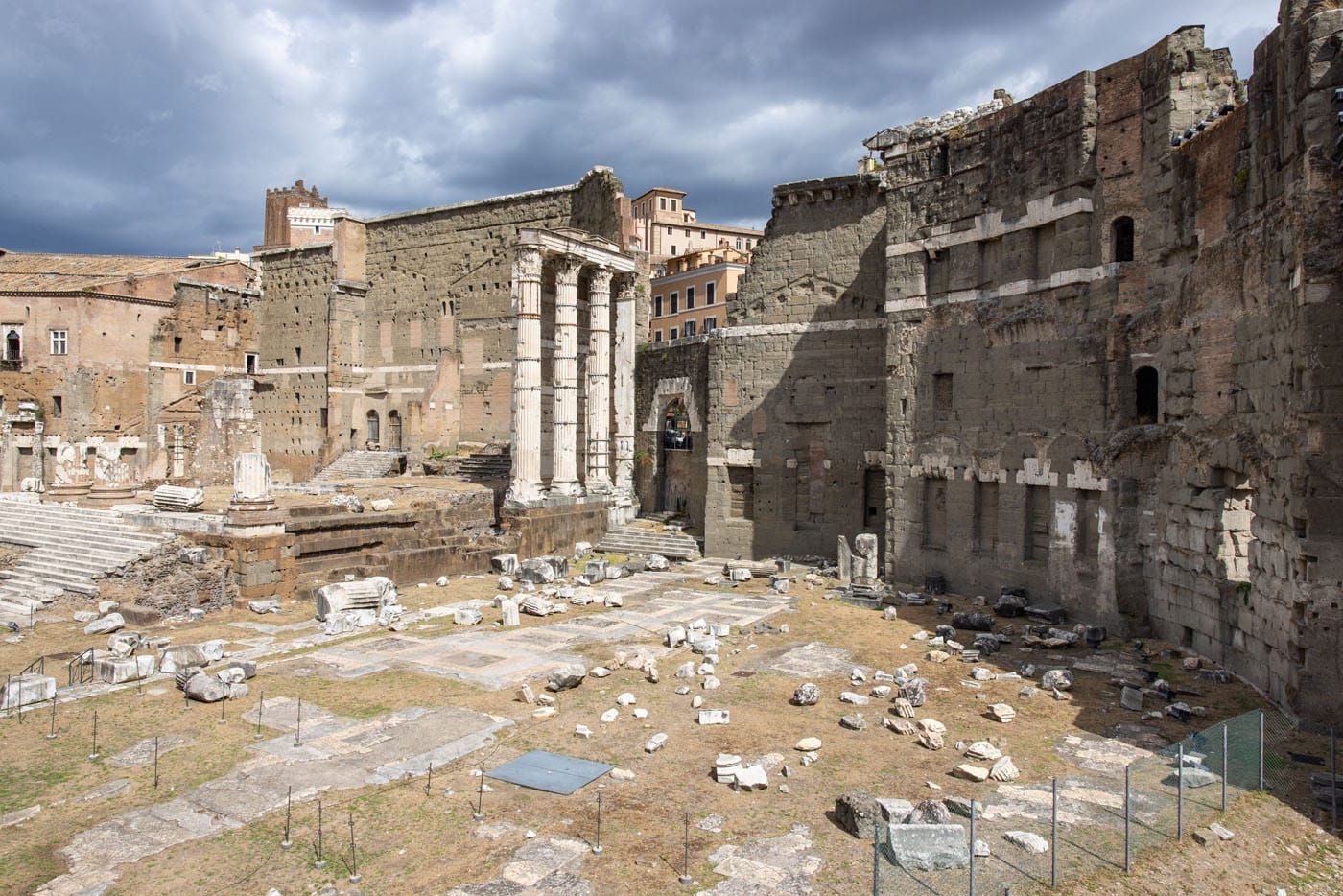
Forum of Augustus
Trajan Forum (Foro Traiano) was inaugurated in 112 AD and it was the final forum to be built in Rome. Trajan’s Column, which still stands in the forum, was erected in 113 AD.
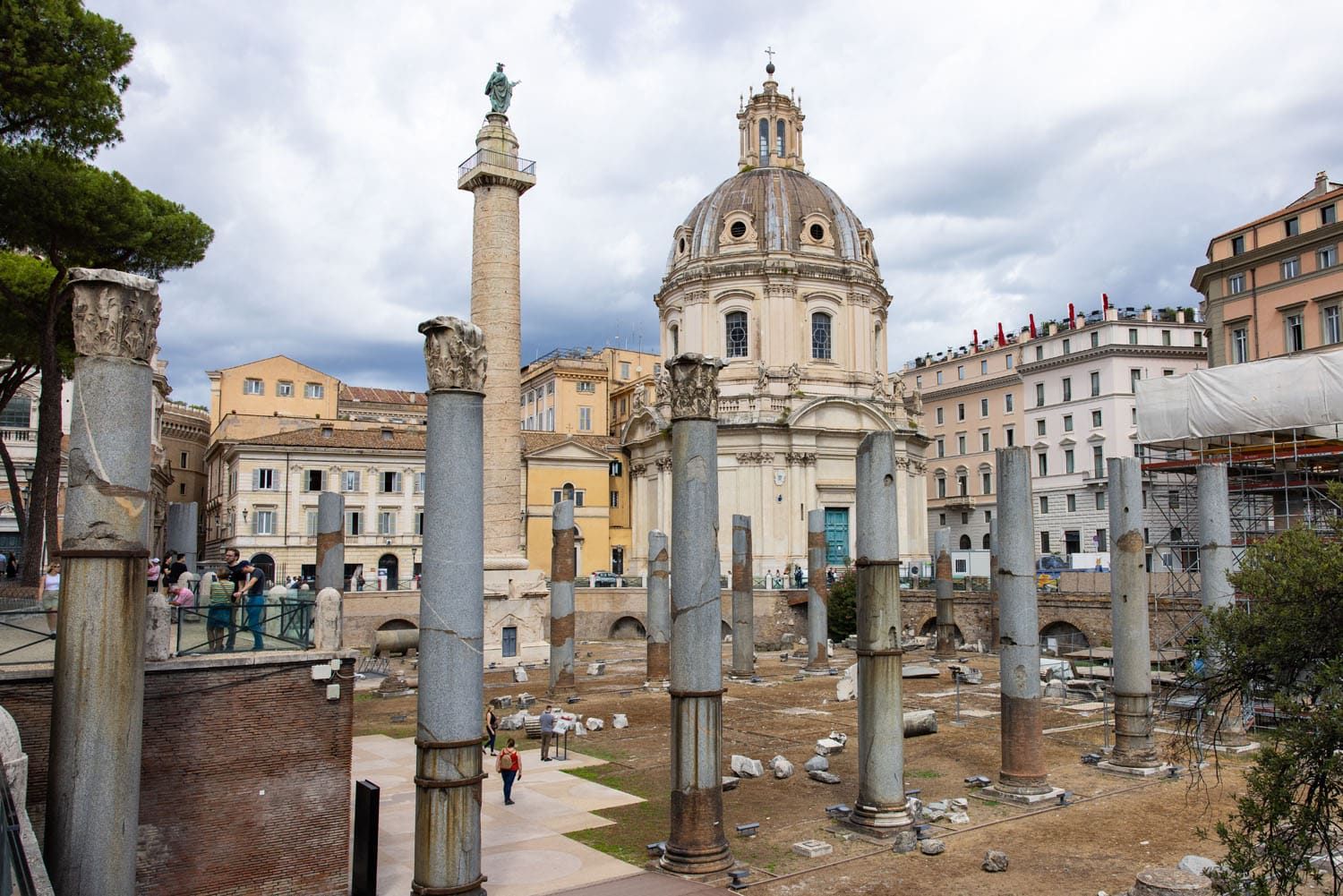
Trajan Forum
Both of these forums can be seen while walking along Via dei Fori Imperiali and Via Alessandrina, which runs alongside the Roman Forum and connects the Colosseum to Piazza Venezia.
18. Basilica of Saint John Lateran
This basilica, which also goes by the name Basilica di San Giovanni in Laterano (in Italian), is the seat of the bishop of Rome, the pope. This church, and the Scala Sancta (mentioned next) are located on an extraterritorial property of Vatican City.
It was founded in 324 AD, making it the oldest basilica in the Western world. This basilica is one of the four major papal basilicas in Rome.
A visit here is free, but for a few more euros, you can visit the cloister and monastery, which is well worth it.
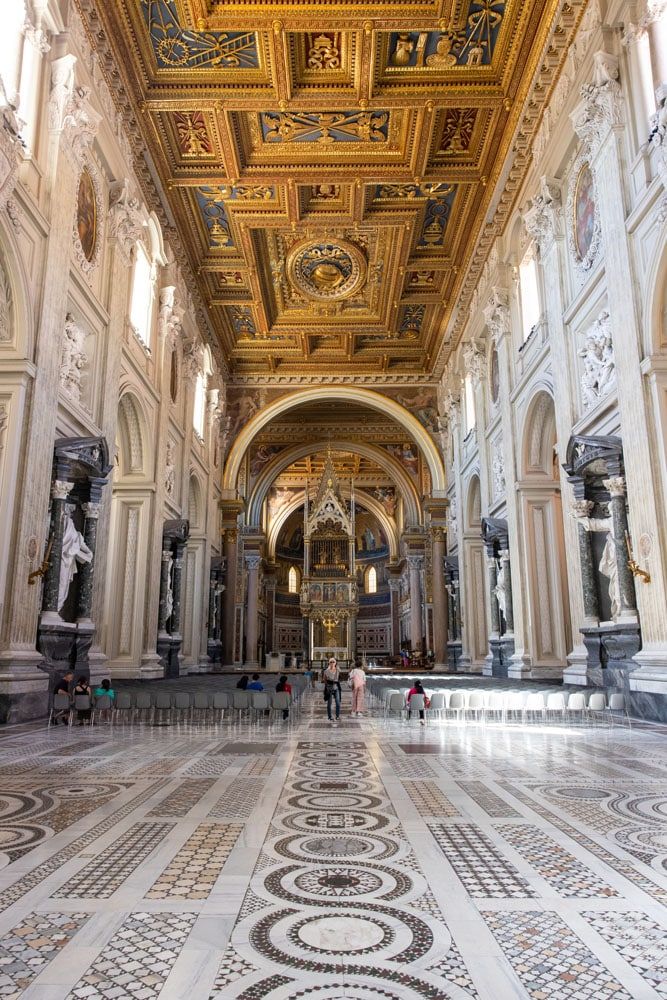
Basilica of Saint John Lateran
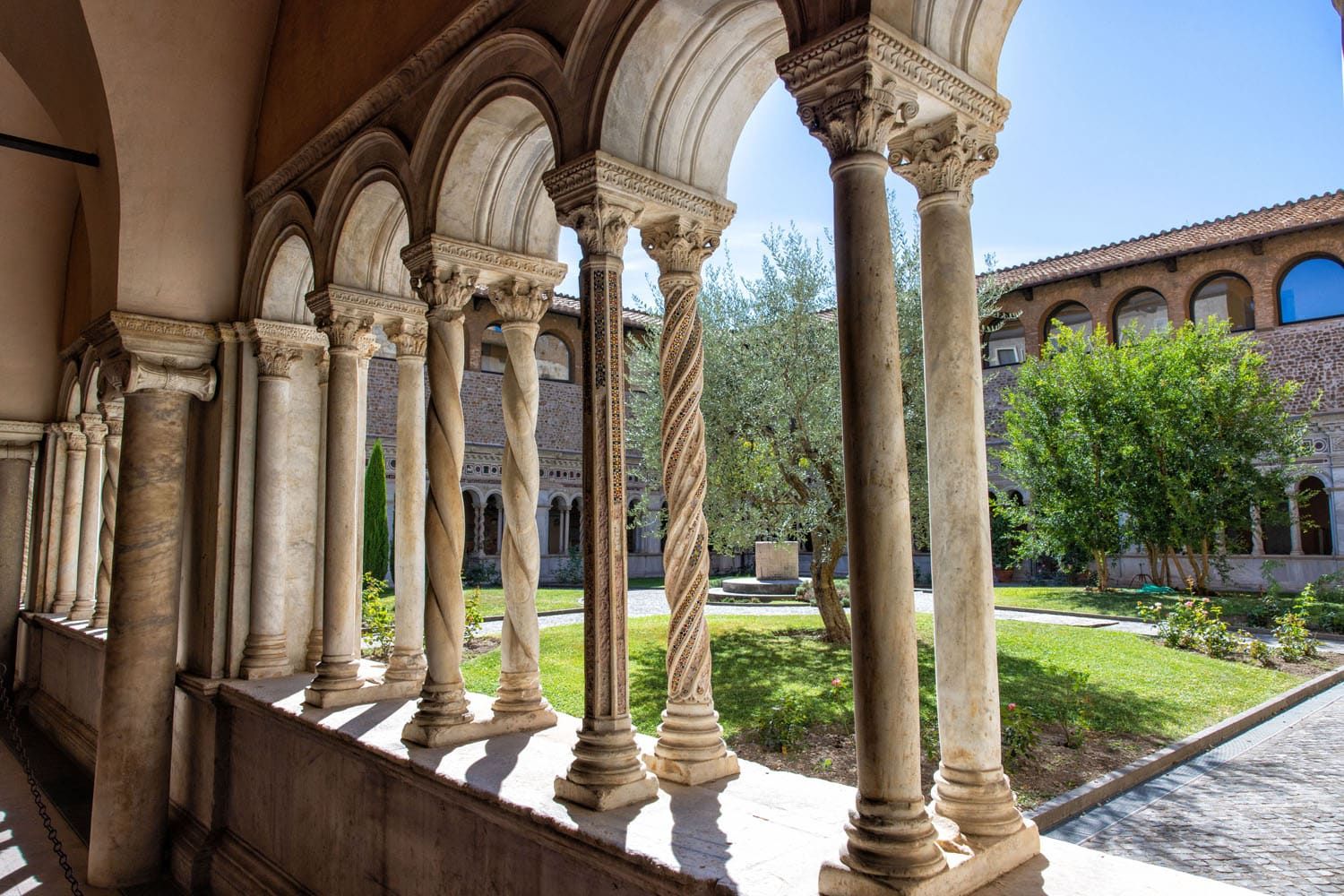
The cloister at the Basilica of Saint John Lateran
19. Scala Sancta & the Holy of Holies
Located across the street from Basilica of Saint John Lateran is a staircase that is an important pilgrimage site in Rome.
The Scala Sancta, or Holy Stairs, is a staircase of 28 marble steps that lead to the Sancta Sanctorum (Holy of Holies). The Sancta Sanctorum is the first private Papal chapel.
It is believed that Jesus Christ climbed these same stairs several times a day while imprisoned in Pontius Pilate’s palace in Jerusalem. The stairs were later relocated to this site in Rome.
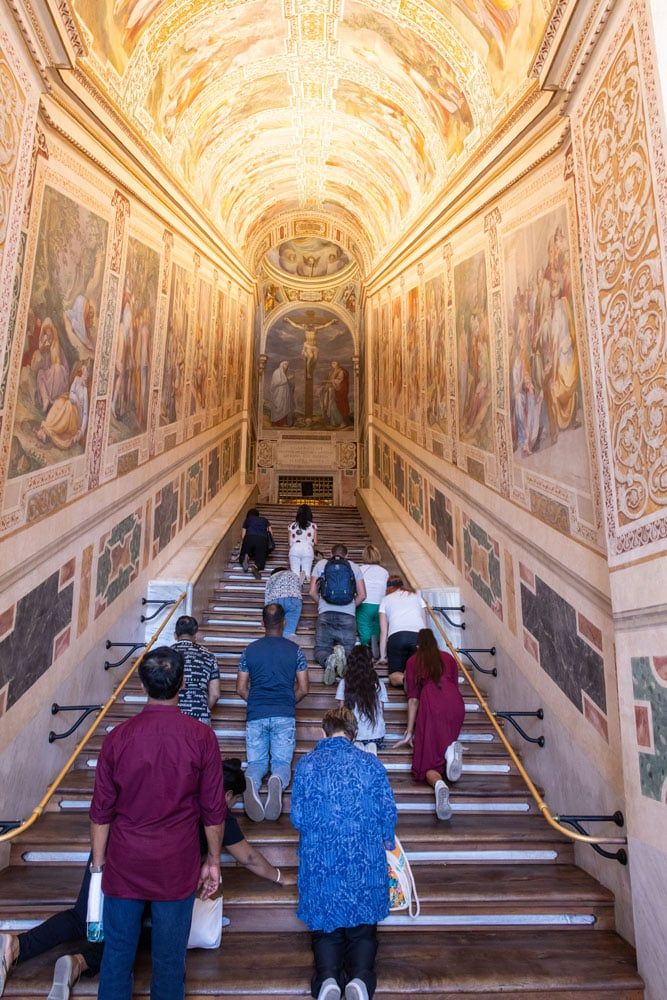
Scala Sancta
A visit to Scala Sancta is free. The only way to climb the Holy Stairs is by staying on your knees. On a visit here, you can climb these stairs, or, if you want to stay on your feet, there is a second staircase you can climb on foot.
At the top of the Holy Stairs is the Sancta Sanctorum. You can get a peek of it through the window or spend a few euros for a ticket to enter the chapel, which is well worth it. This small chapel is covered in colorful mosaics and a beautiful place to visit.
For more information, visit the official website.
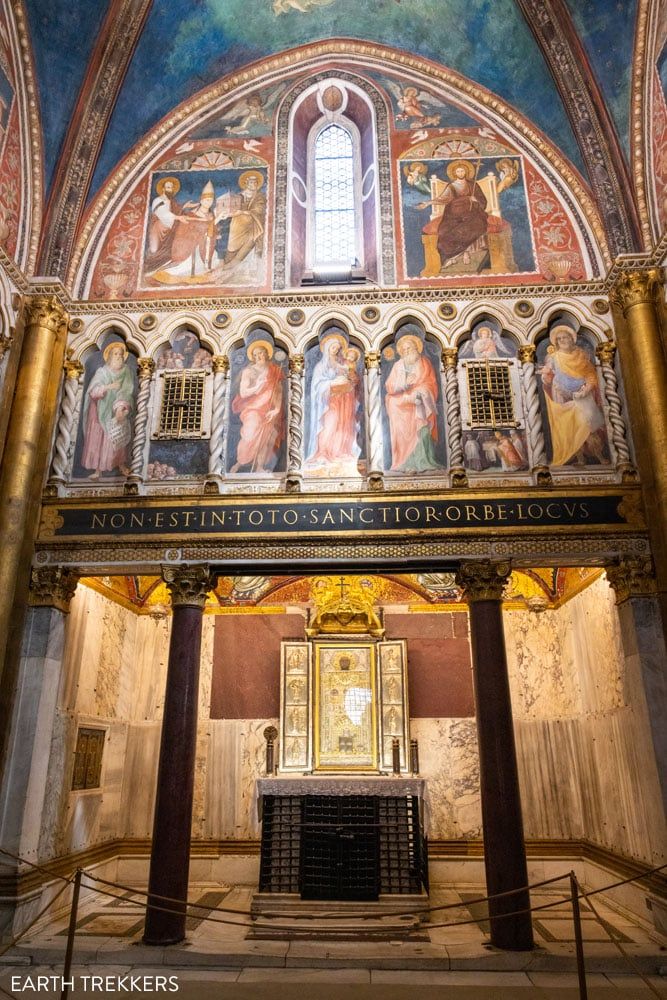
Sancta Sanctorum
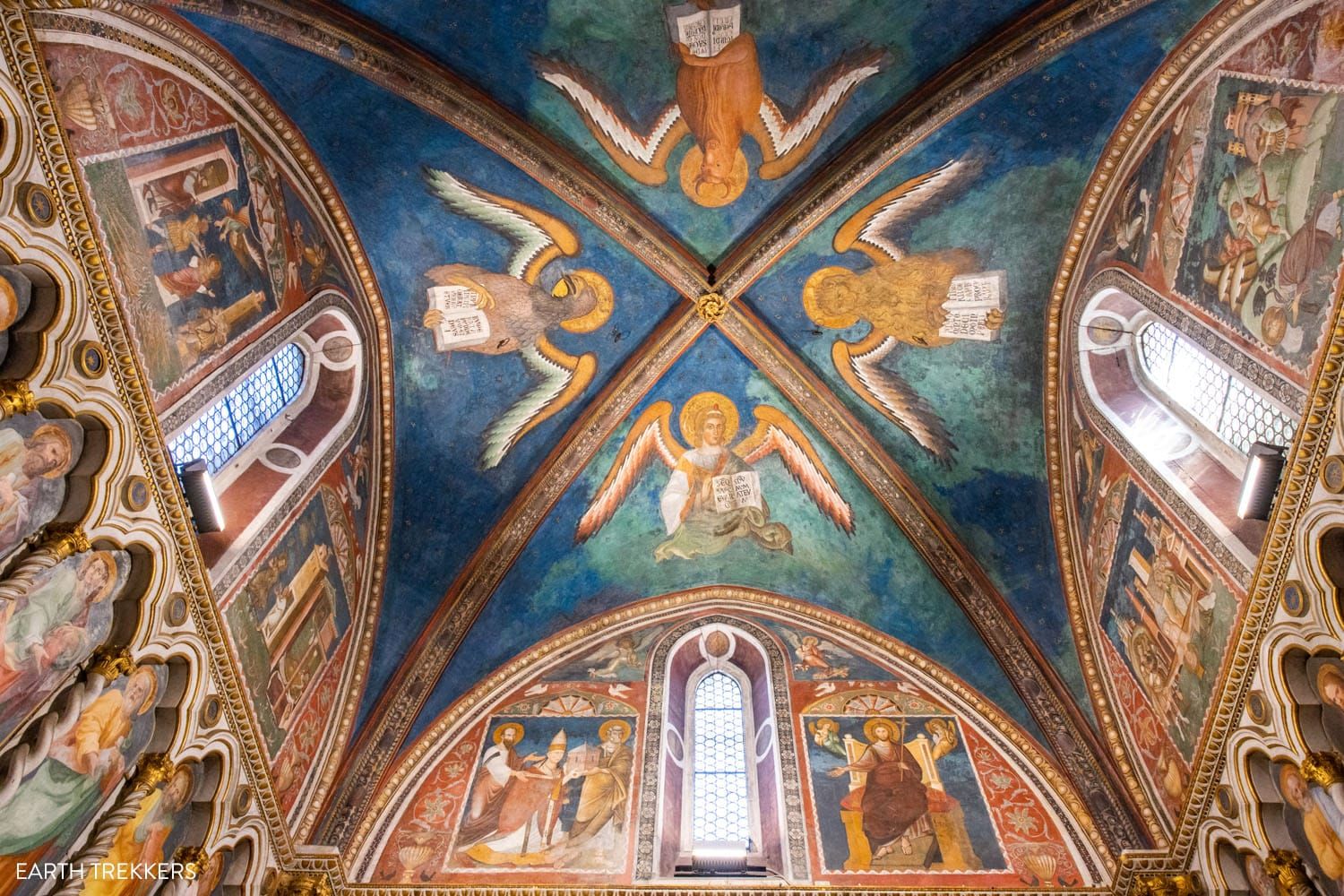
Ceiling of the Sancta Sanctorum
20. Theatre of Marcellus & Porticus Octaviae
If you want to explore more ancient ruins without big crowds of people, put this small area of Rome on your list.
The Theatre of Marcellus (Teatro di Marcello in Italian) looks like a much smaller version of the Colosseum. It was built in 13 BC as an open-air theater that could hold between 11,000 and 20,000 spectators. Now, several tiers of the arches still remain, but the original structure was incorporated into a palace (Palazzo Orsini) in the 16th century.
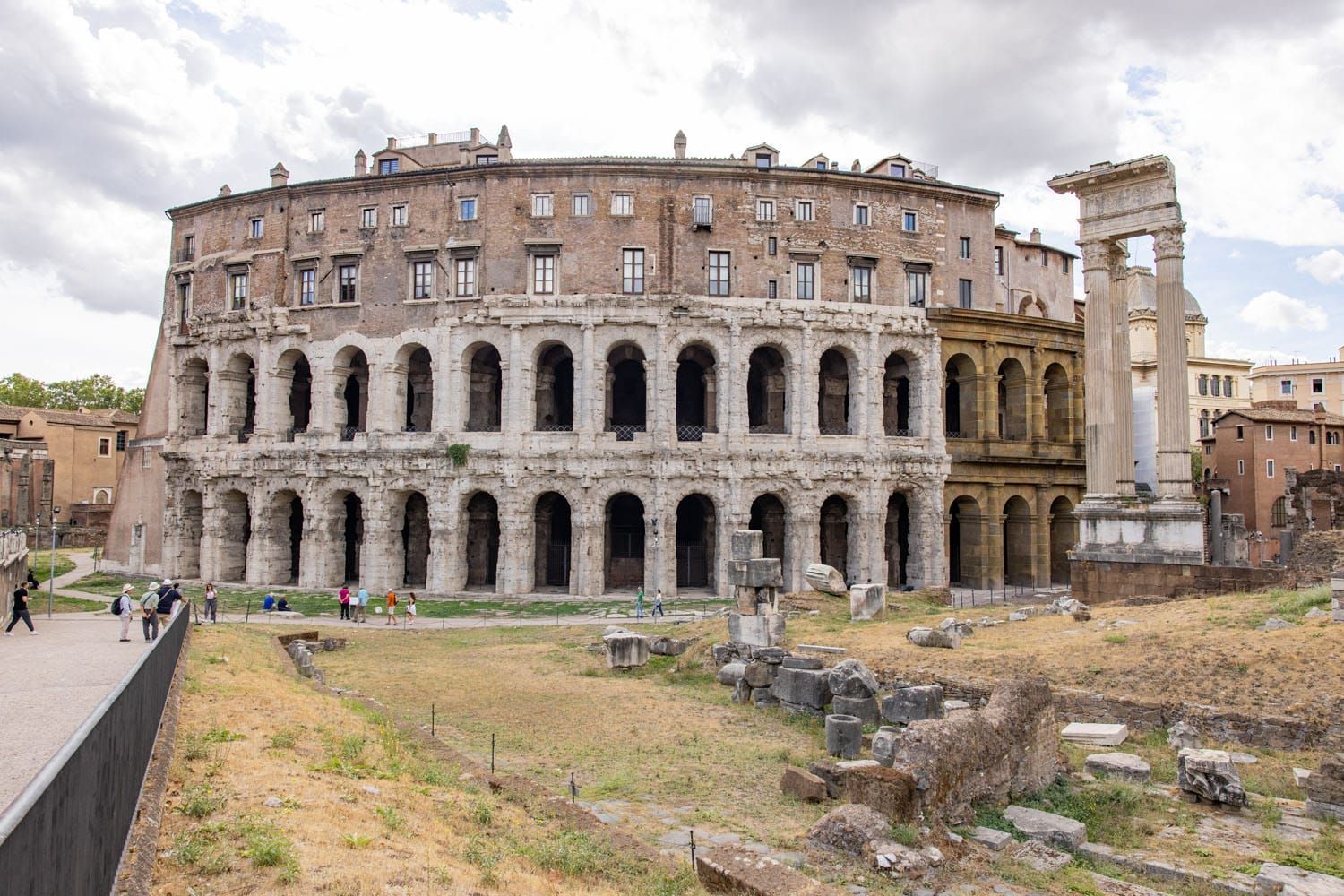
Theatre of Marcellus
If you walk along the Theatre of Marcellus for 50 meters, you arrive at Porticus Octaviae (Portico d’Ottavia in Italian). This structure was built by Augustus in 27 BC to enclose the temples of Jupiter Stator and Juno Regina. It was damaged several times, by fire and by an earthquake. In 770 AD, a church as built over the ruins.
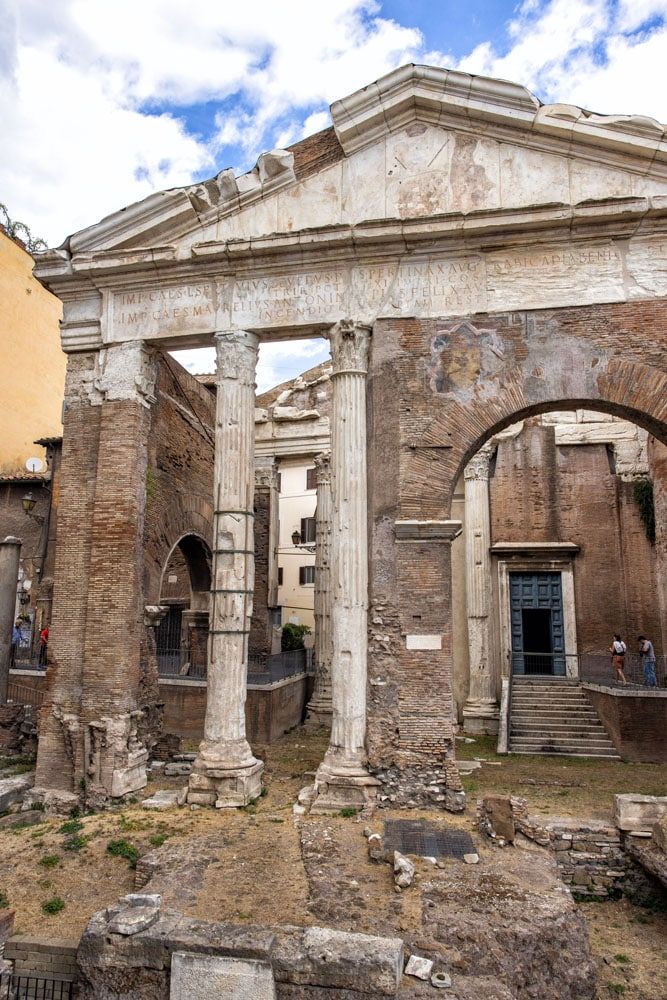
Porticus Octaviae
The Theatre of Marcellus and Porticus Octaviae are located in the Jewish Quarter.
21. The Jewish Ghetto
In 1555, Pope Paul IV established the Jewish Ghetto in Rome, requiring all Jews to live in one designated, walled area of the city. This area sits to the east of the Tiber River and includes the Theatre of Marcellus (just mentioned). With overcrowding and its location next to the river, malaria and cholera were endemic. The people lived in poverty under terrible conditions until 1870, when the Papal State ceased to exist.
While here, have lunch or dinner in an outdoor café, see the Turtle Fountain, stroll along Via Del Portico d’Ottavia, and visit the Great Synagogue (Tempio Maggiore di Roma).
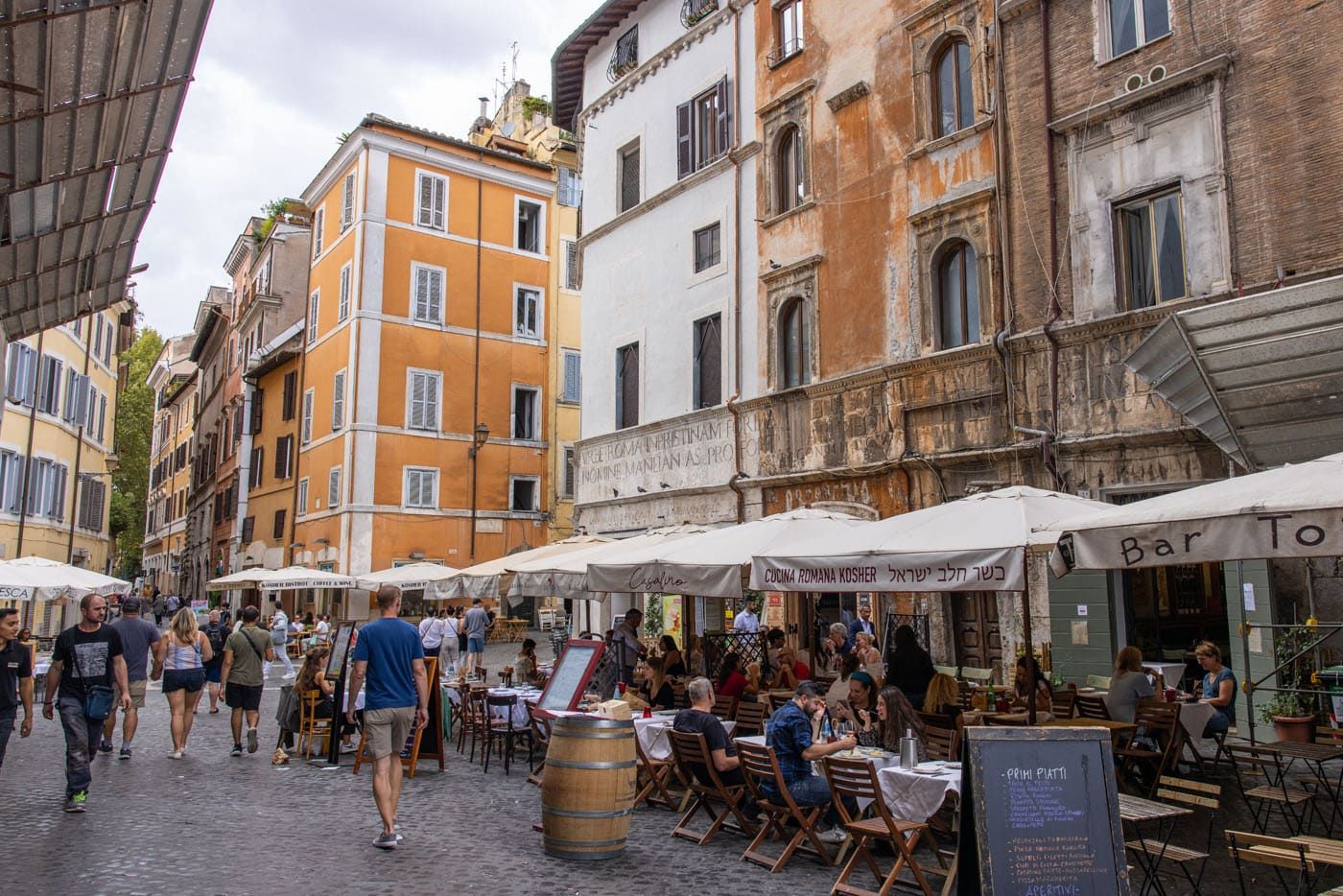
Jewish Ghetto
22. The Church of Santo Stefano al Monte Celio
This very old church has a circular shape and is covered with some of the most interesting, yet morbid, frescoes that we saw in Italy. The frescoes portray various scenes of martyrdom, displaying executions of men and women.
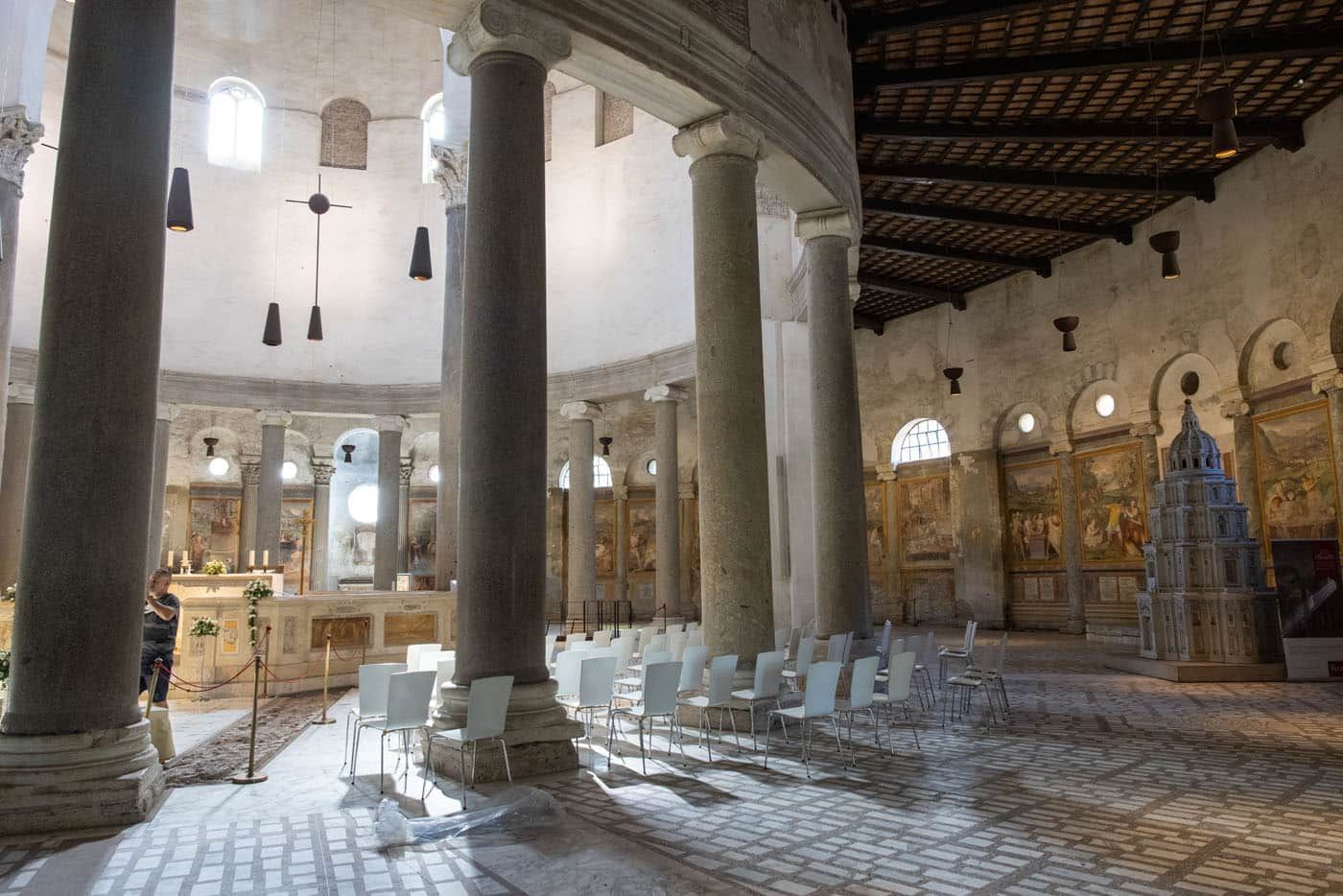
Church of Santo Stefano al Monte Celio
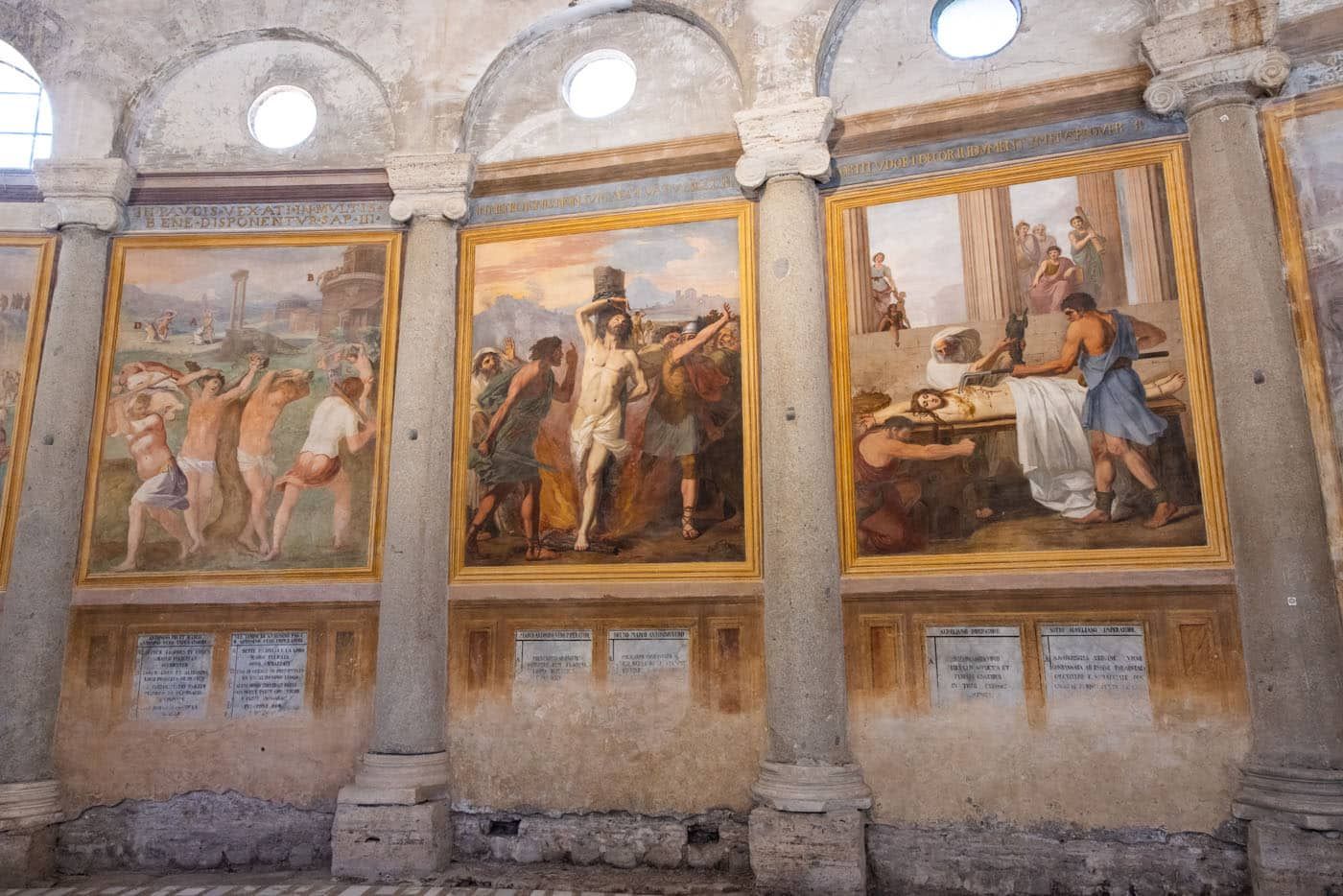
For hours of operation, visit the official website.
23. Baths of Caracalla
The Baths of Caracalla (Terme di Caracalla in Italian), were the second largest public baths in Rome. They were built between 212 and 217 AD and were used until the 530s.
These baths span a huge area, covering 62 acres (25 hectares). Many of the ancient adornments, such as frescoes and statues, have been removed, and what remains are the massive walls.
A visit here is relatively quick and it is a bit out of the way from other sites in Rome, so this is only worth the visit if you have an interest in Roman history and have a lot of time in the city.
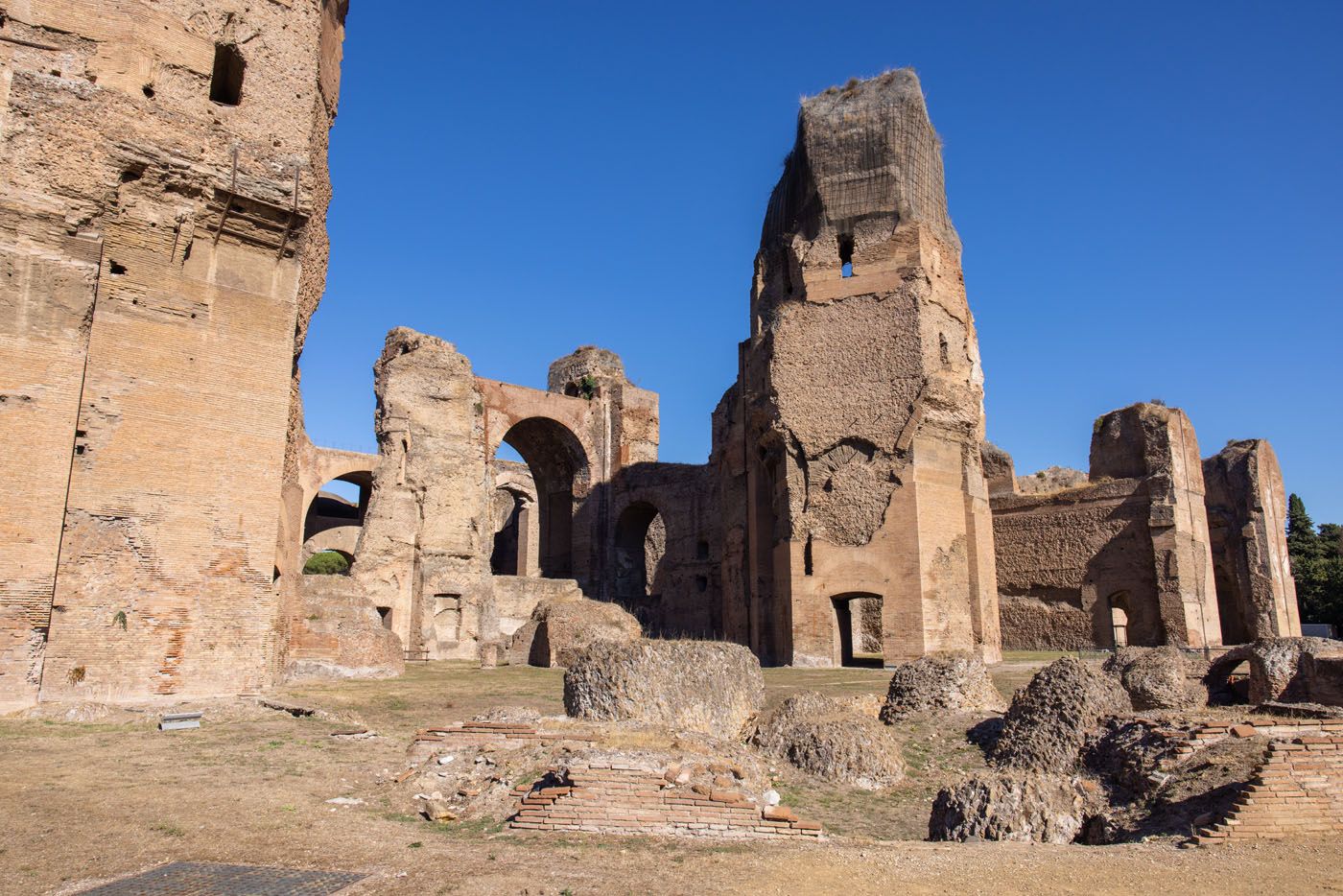
Baths of Caracalla
24. Santa Maria Maggiore
Santa Maria Maggiore (also called the Basilica of Saint Mary Major and Basilica di Santa Maria Maggiore), is the largest Catholic Marian church in Rome and a Major papal basilica.
This is one of the most important churches in Rome and inside there are a few notable things to see:
- The Crypt of Nativity: Located under the high altar, this crypt is said to contain wood from the crib of the nativity of Jesus Christ.
- Salus Populi Romani: An image of the Blessed Virgin Mary, which is kept in the Borghese Chapel of the basilica.
- Coffered Ceiling: The coffered ceiling is said to be gilded with gold brought by Christopher Columbus to Ferdinand and Isabella.
- Mosaics from the 5th century with images of the Virgin Mary
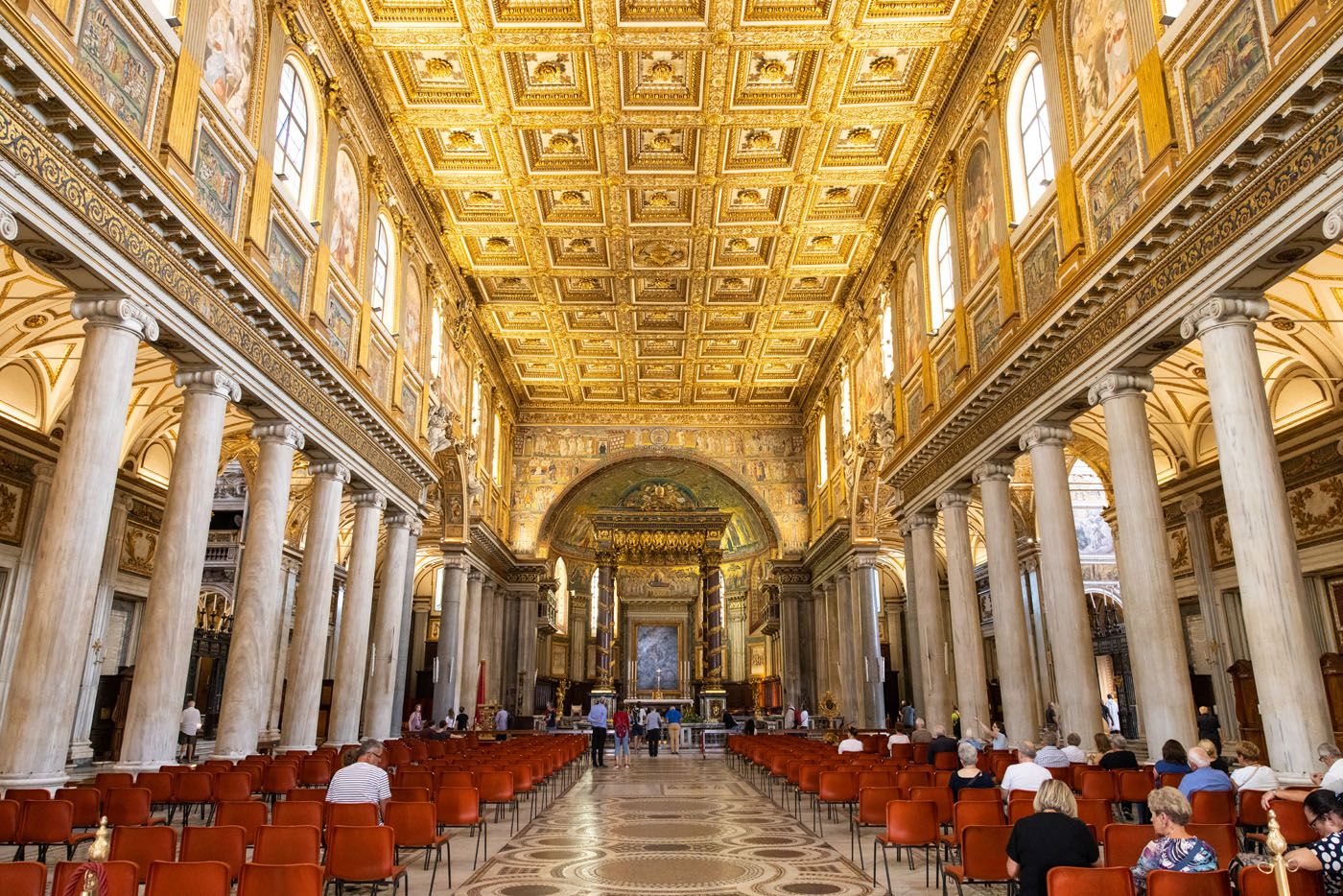
Santa Maria Maggiore
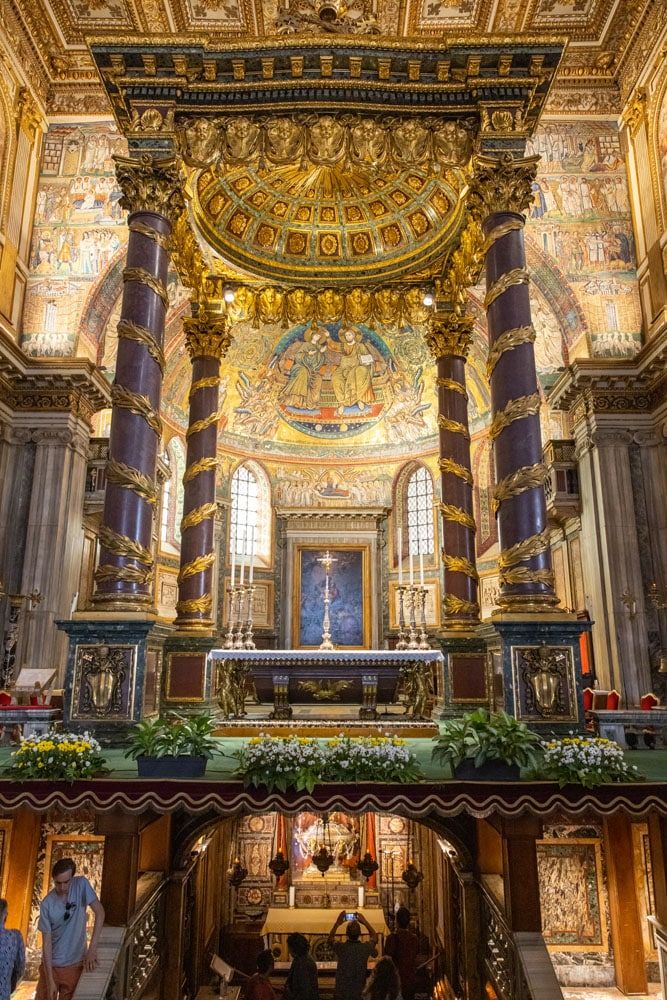
High Altar and below is the Crypt of the Nativity
25. San Pietro in Vincoli
It may not look like much on the outside, but San Pietro in Vincoli (Saint Peter in Chains) is another important church in Rome.
This church is famous for Michelangelo’s statue of Moses, which is a funeral monument for Pope Julius II. There is also a reliquary containing the chains of St. Peter.
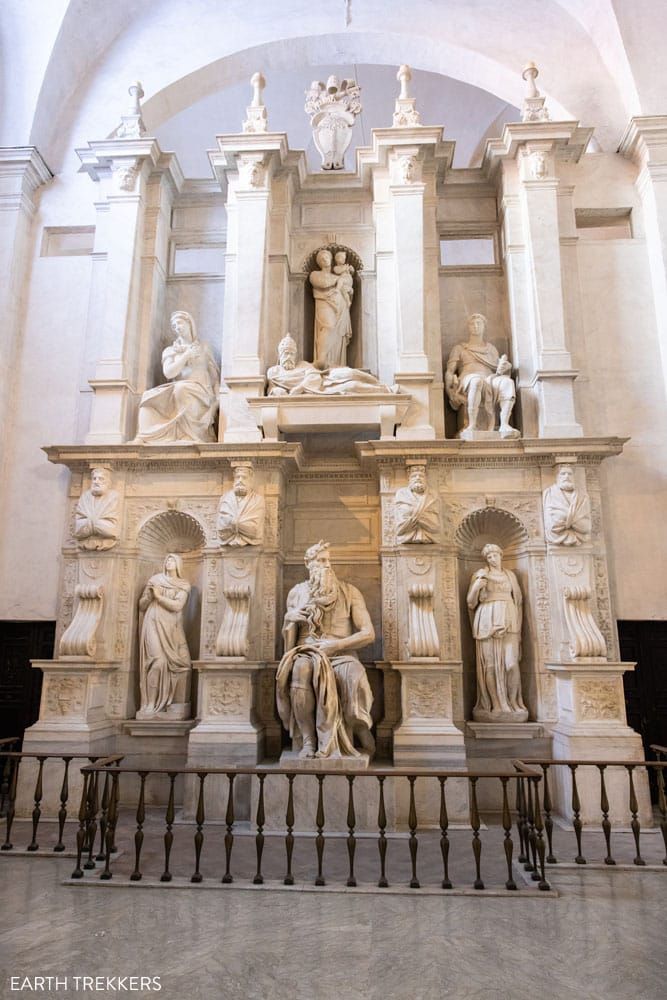
Michelangelo’s Moses is the bottom middle statue
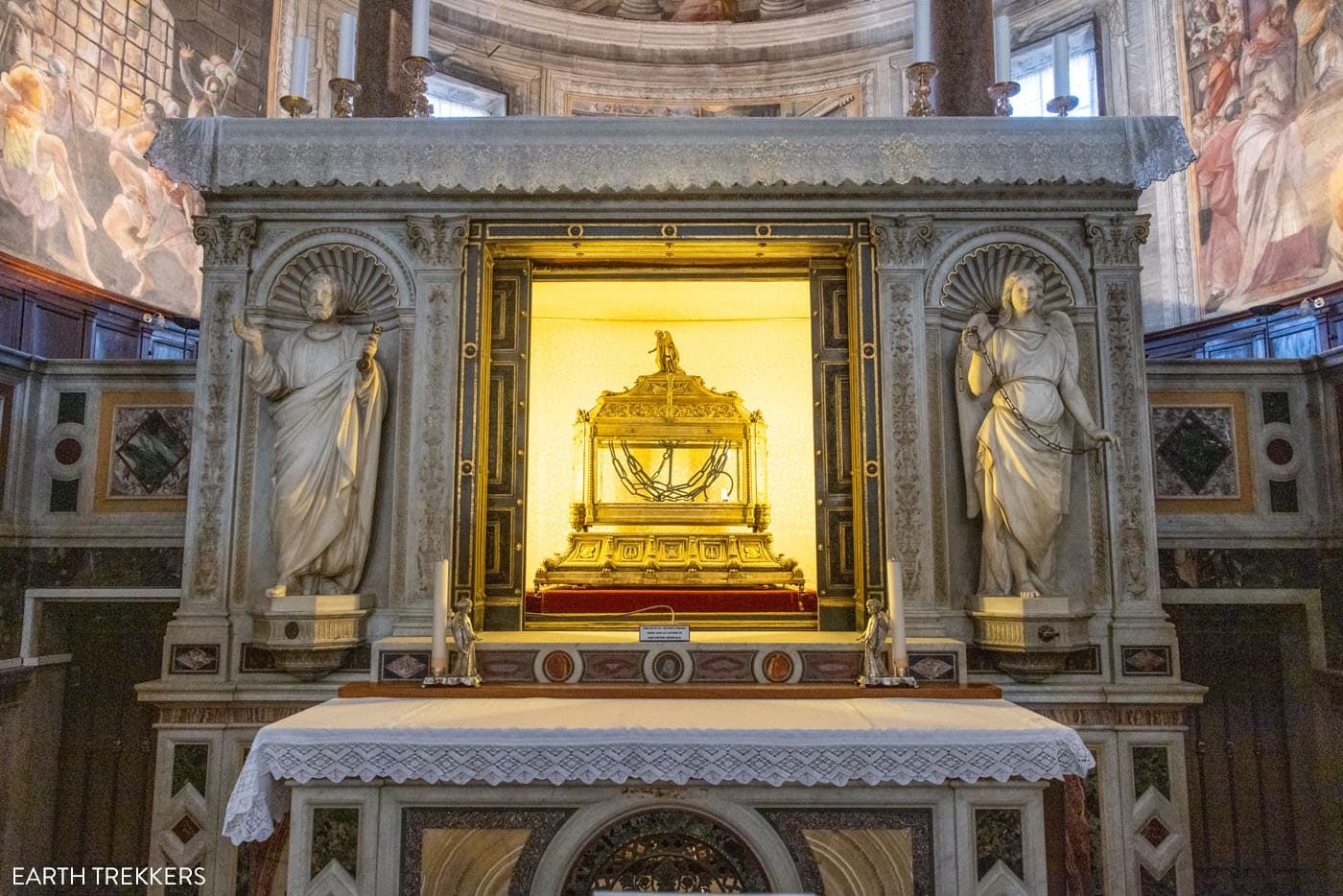
The chains of St. Peter
Santa Maria Maggiore and San Pietro in Vincoli are located near each other and both can be visited in about one hour. They are located between the Colosseum and Roma Termini.
26. Basilica of San Clemente
The Basilica of San Clemente is famous for its three-tiered design: a present-day church that sits atop two much older churches. The “modern” Basilica was constructed in the 12th century and contains colorful mosaics and frescoes. Descend down to the much older, 4th century church, which contains a collection of some of the finest medieval frescoes in the world.
Finally, as you head deeper underground, you enter the 1st century church. The spring that you see on this level runs to the Colosseum.
For hours of operation and pricing, visit the official website.
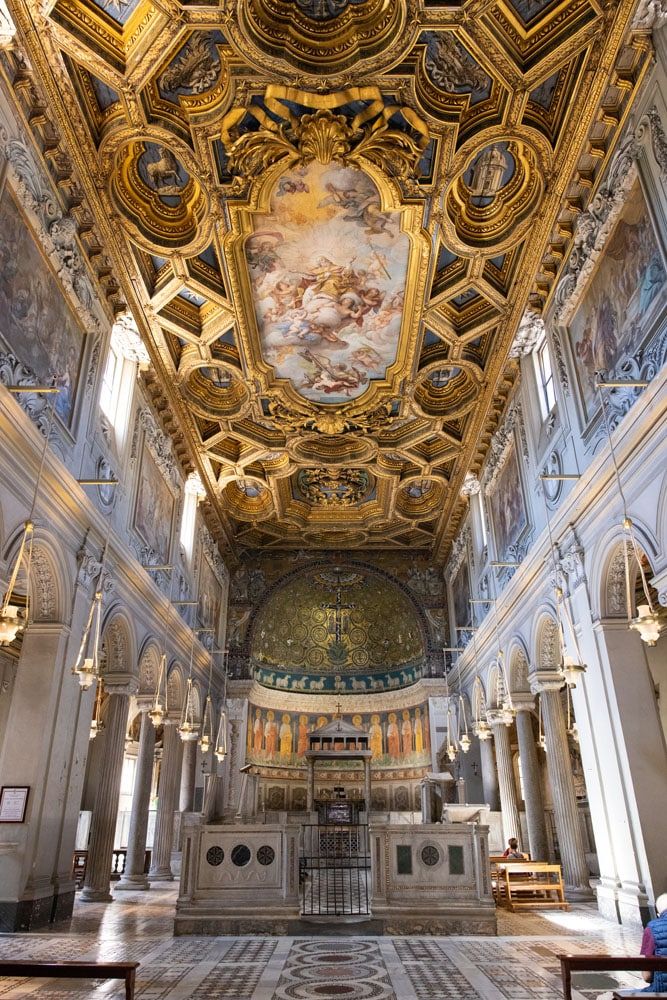
Basilica of San Clemente
27. Galleria Spada
Galleria Spada is an art museum that is located inside of Palazzo Spada. This gallery contains four rooms filled with Baroque paintings that were collected by Cardinals Bernardino and Fabrizio Spada. In these rooms, you will see works of art by Titian, Caravaggio, Rubens, and Guido Reni.
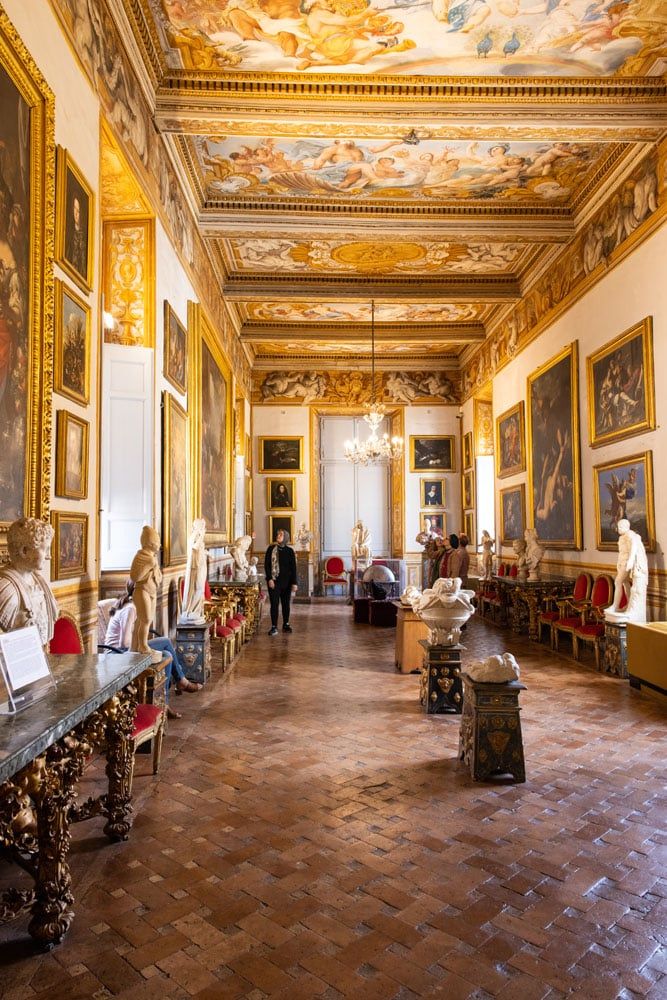
Spada Gallery
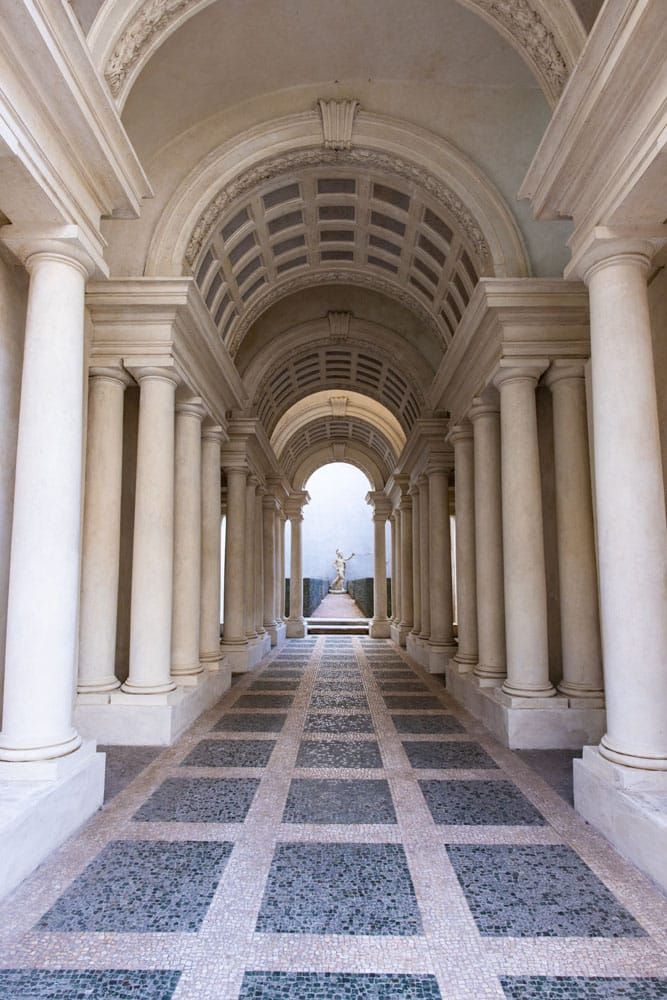
Borromini’s Perspective Gallery
The main attraction here is the perspective gallery that was created by Borromini. This is the best place to see an optical illusion in Rome. The colonnaded gallery is only 8 meters (26 feet) long and the statue of Mars is only 60 centimeters (24 inches) high, but they look much larger than this.
Galleria Spada is just a 3-minute walk from Campo de’ Fiori and a 7-minute walk from Piazza Navona, so if this is something you have interest in, it’s easy to add on to a stroll through Rome’s historic center.
Tickets can be bought online or at the palazzo. We purchased our tickets onsite and there were just a few other people here during our visit. Visit the official website for pricing and hours.
28. Knights of Malta Keyhole
This was one of the most overrated things we did in Rome. Sure, it sounds cool, to see the dome of St. Peter’s Basilica through a keyhole. But getting here can be challenging, you need to be prepared to wait in line, and you may not get the view you were hoping for.
This famous keyhole is located on a wooden door in the complex of Sant’Anselmo, on top of Aventine hill. If you put your eye up to this keyhole, you can see St. Peter’s Basilica.
To do this, we took a taxi to this spot and then waited in line for about 10 minutes, which isn’t too bad. However, a black bar sat across the keyhole, obstructing the view.
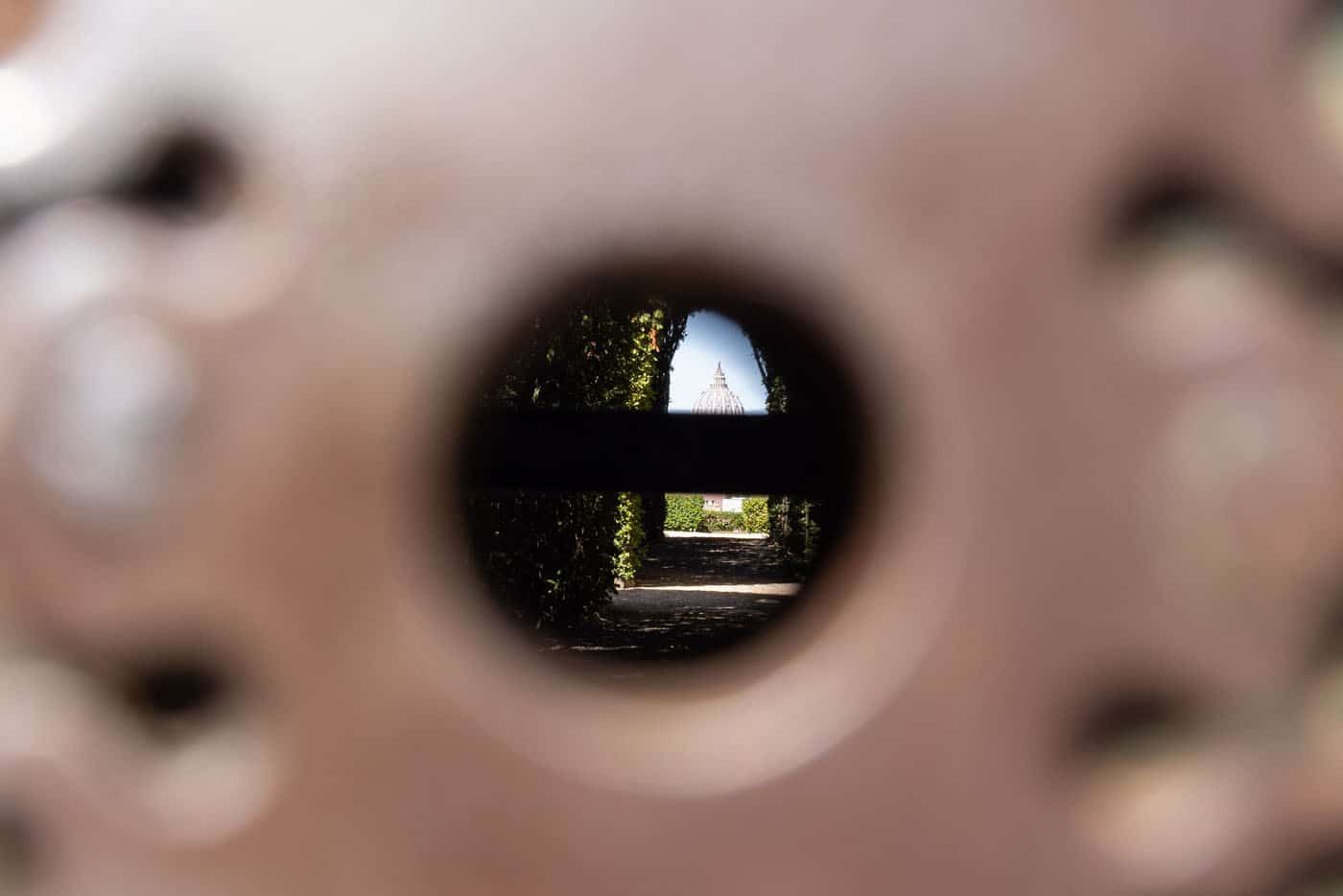
With so much to do in Rome, this felt like a waste of time. And you may get the same view we did, seeing more of that black bar than the dome of St. Peter’s Basilica. But while you are here, it is a short walk to Terrazza Belvedere Aventino in the Orange Garden for a beautiful view of Rome.
This is what the view is supposed to look like:
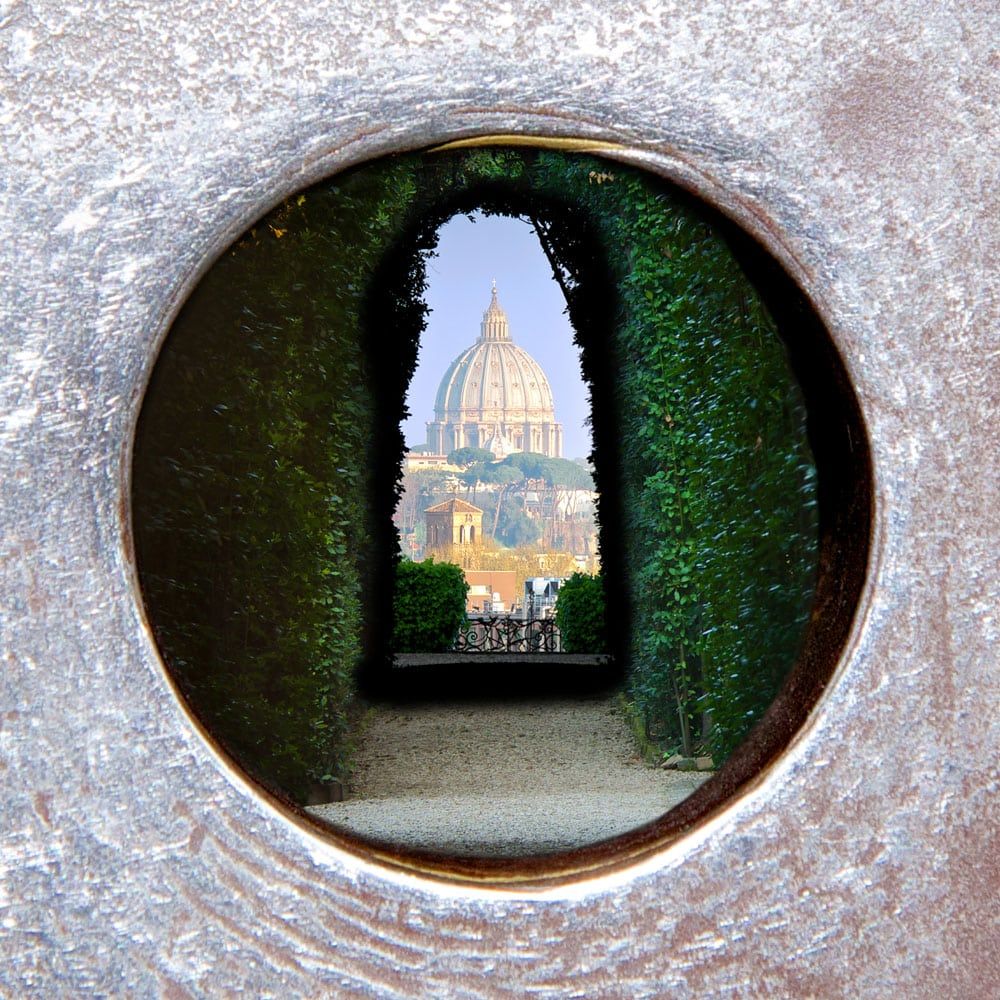
photo credit: Matteo Gabrieli/shutterstock.com
29. Largo di Torre Argentina
This archaeological site contains four Roman Republican temples and the remains of Pompey’s Theatre. It is believed that Julius Caesar was assassinated at this spot.
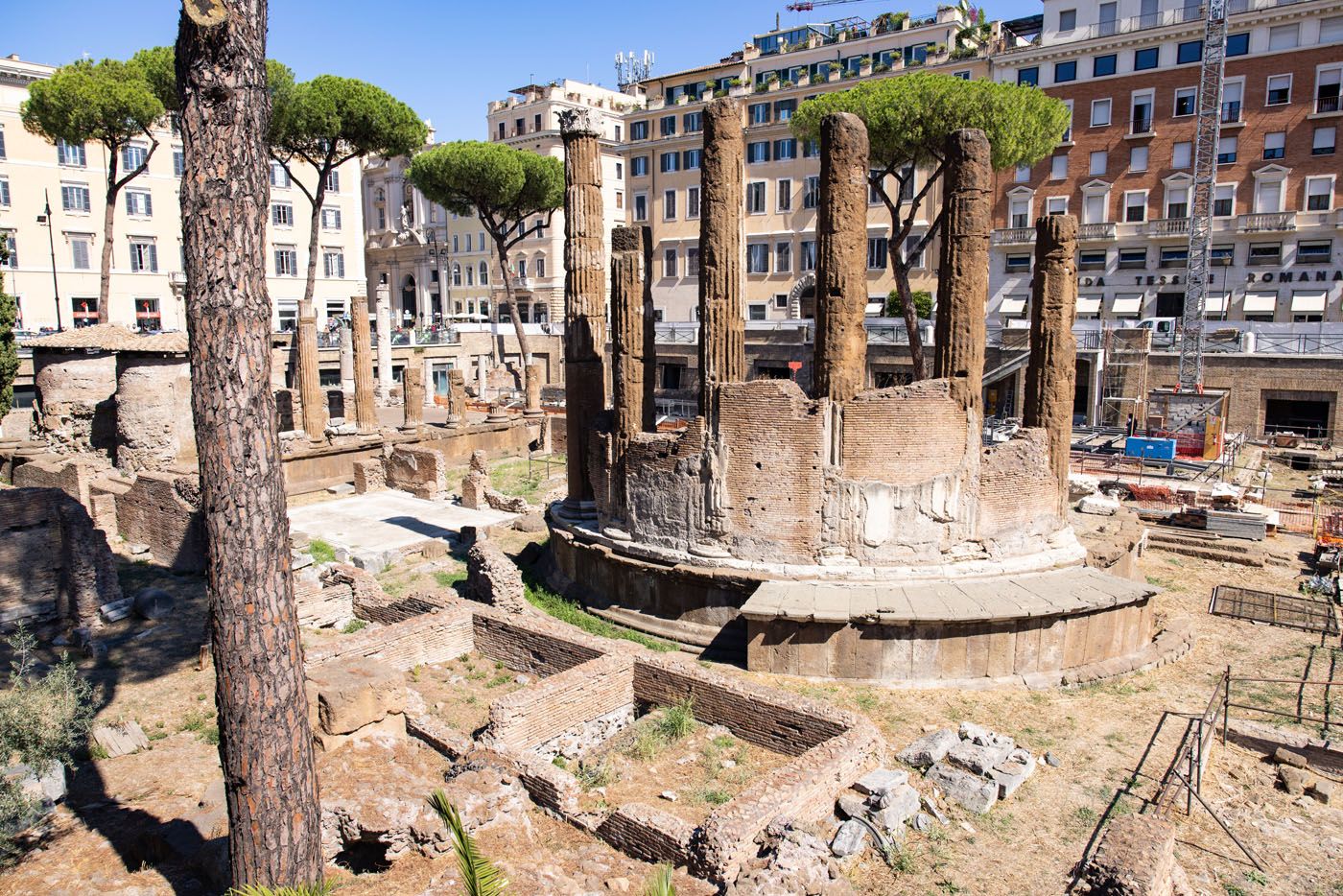
Largo di Torre Argentina
One of the four temples is now being used as a cat sanctuary. It’s estimated that anywhere between 250 and 350 cats call this area home.
You can see Largo di Torre Argentina, and its cats, as you stroll the sidewalks that line the square. You can also pay a small fee to enter the walkway that has a closer look of the cats and the archeological sites.
Largo di Torre Argentina is an interesting spot to see but you’ll have to go a little out of the way to get here. You can see its location on our map.
30. Doria Pamphilj Gallery
Located in Palazzo Doria Pamphilj, which is one of the largest palazzos in Rome still under private ownership, is a large art collection with works of art by Caravaggio, Titian, Raphael, Bernini, and more. The palace is also a work of art, with its lavishly decorated rooms.
This lesser-known art gallery is worth it for art aficionados. Get hours of operation and pricing on the official website.
Best of Rome: On a Map
How to Use This Map: Click the tab in the top left corner of the map to see a list of the points of interest and to turn layers on/off. Click the icons on the map to get more information about each point of interest.
To take this map with you, click the star next to the title of the map which adds it to your Google account. Next, within your Google Maps app, select ‘Saved’ and then select ‘Maps’. This map title will now appear in your list.
How to Plan a Trip to Rome
If you are planning your first trip to Rome, it’s best to spend at least 2 days in Rome. This gives you enough time to visit everything on our top list, if you move quickly. 3 to 4 days in Rome is ideal, as this gives you enough time to visit the must-see sights, plus a few off the beaten path places, without feeling like you are in a race.
To help you plan your visit, here are a few detailed Rome itineraries, plus a few helpful guides.
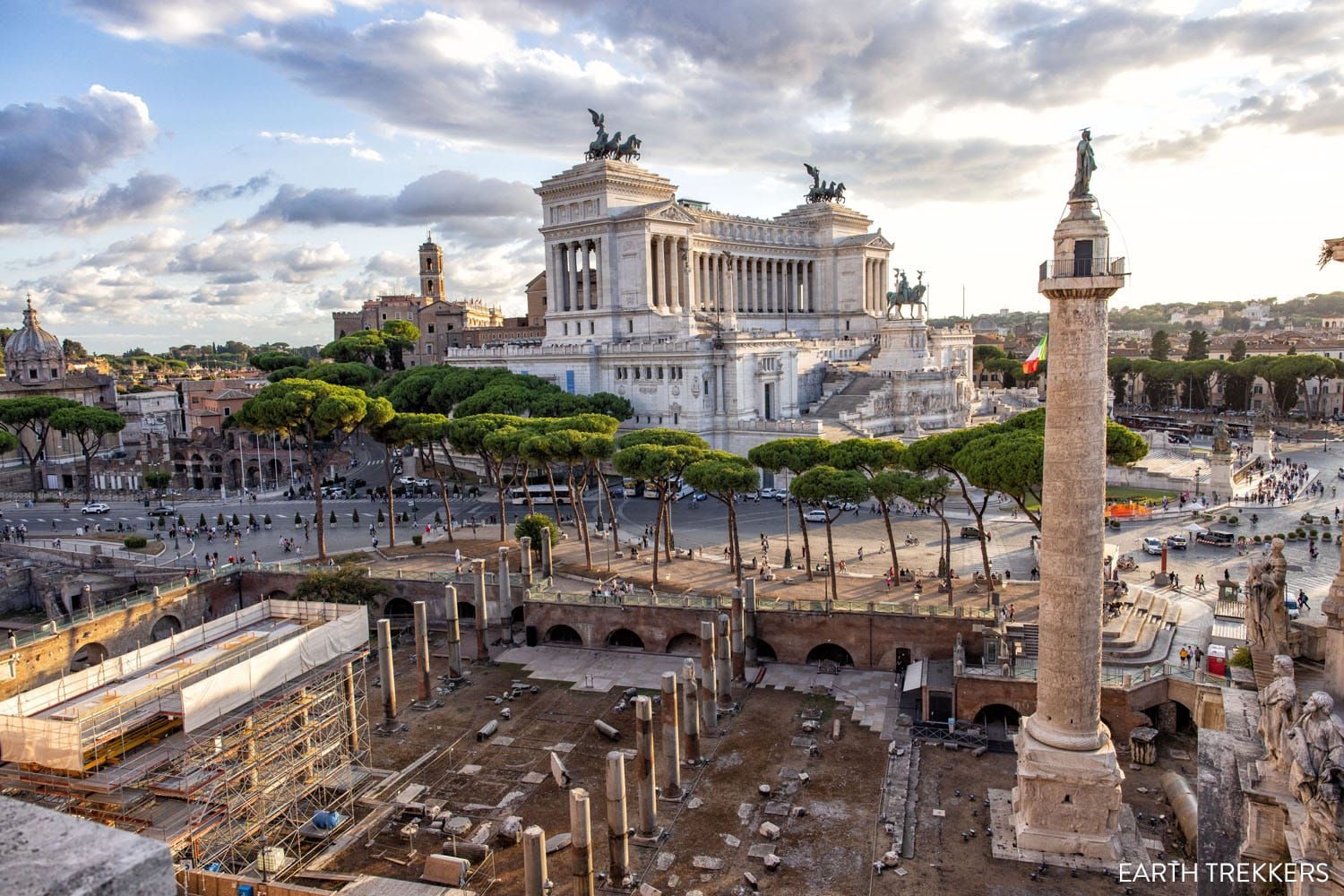
Trajan’s Forum and the Altar of the Fatherhood (from Oro Bistrot)
If you have any questions about the best things to do in Rome, or if you want to share your favorite experiences, let us know in the comment section below.
More Information for Your Trip to Italy
We have TONS more information about Italy in our Italy Travel Guide, including Rome, Florence, Venice, Tuscany, the Dolomites, the Amalfi Coast, the Cinque Terre, Sicily, and Puglia.
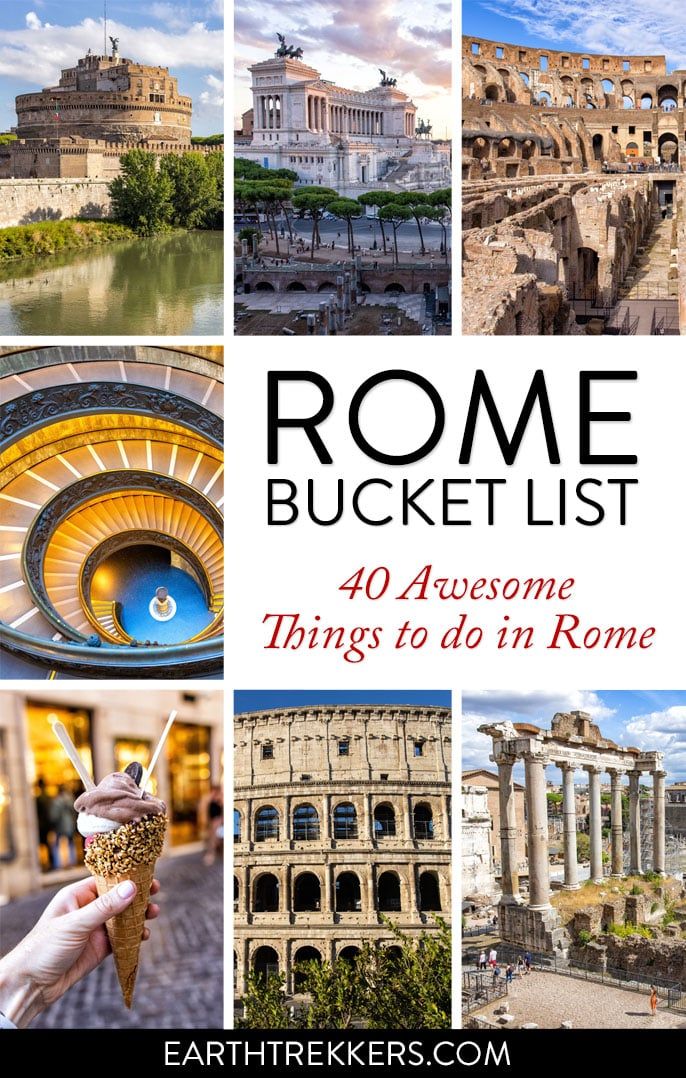
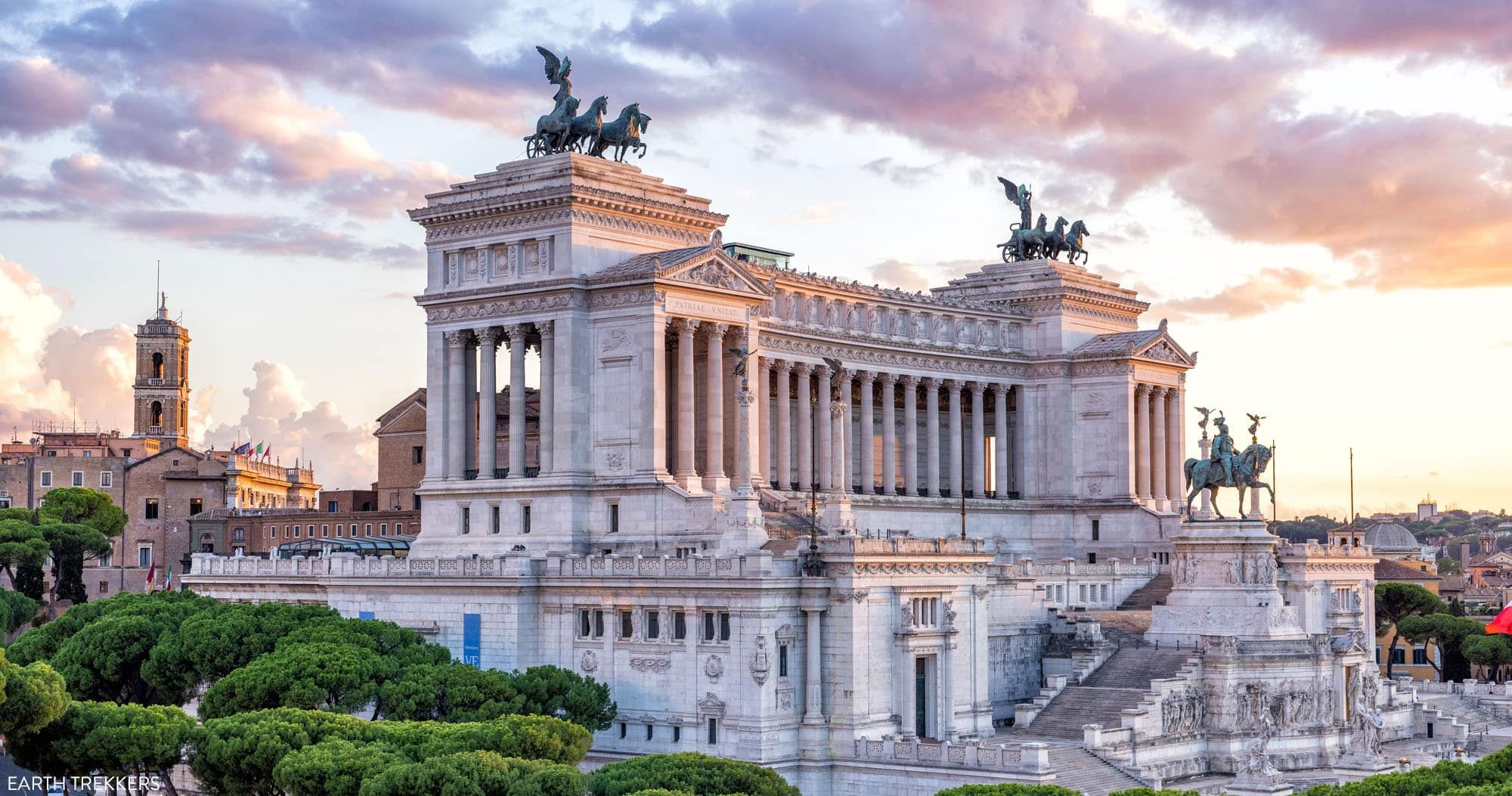
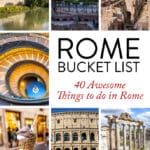
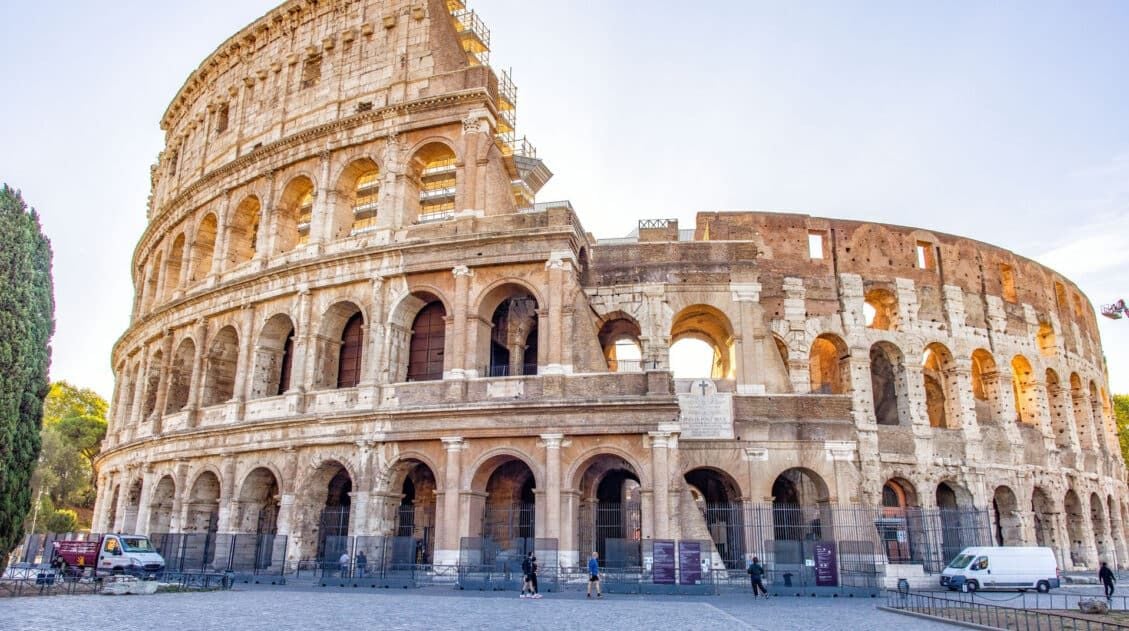
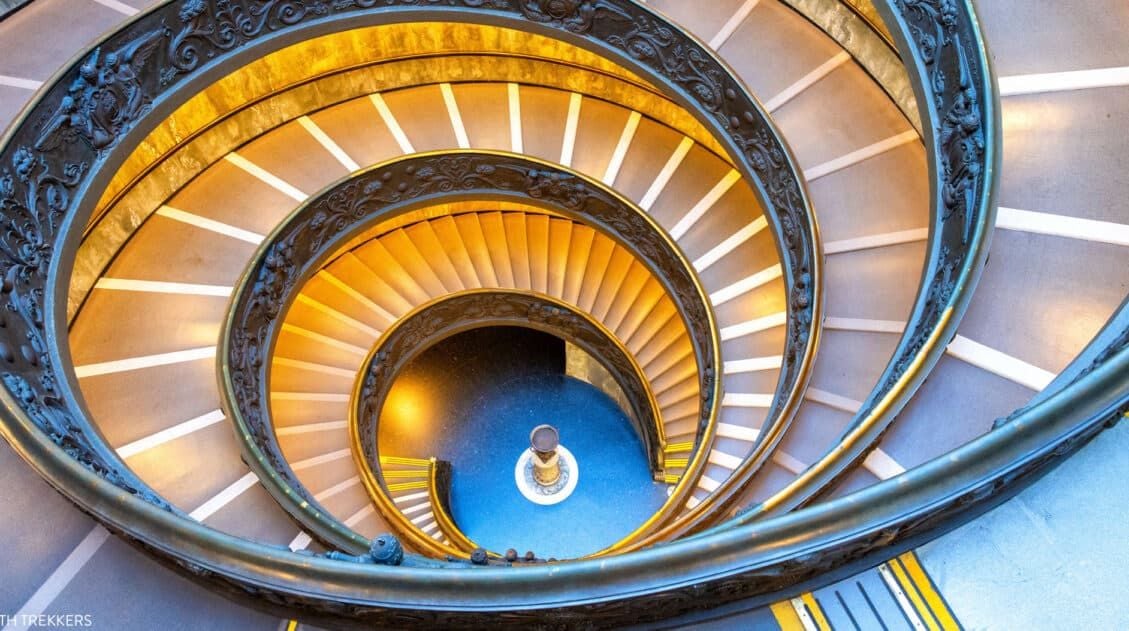
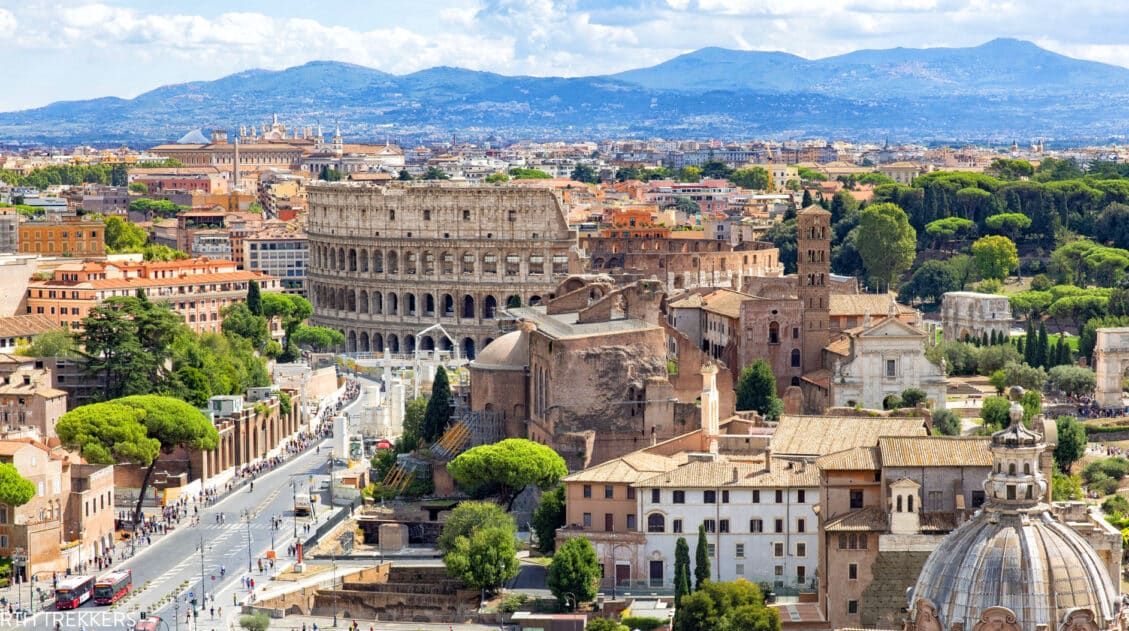
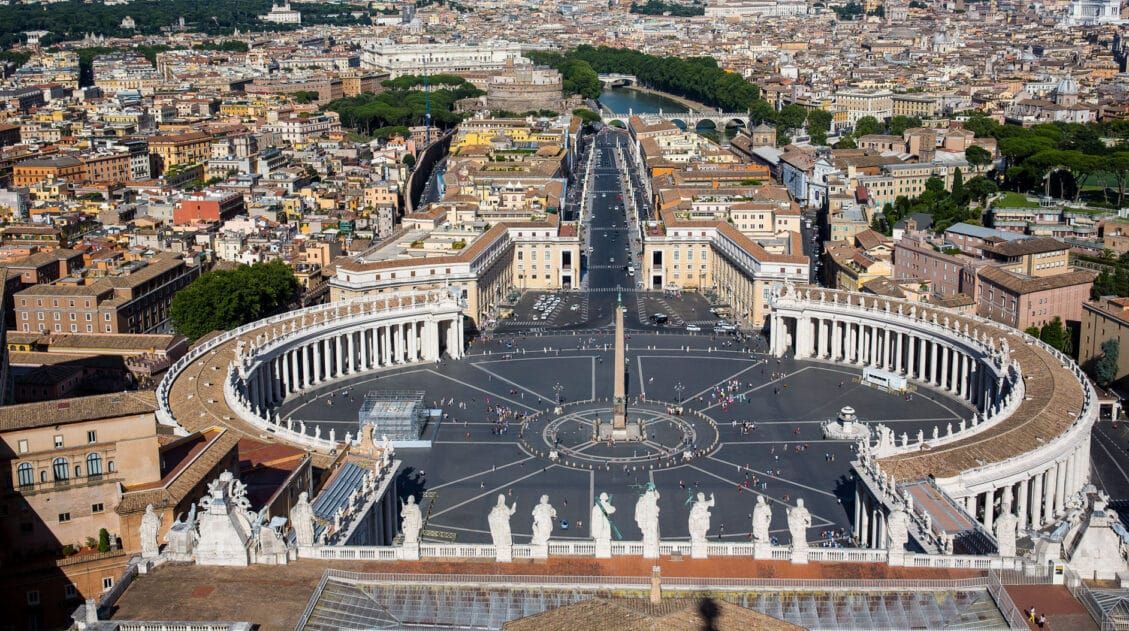
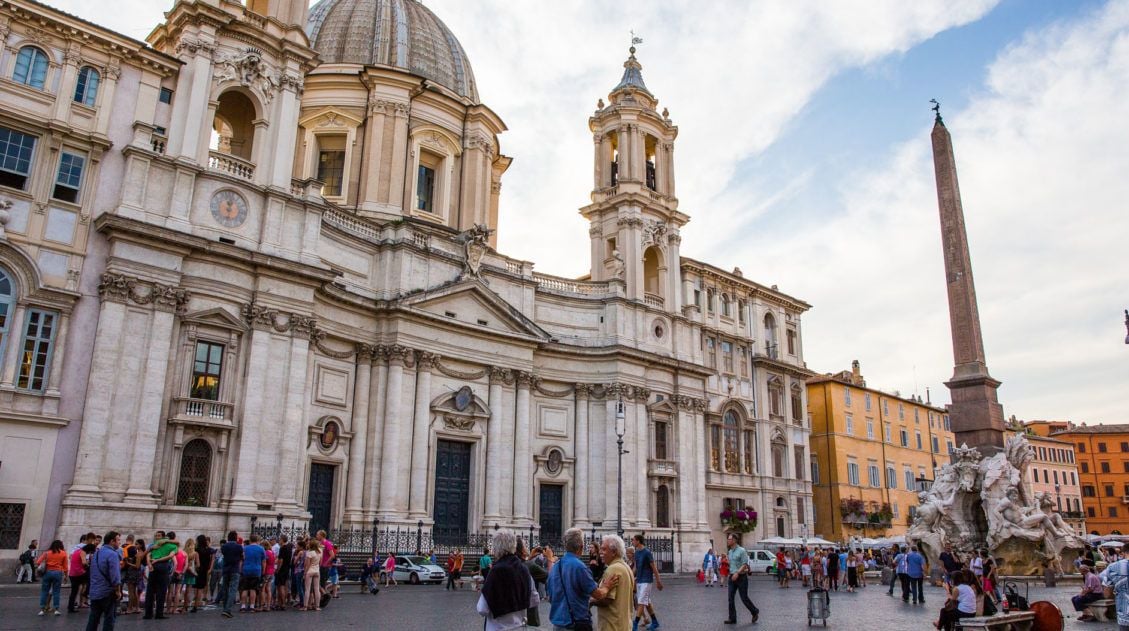
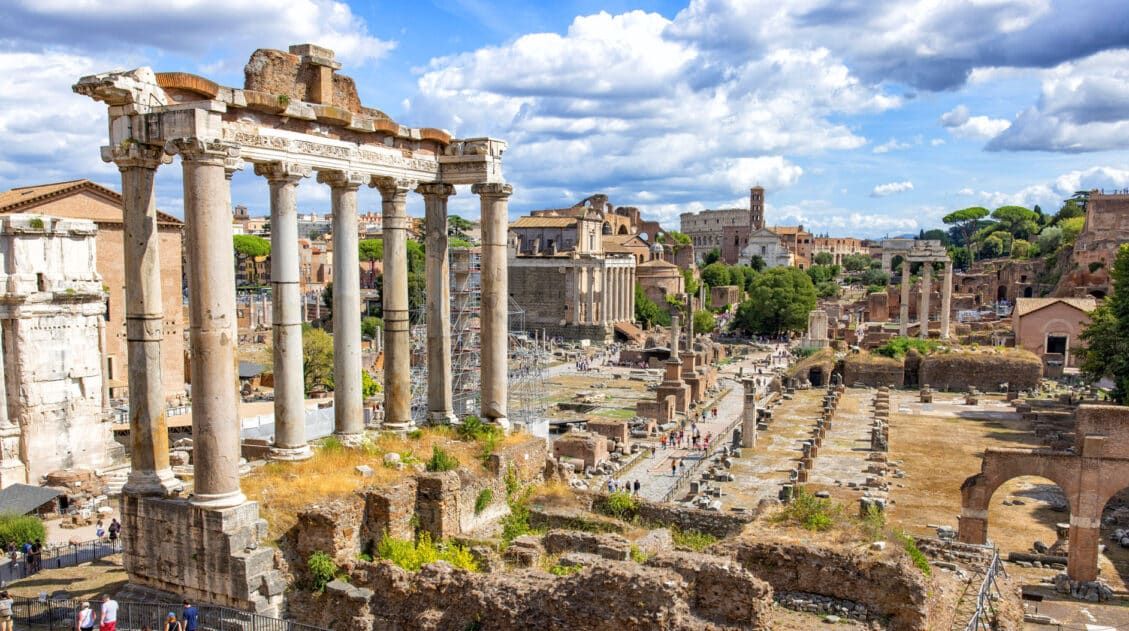
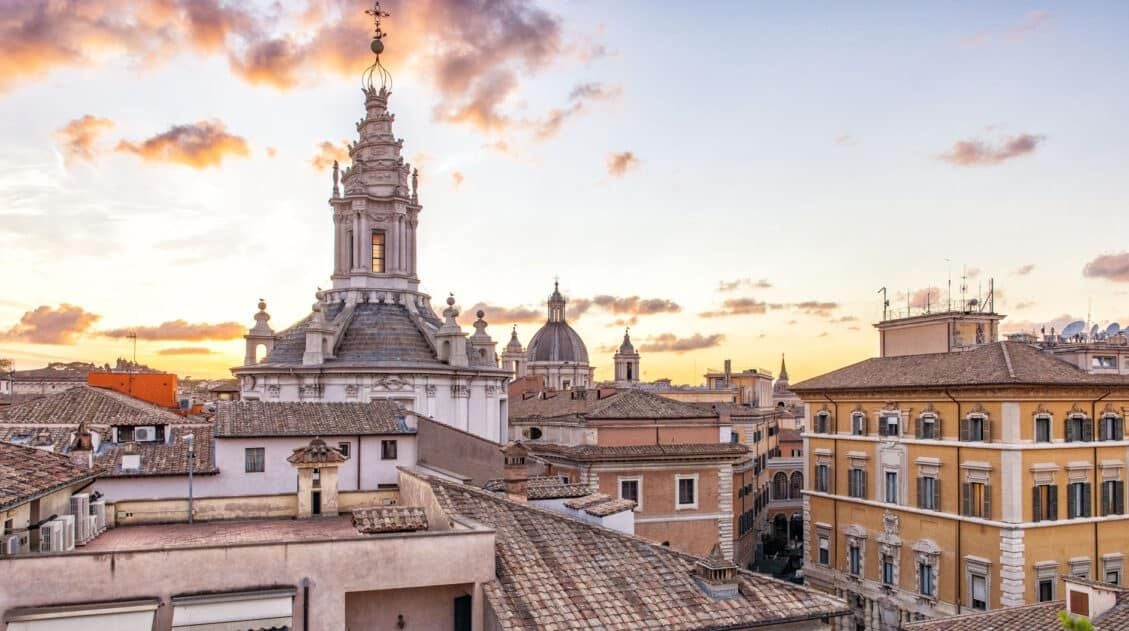
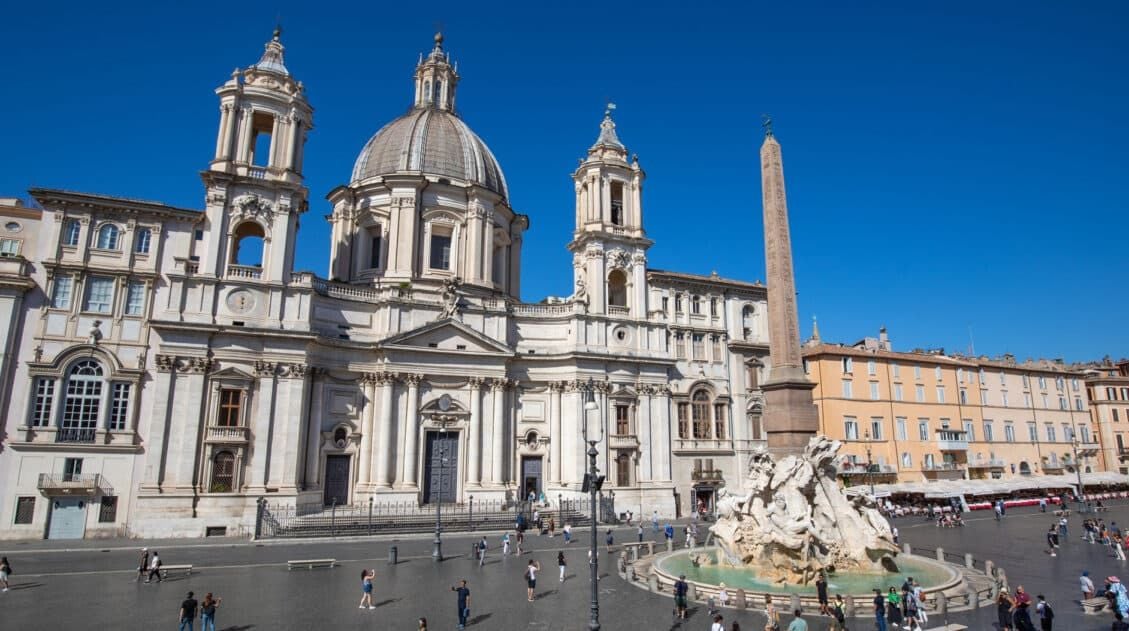

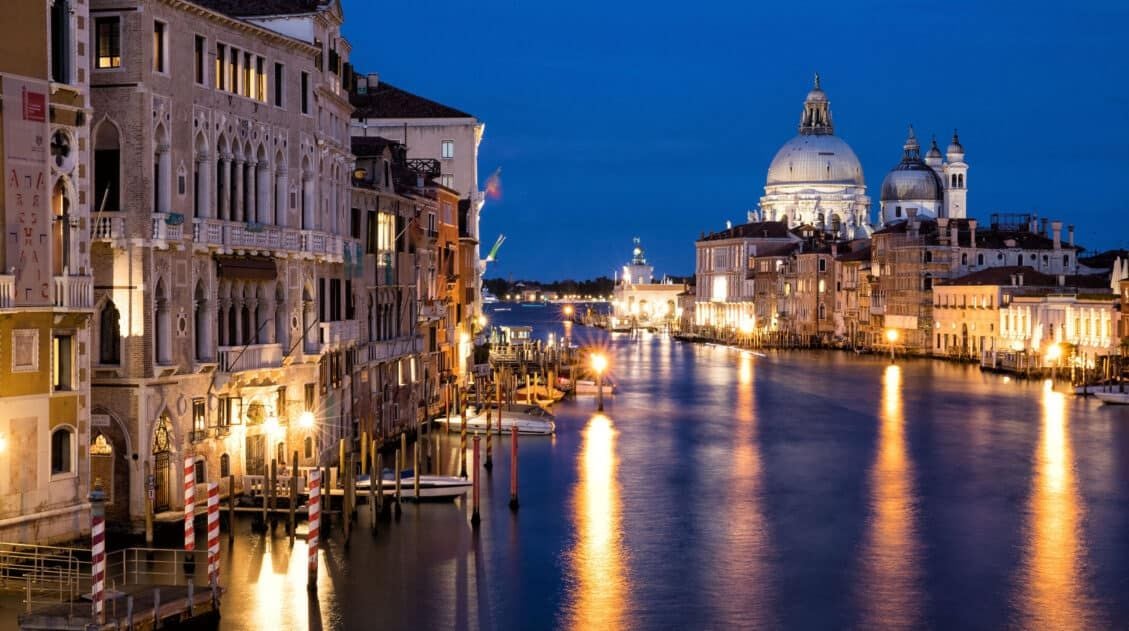
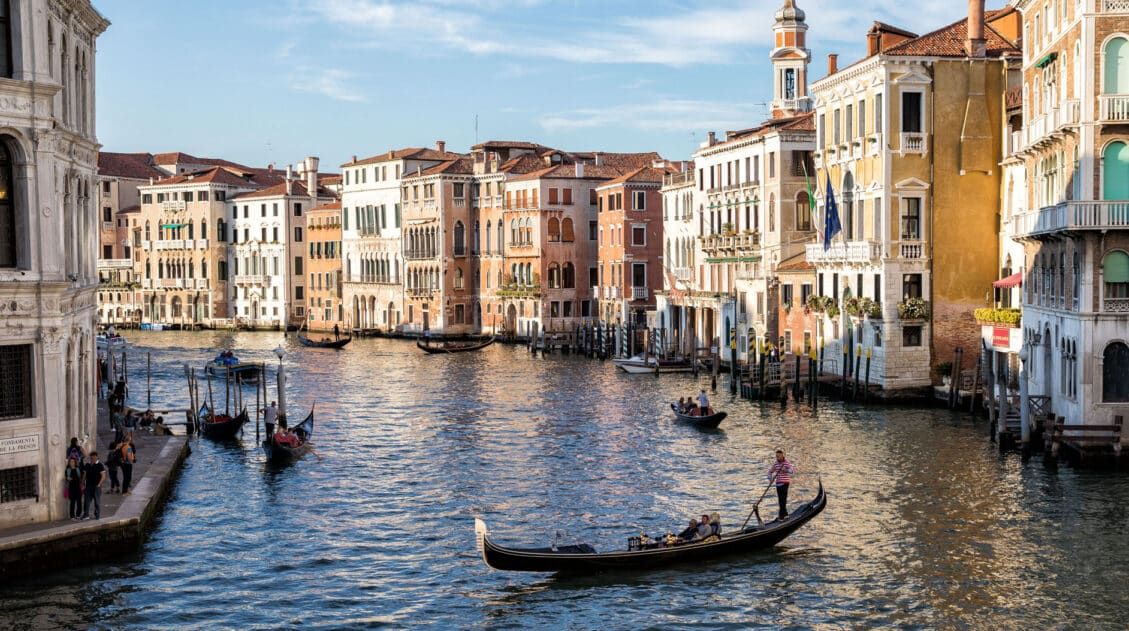
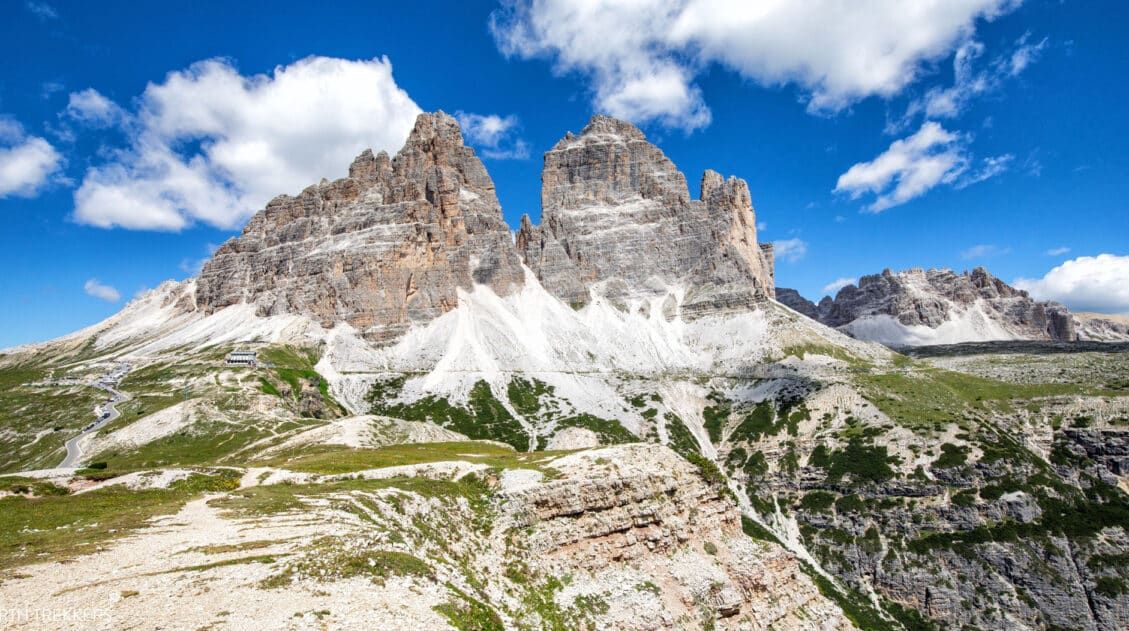
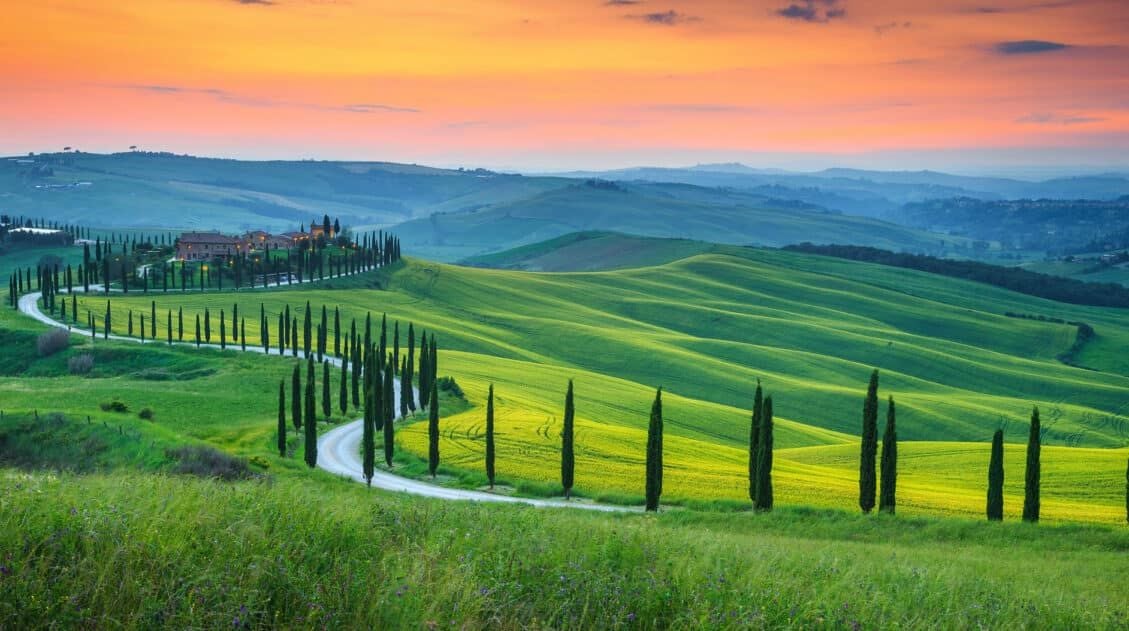
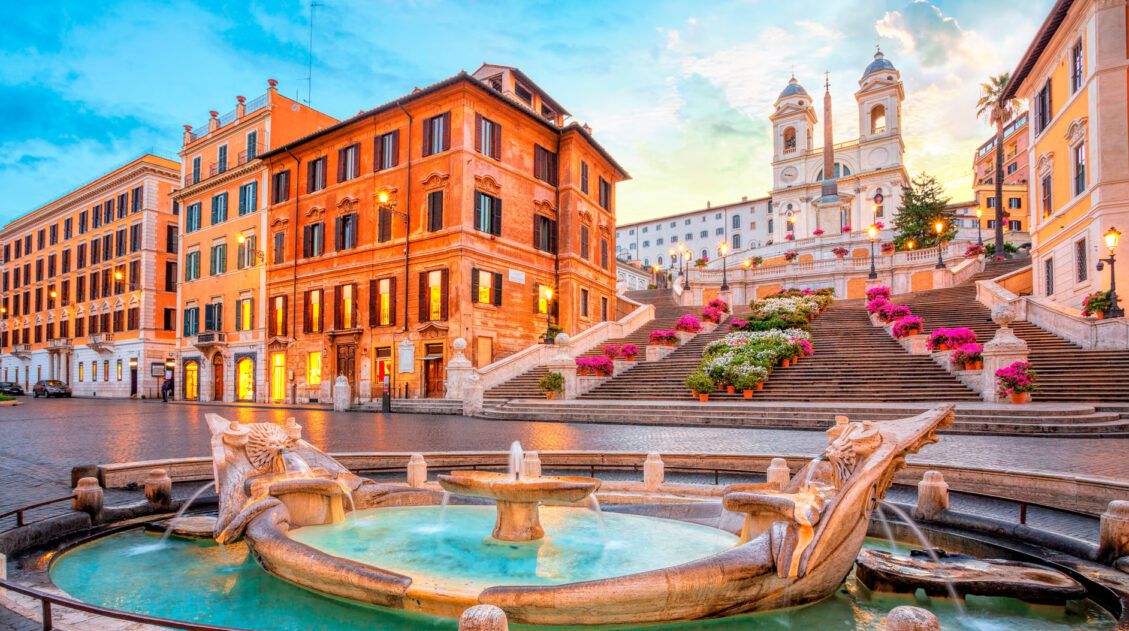
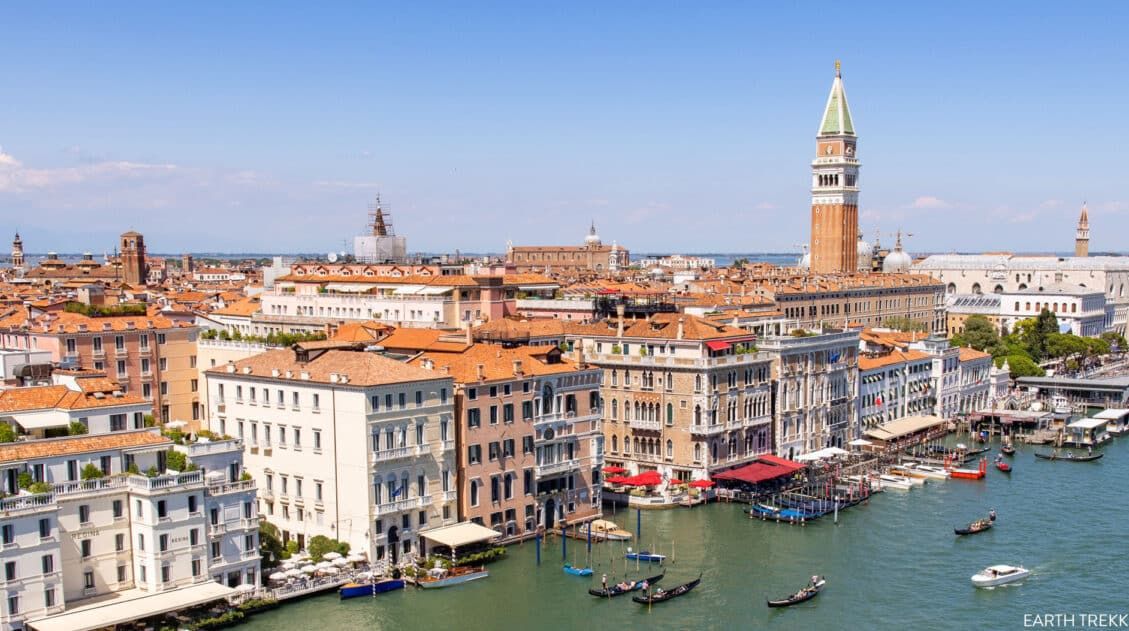
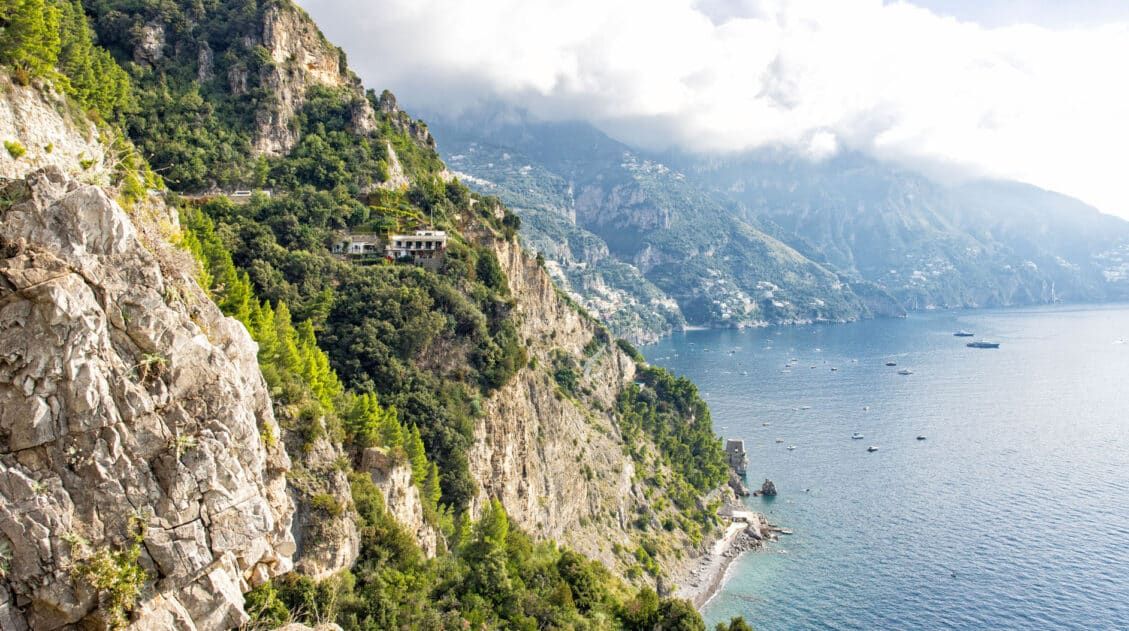
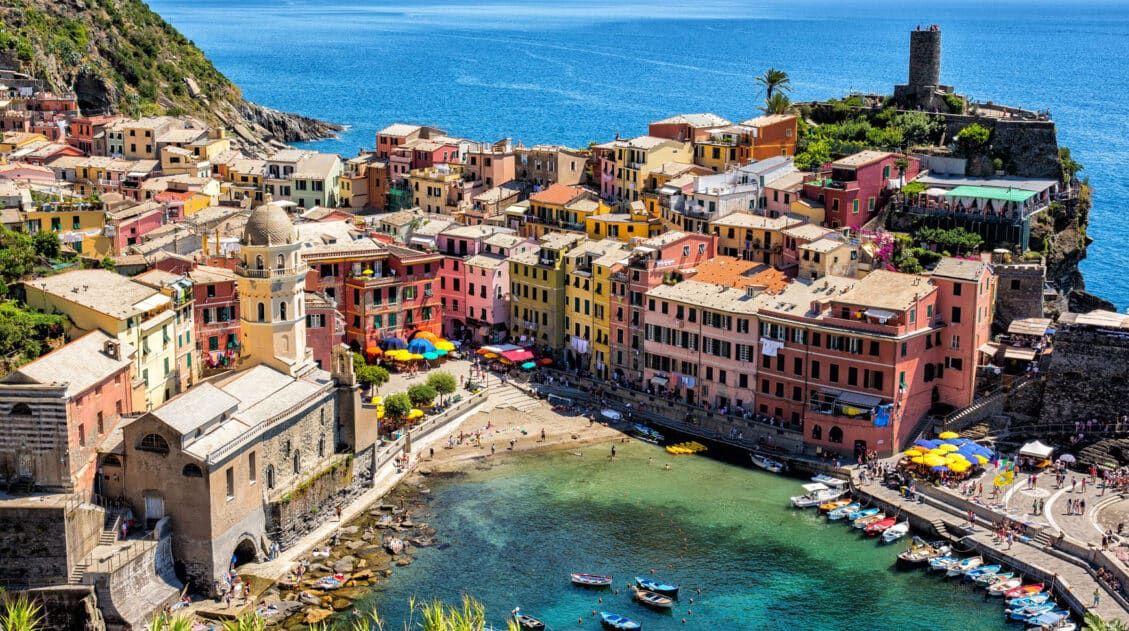
Comments 16